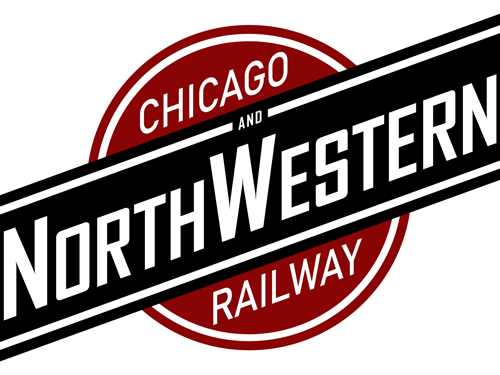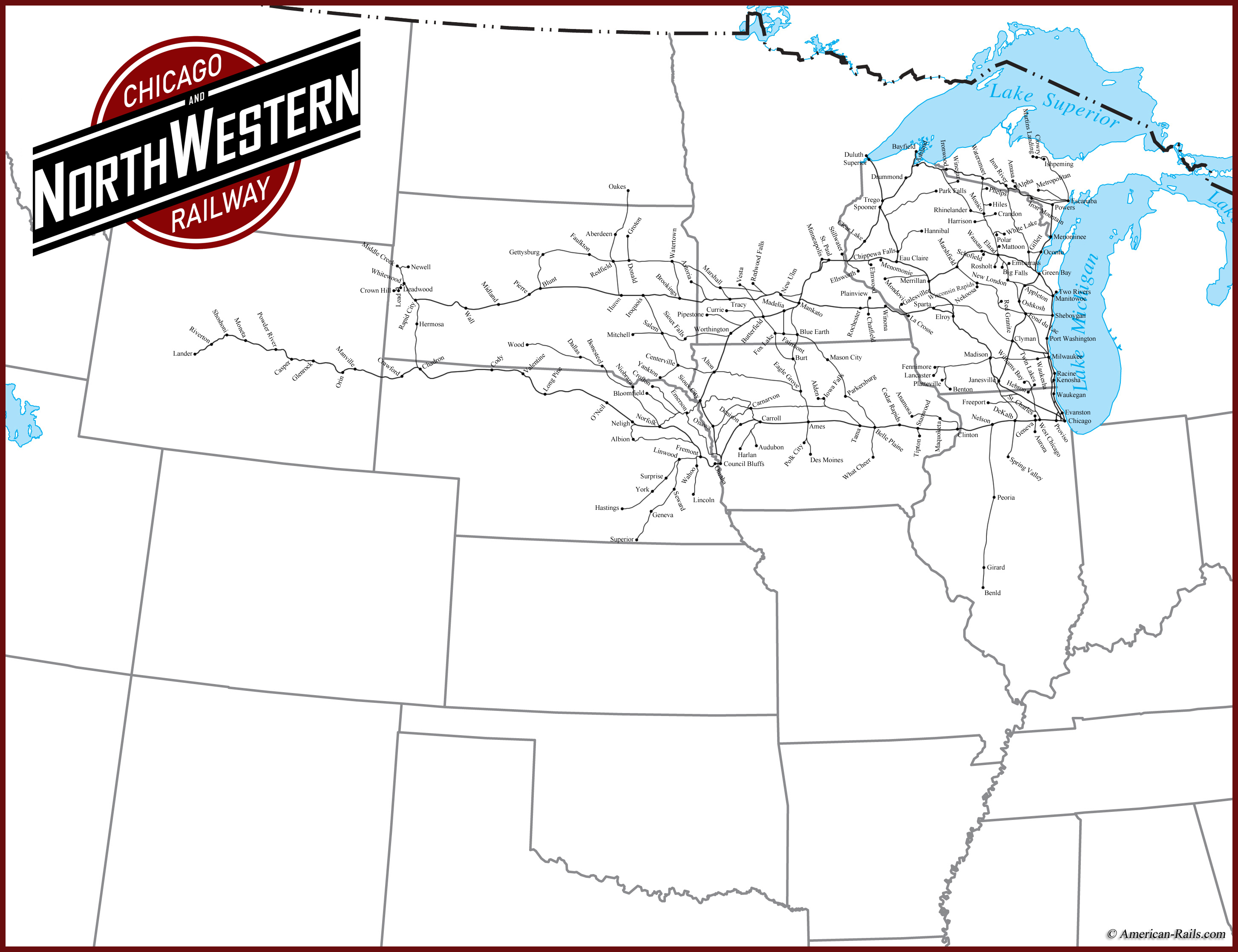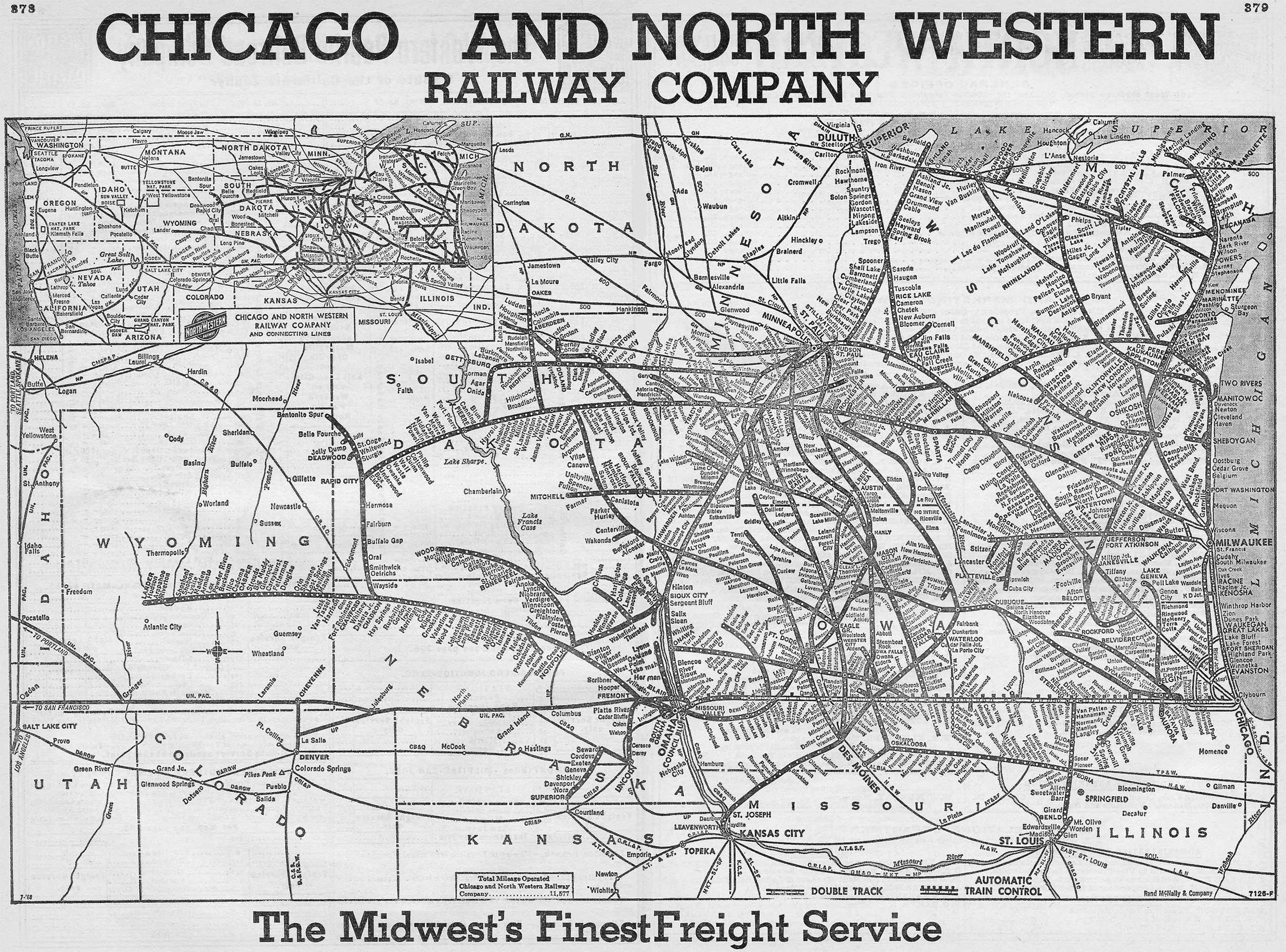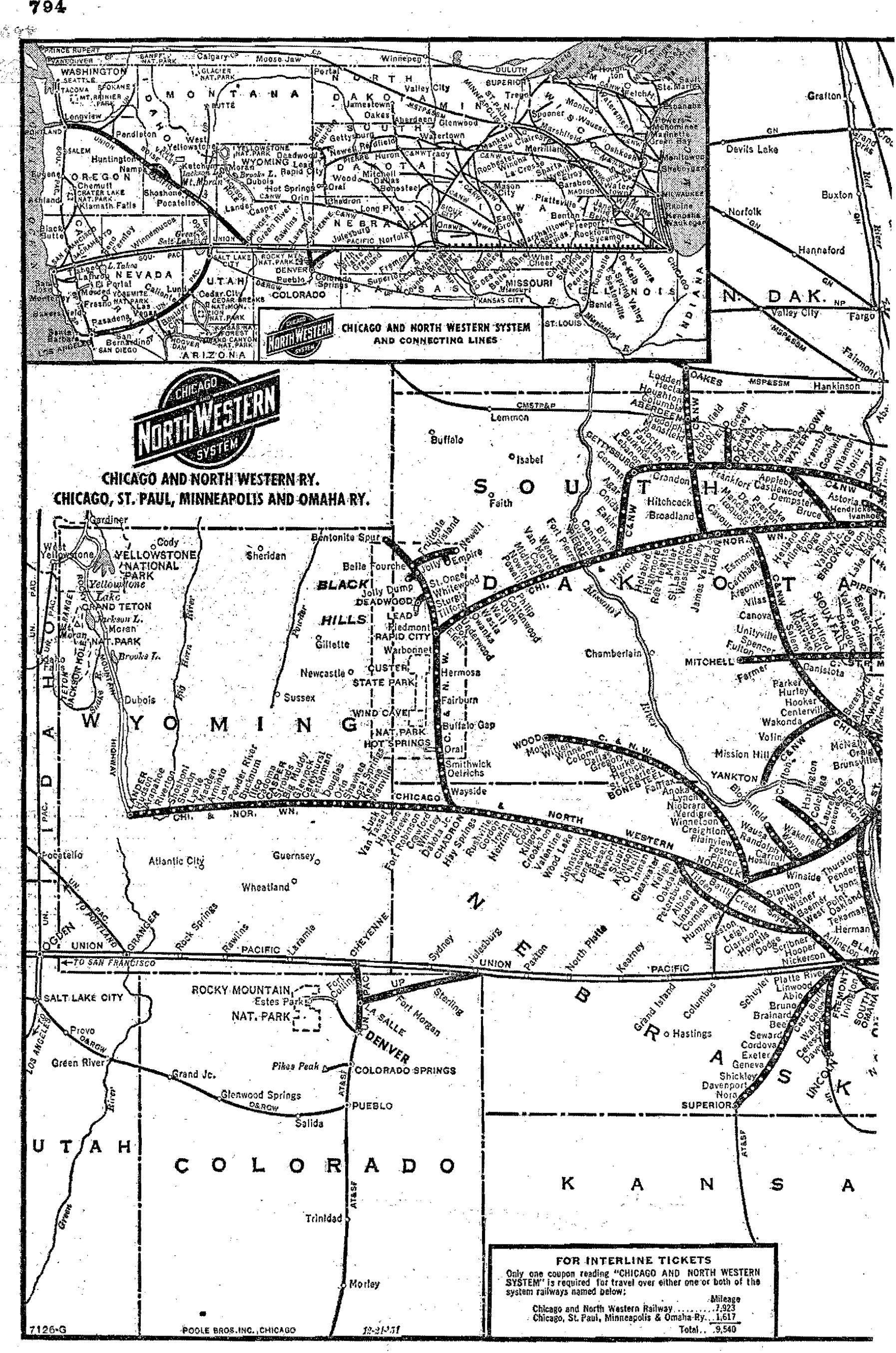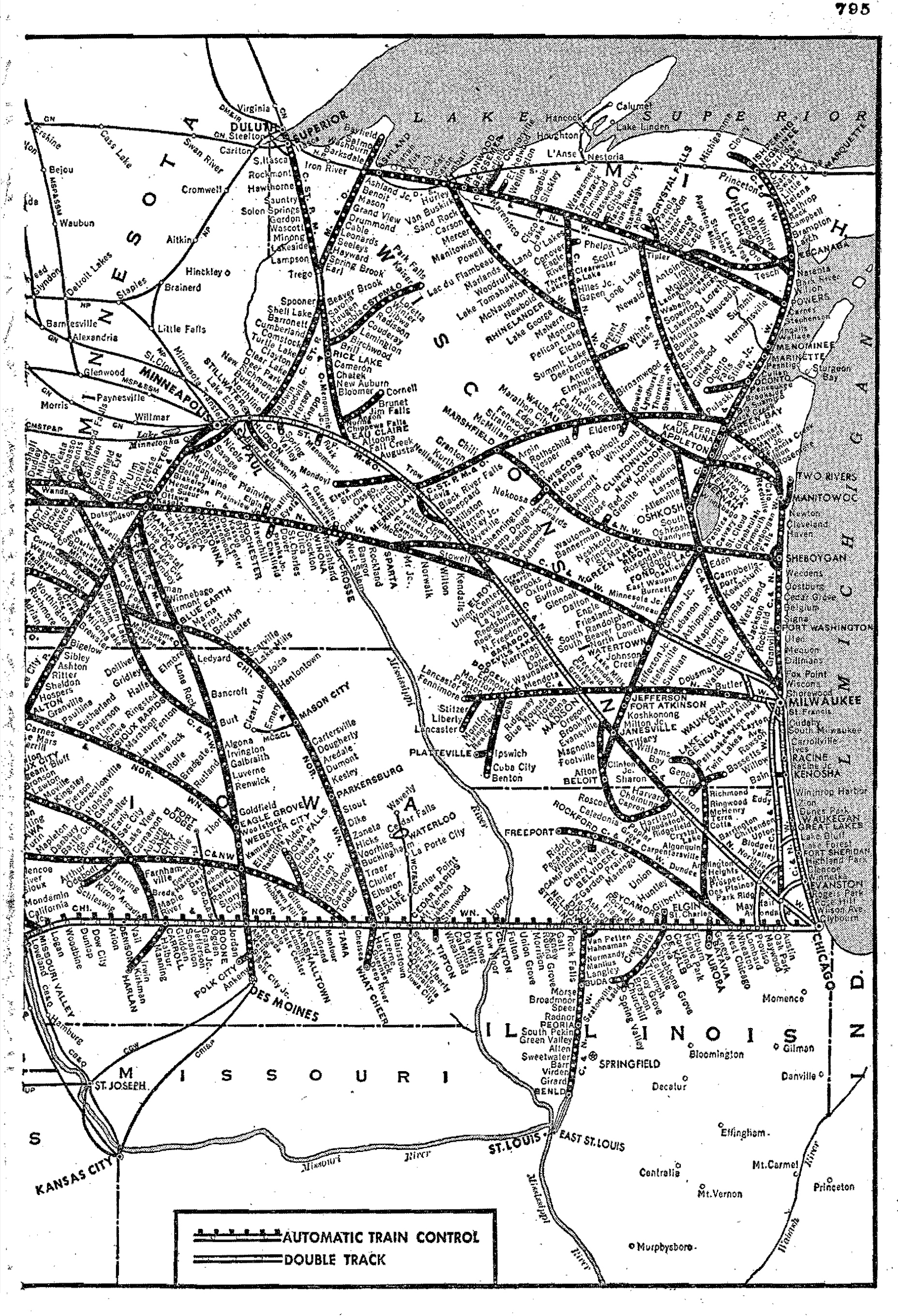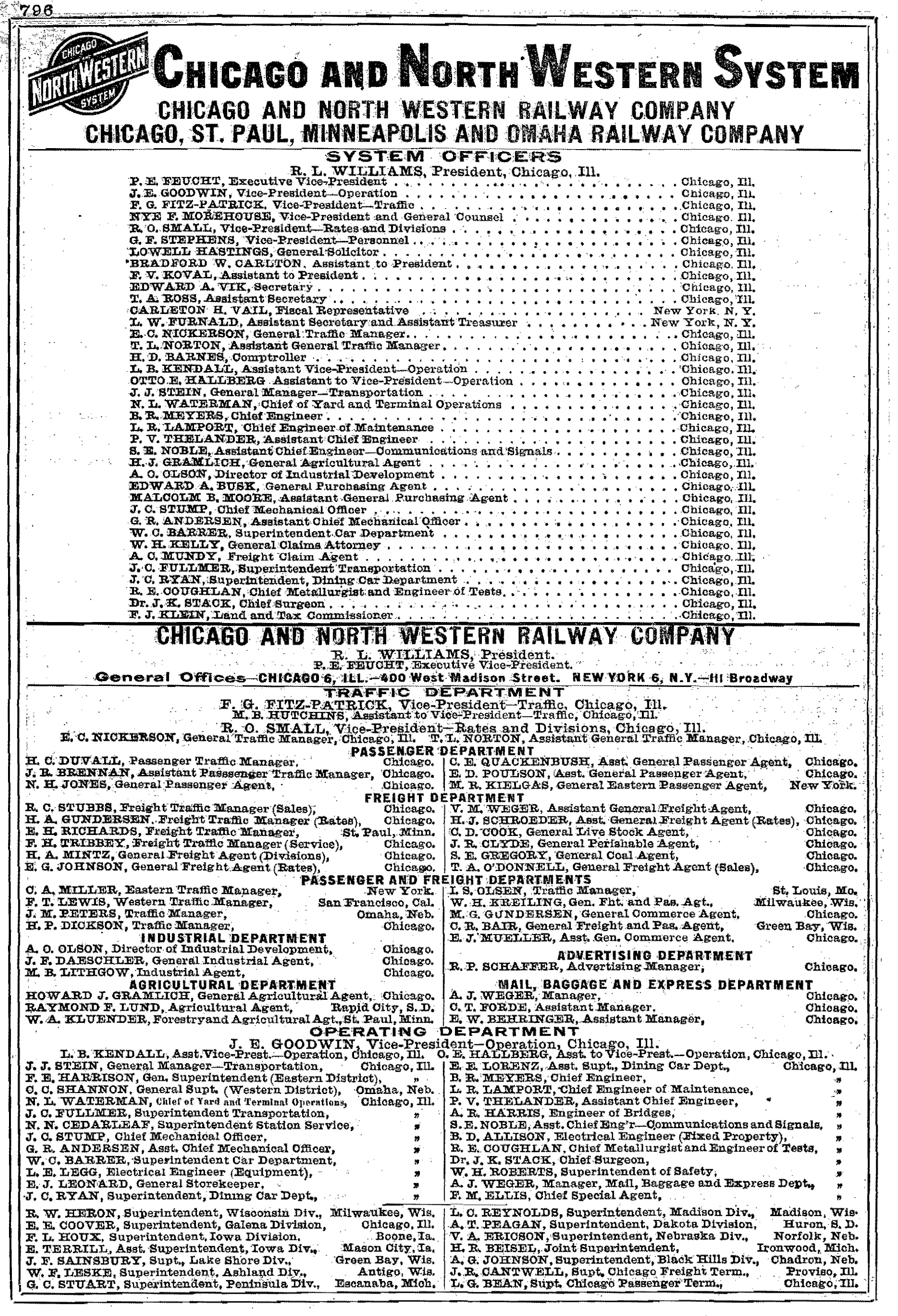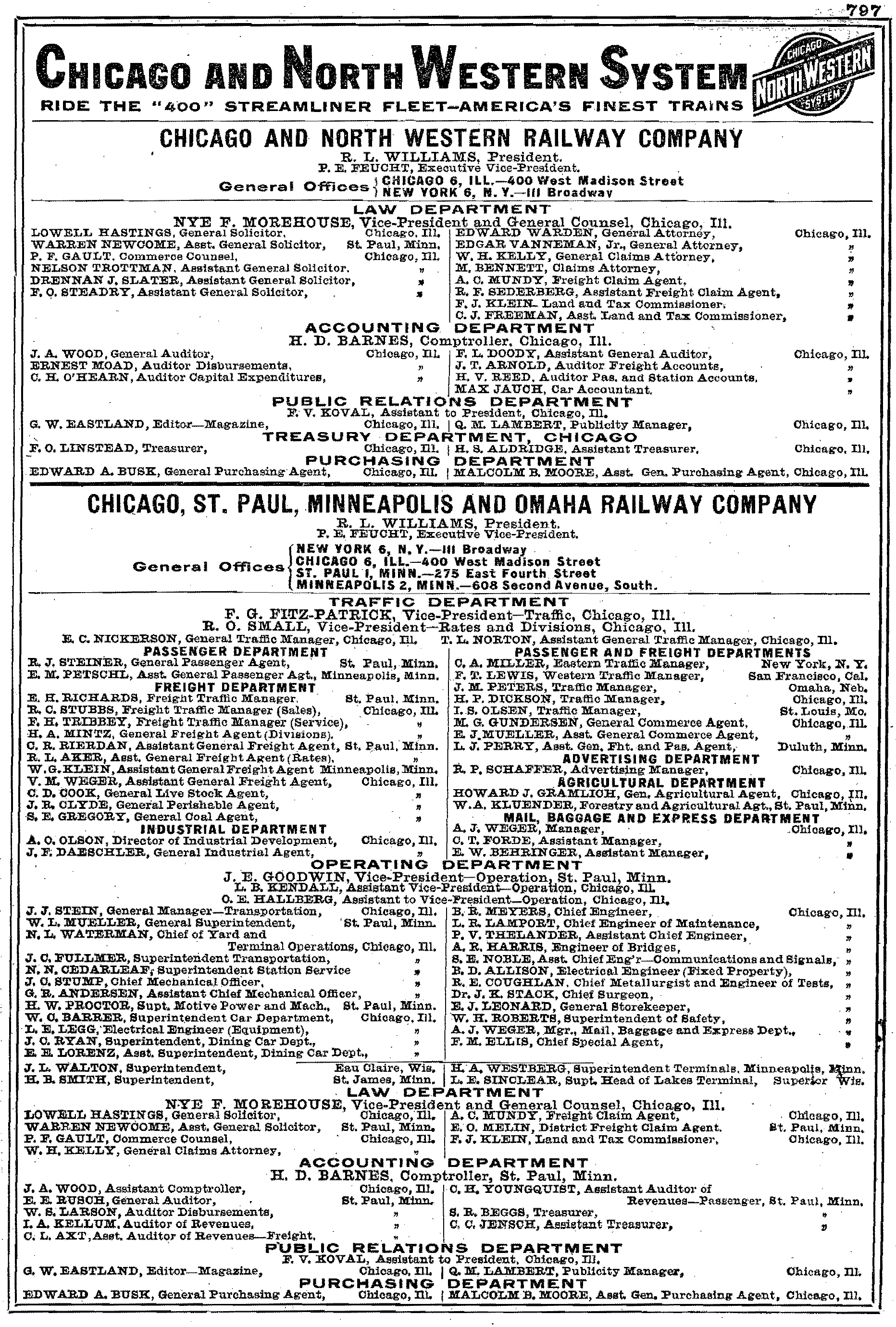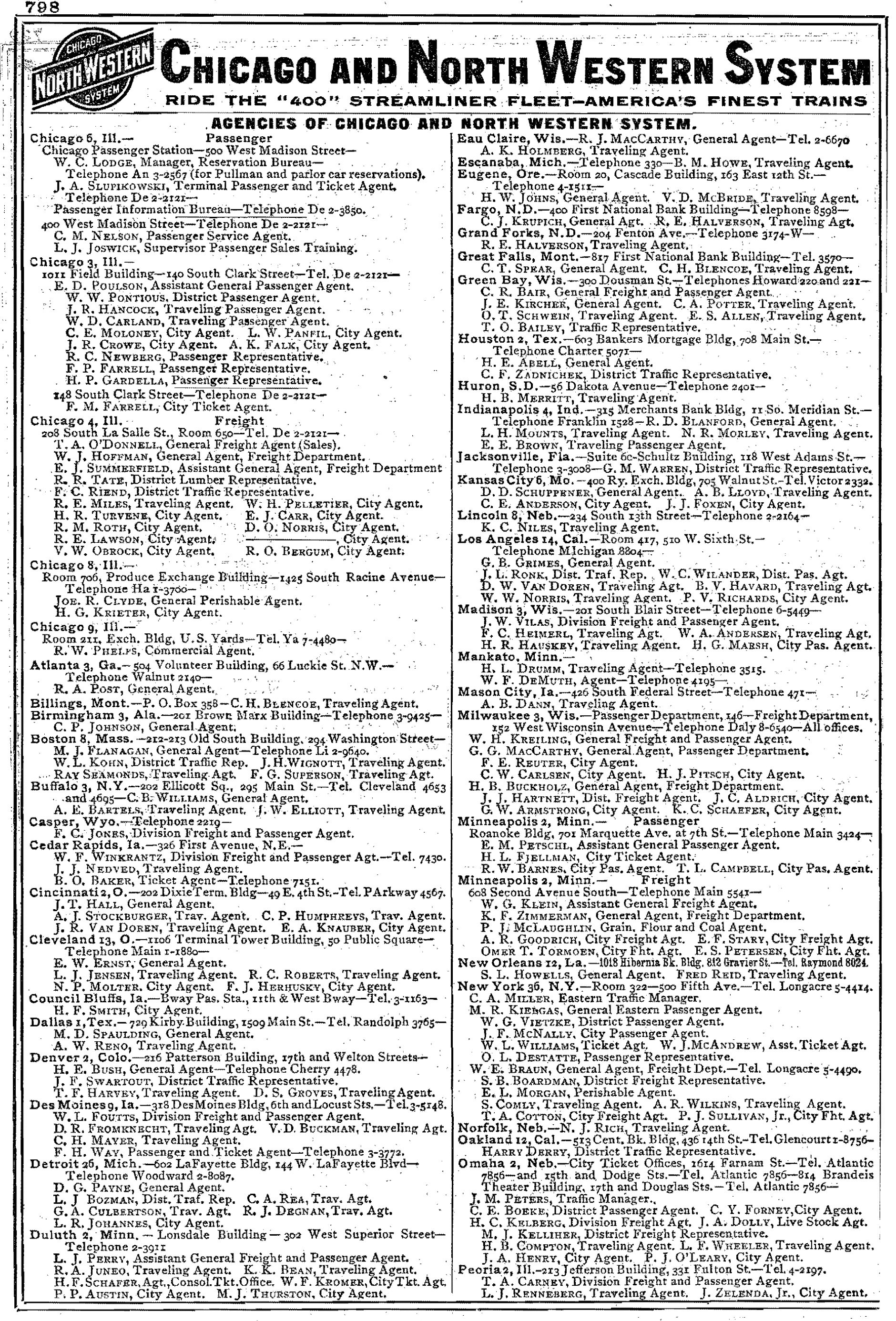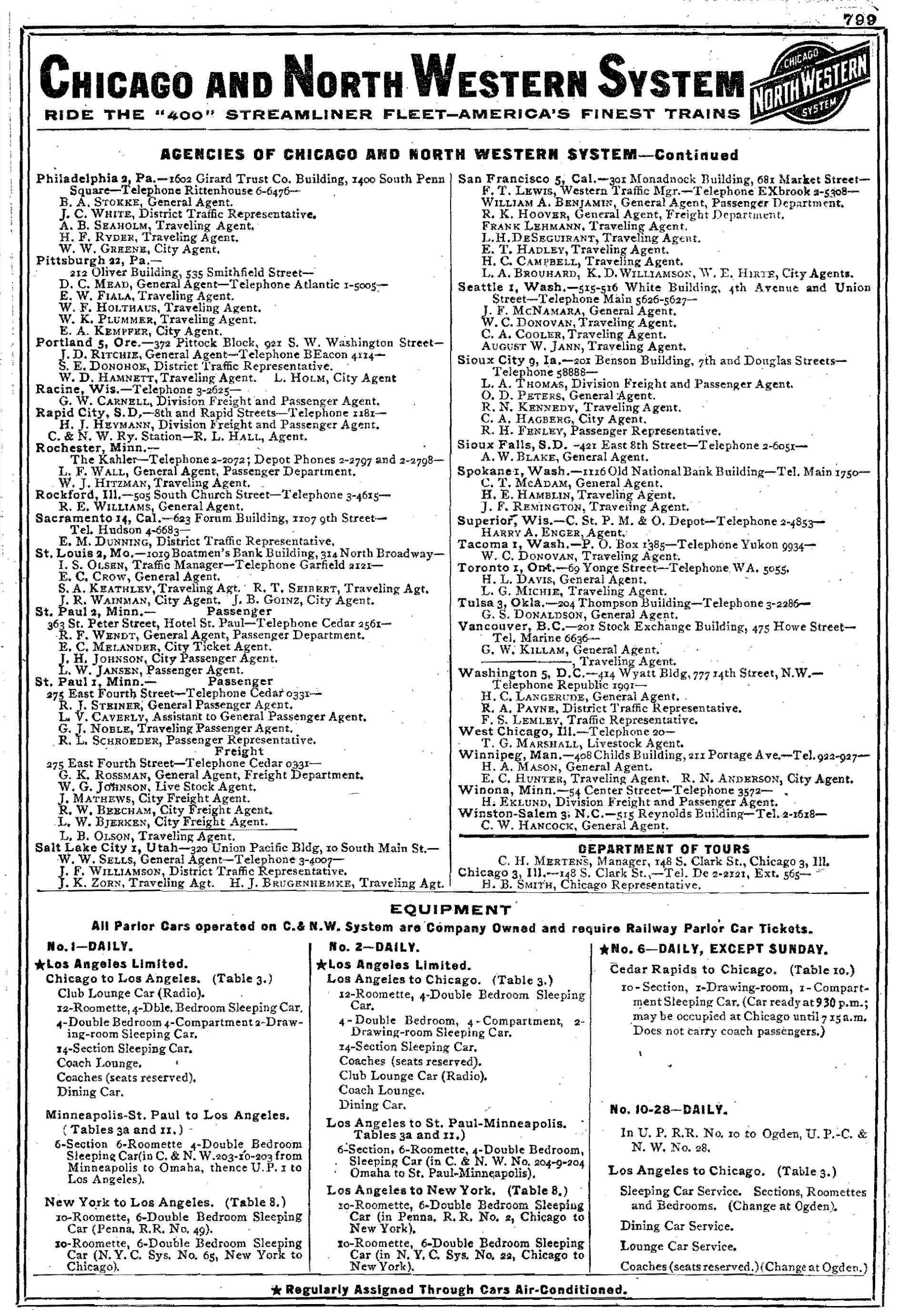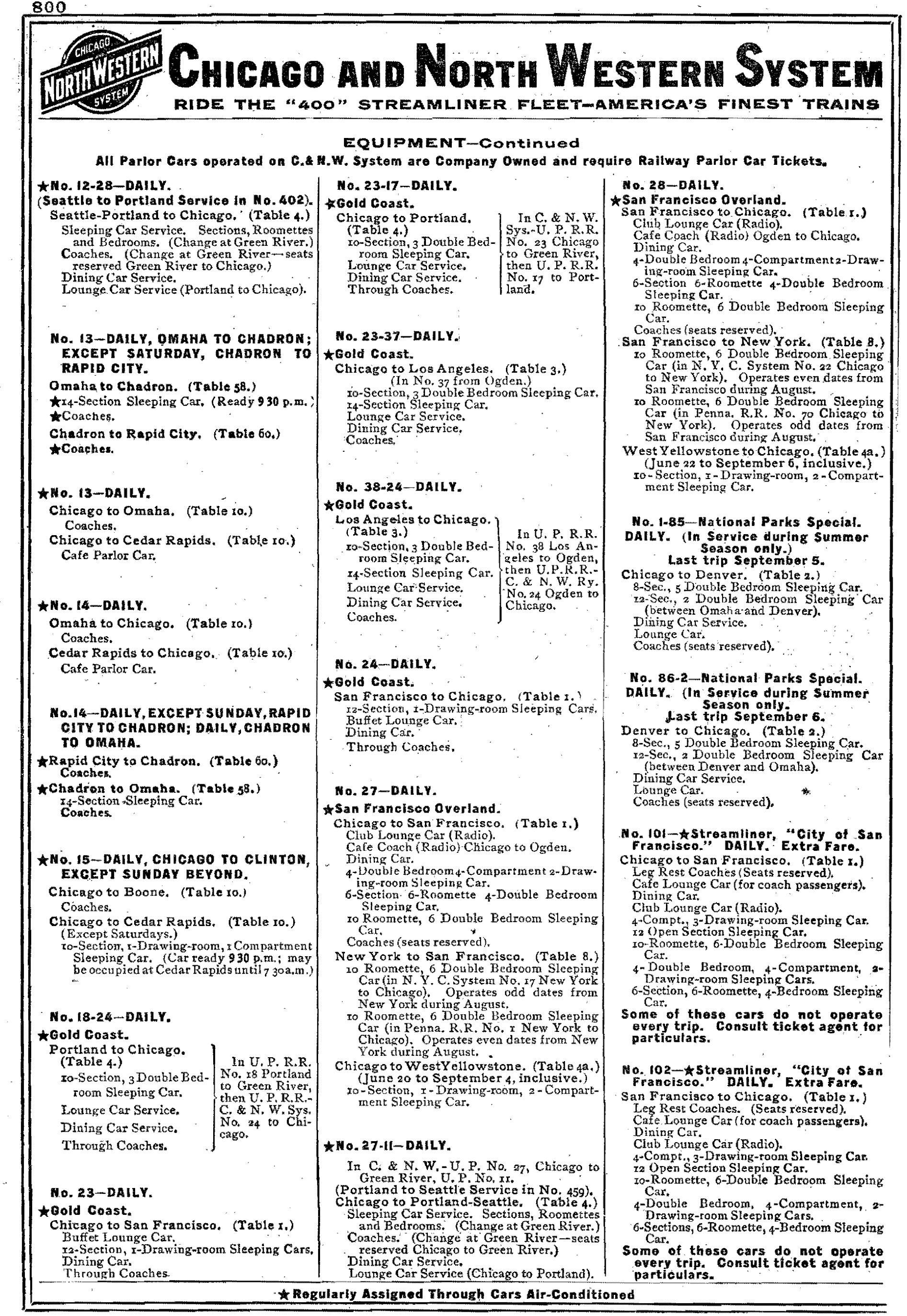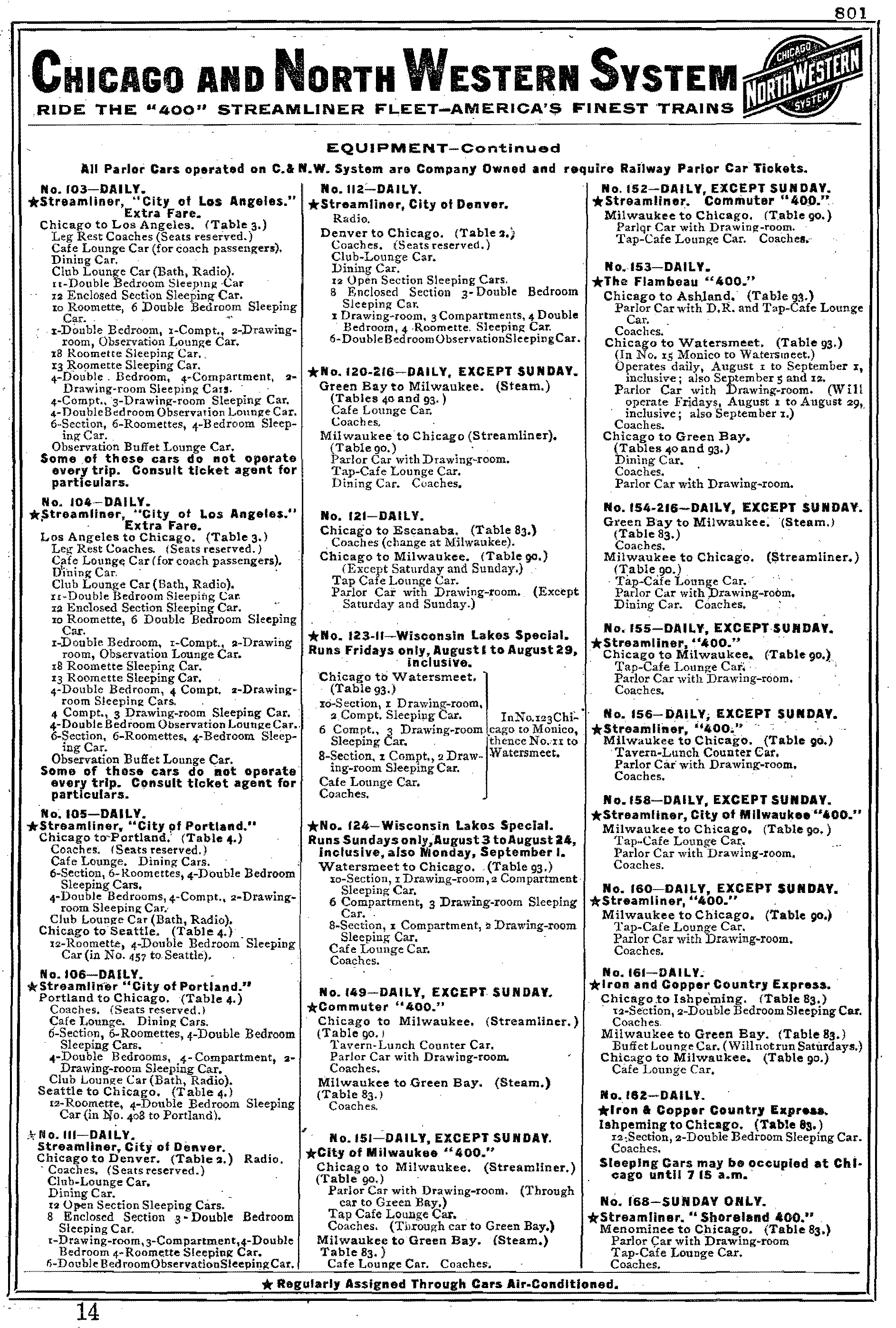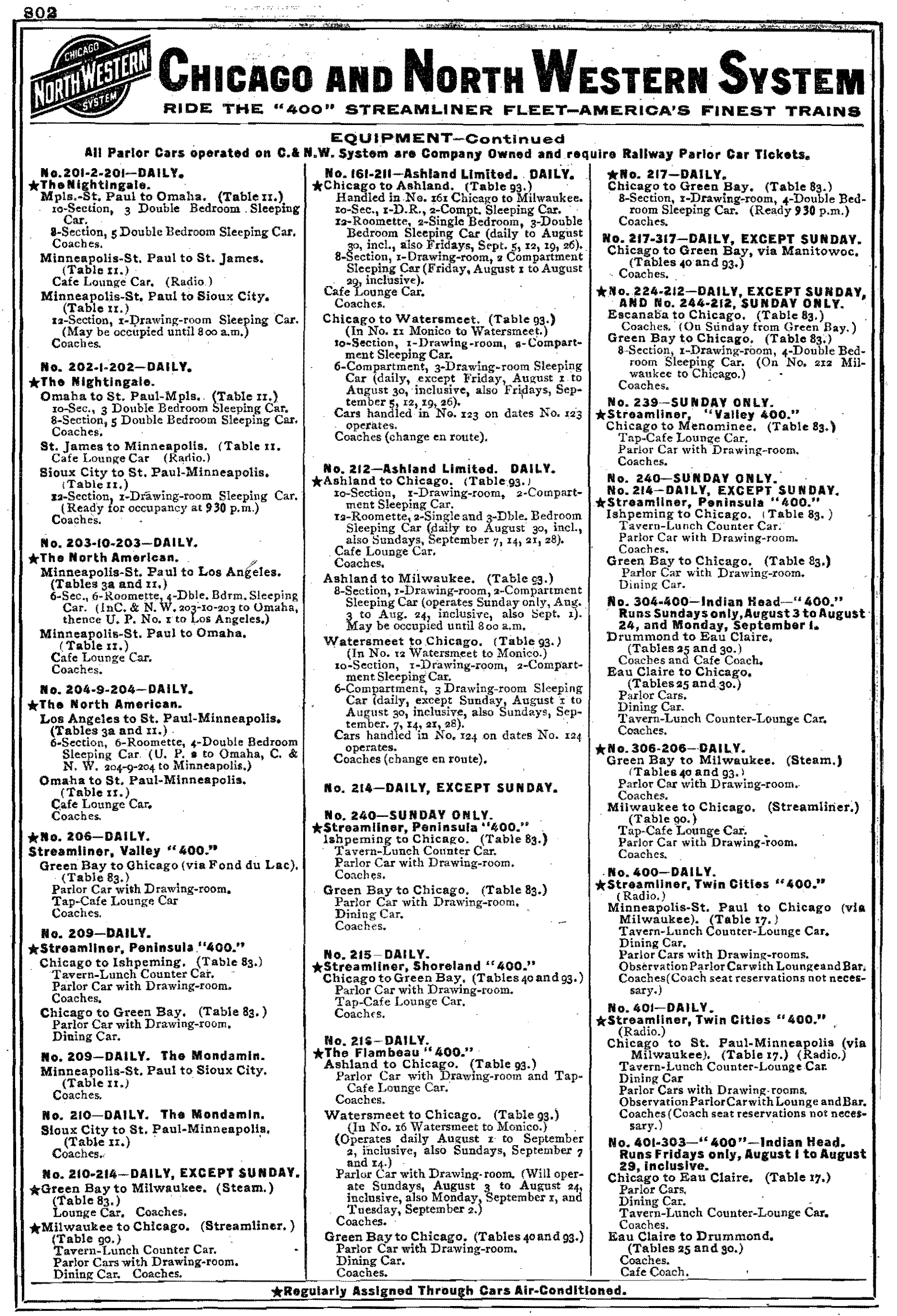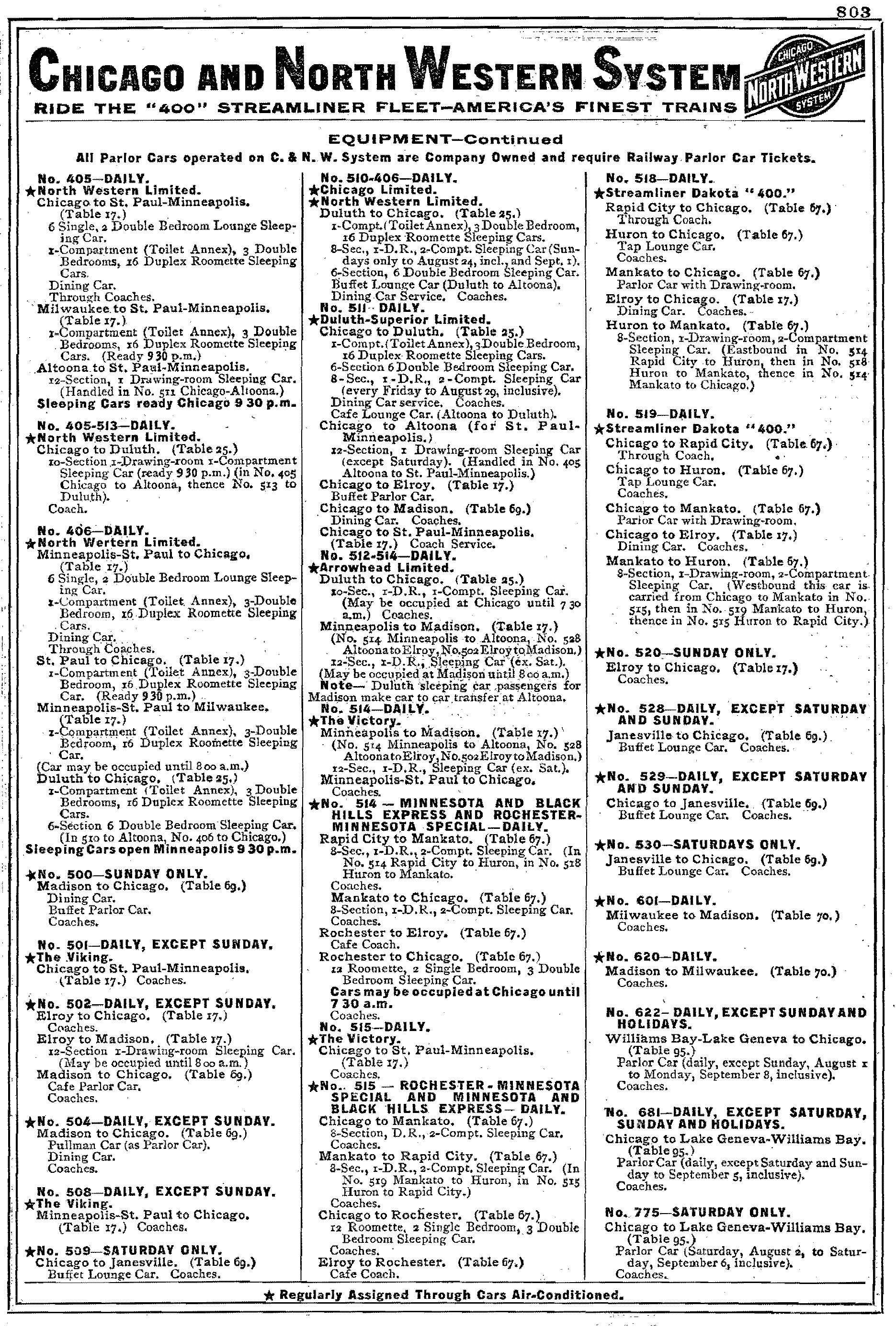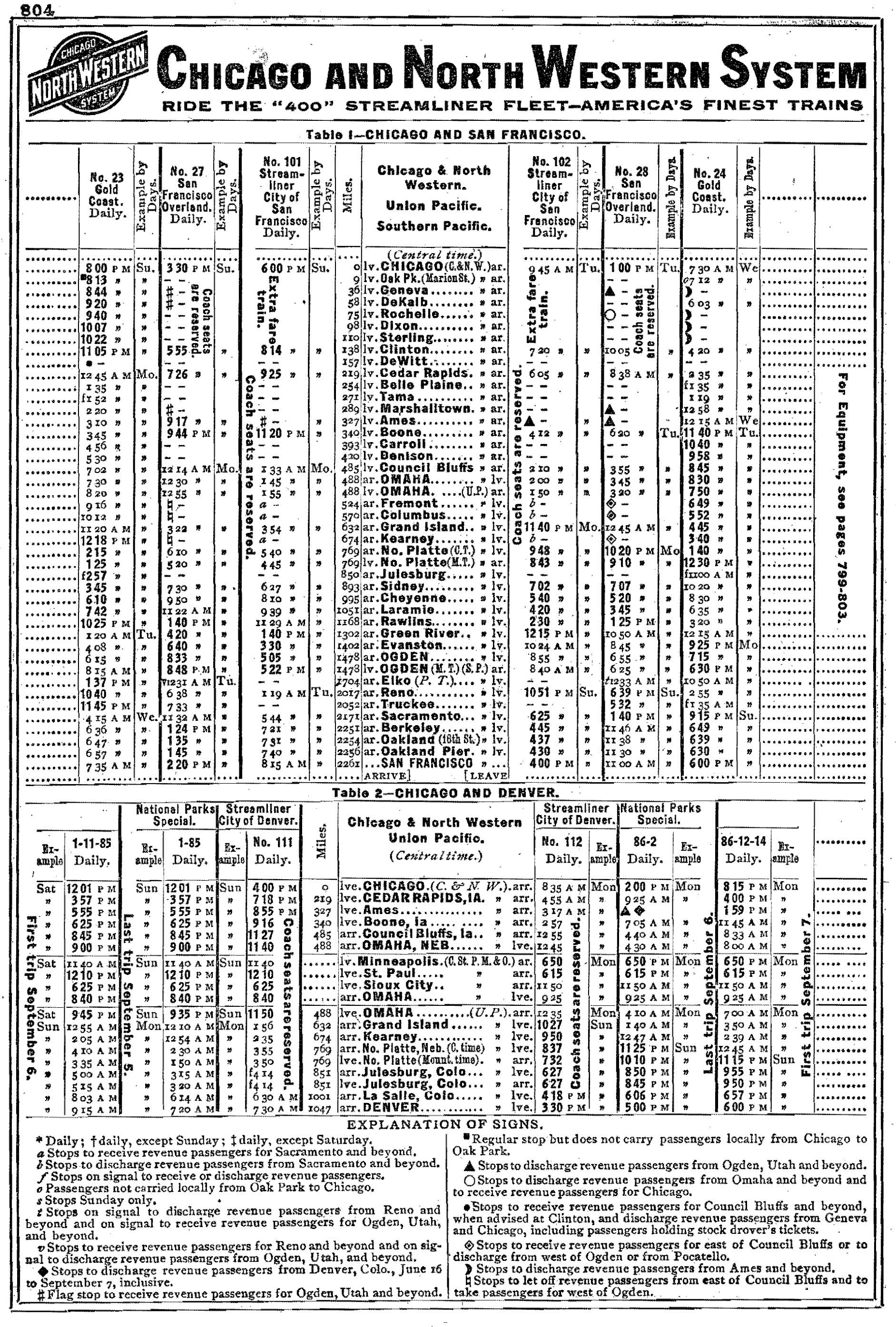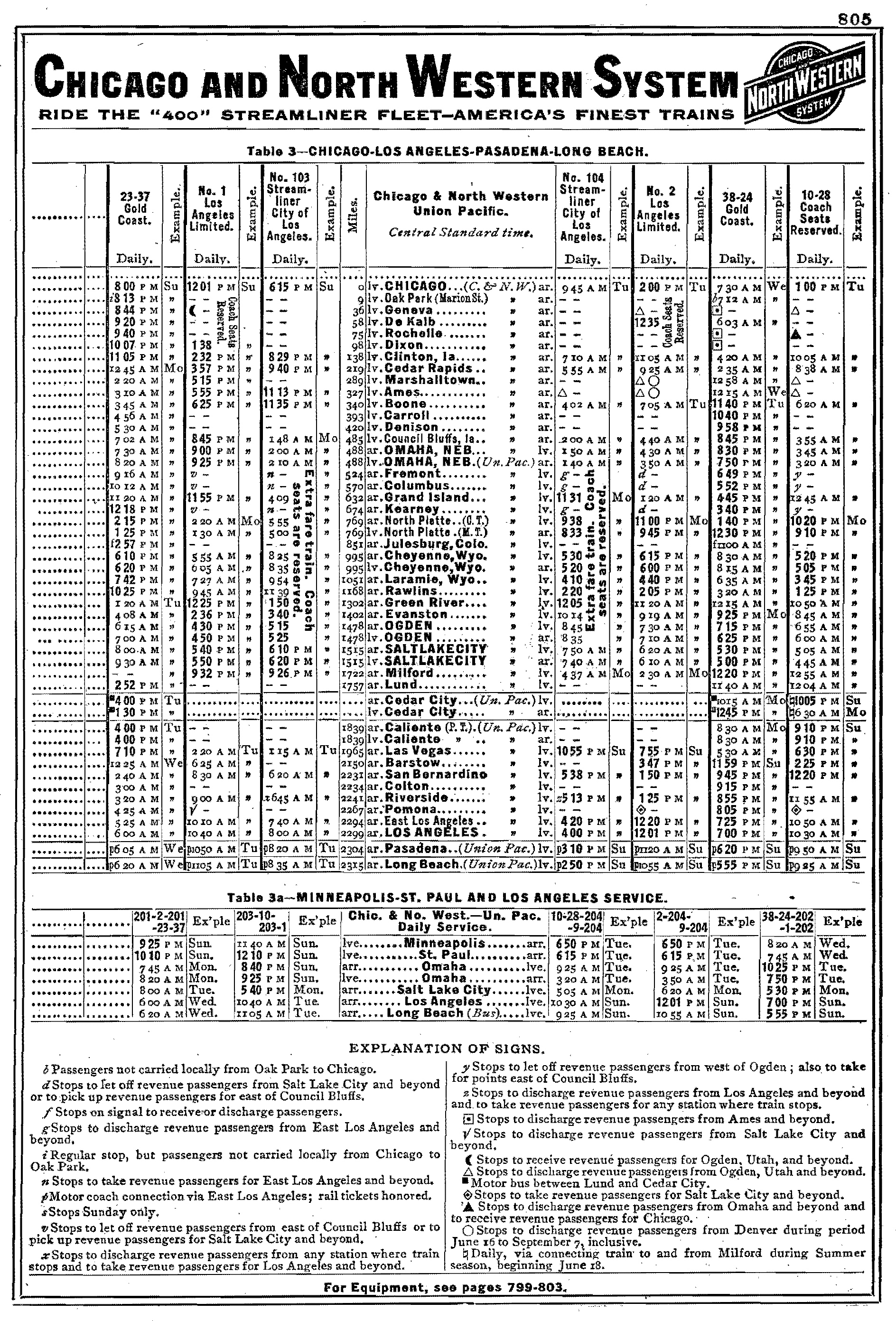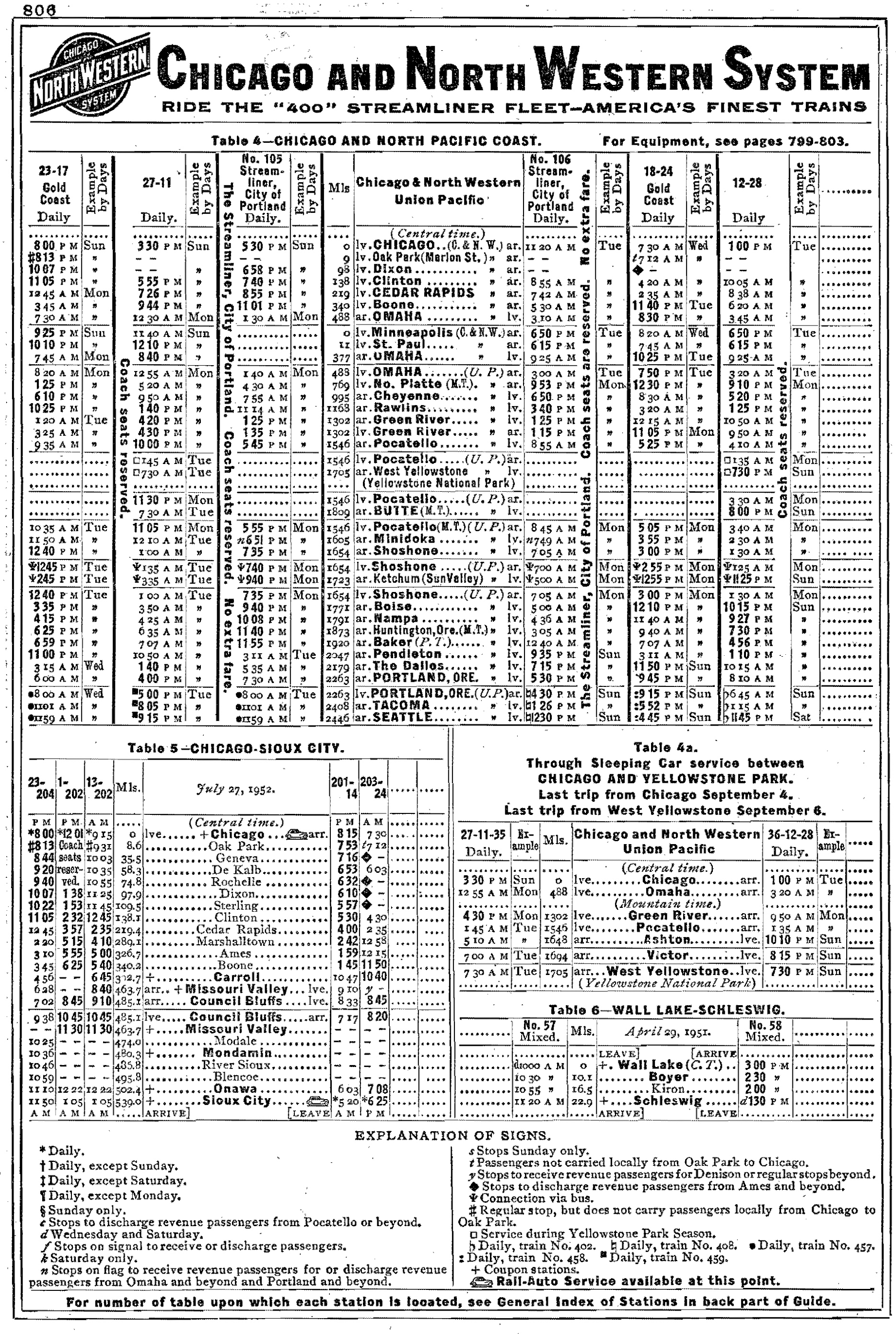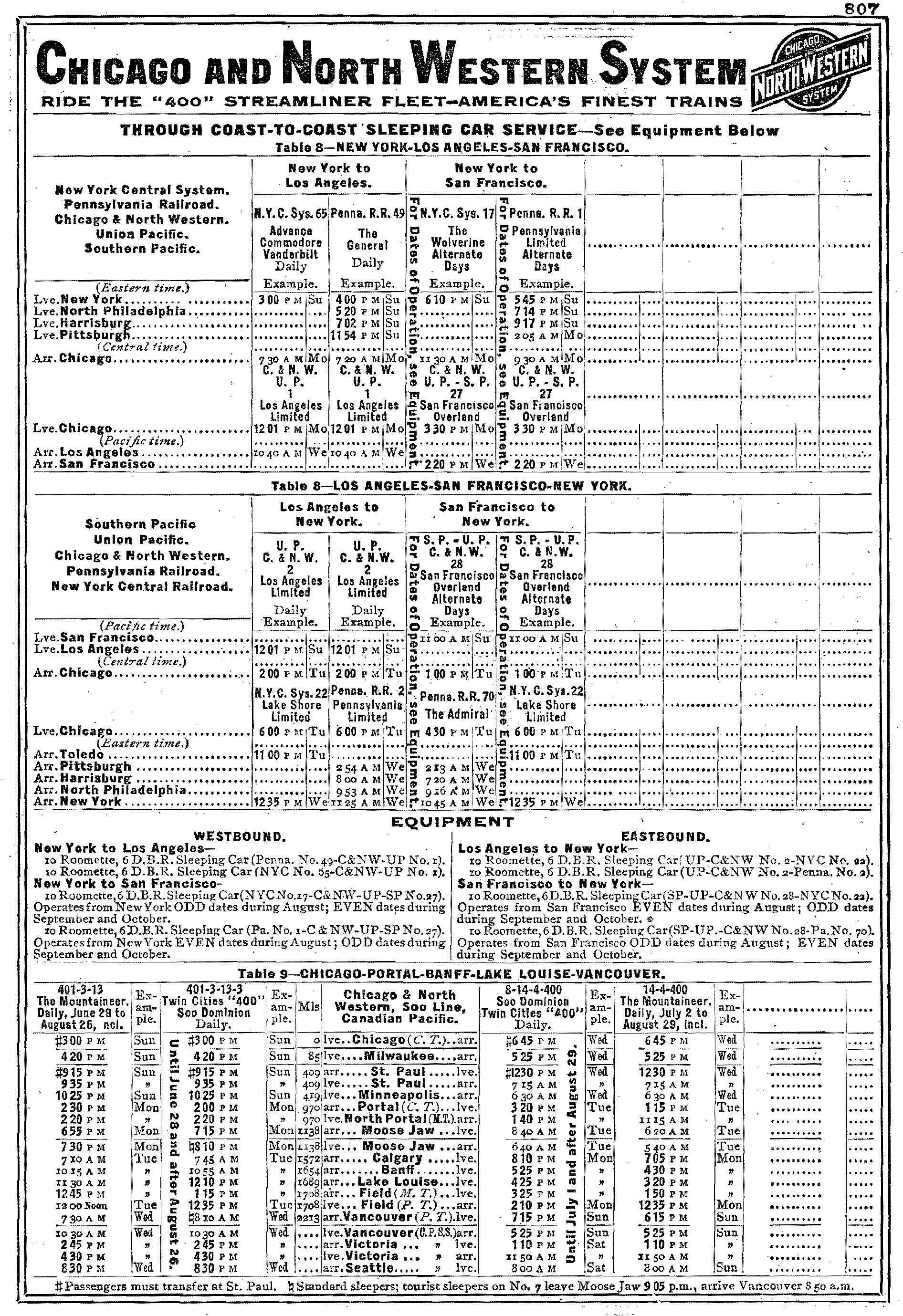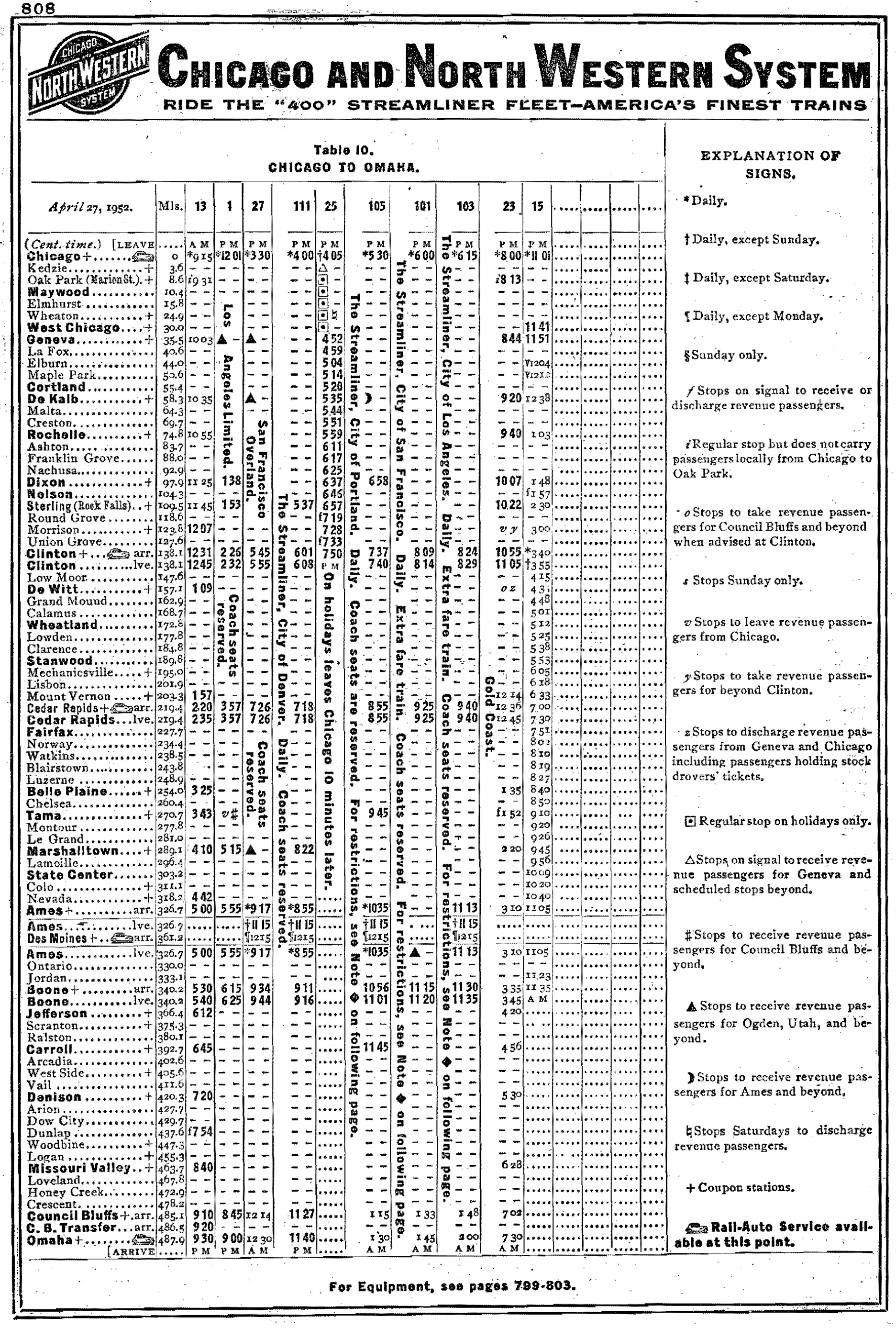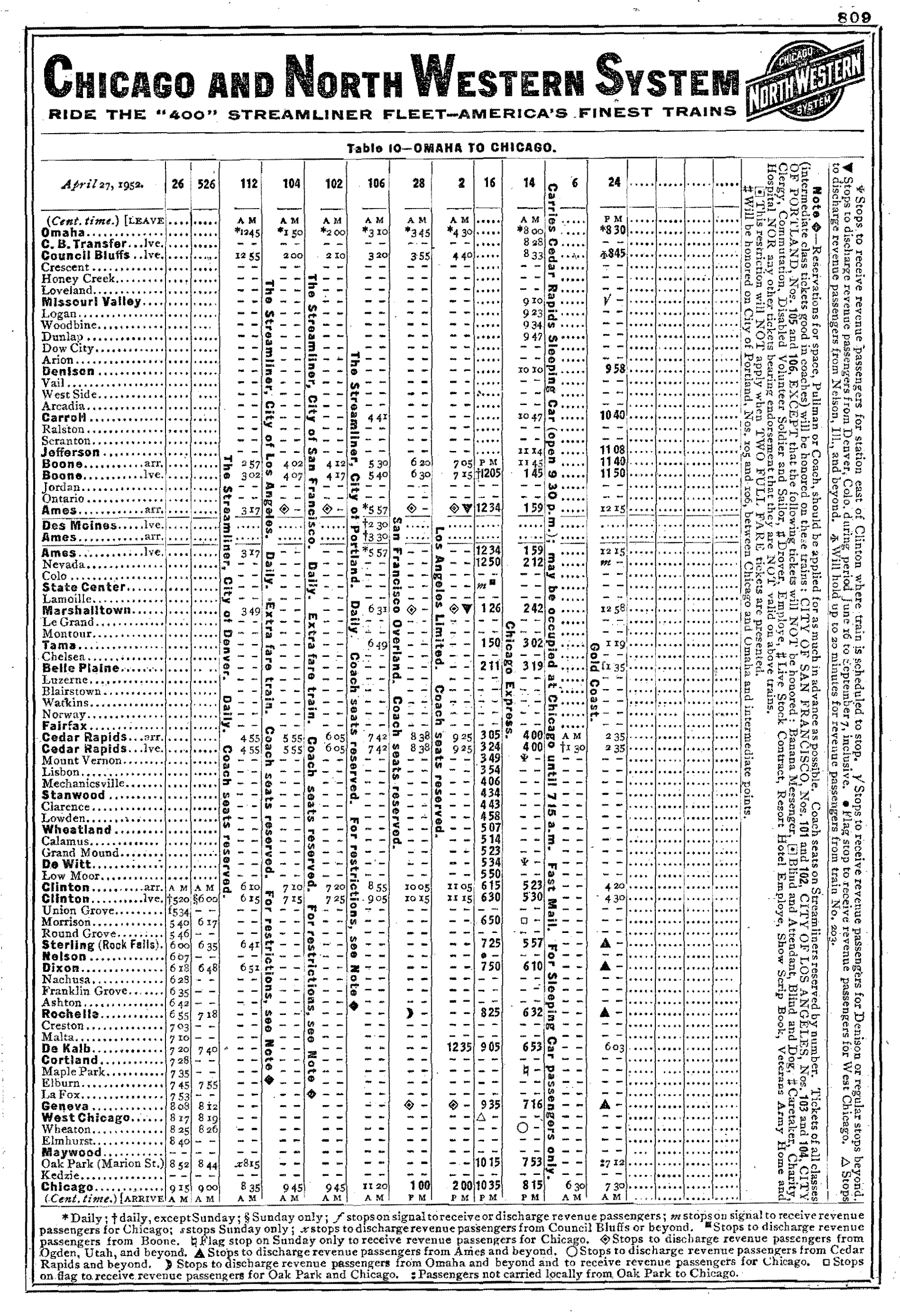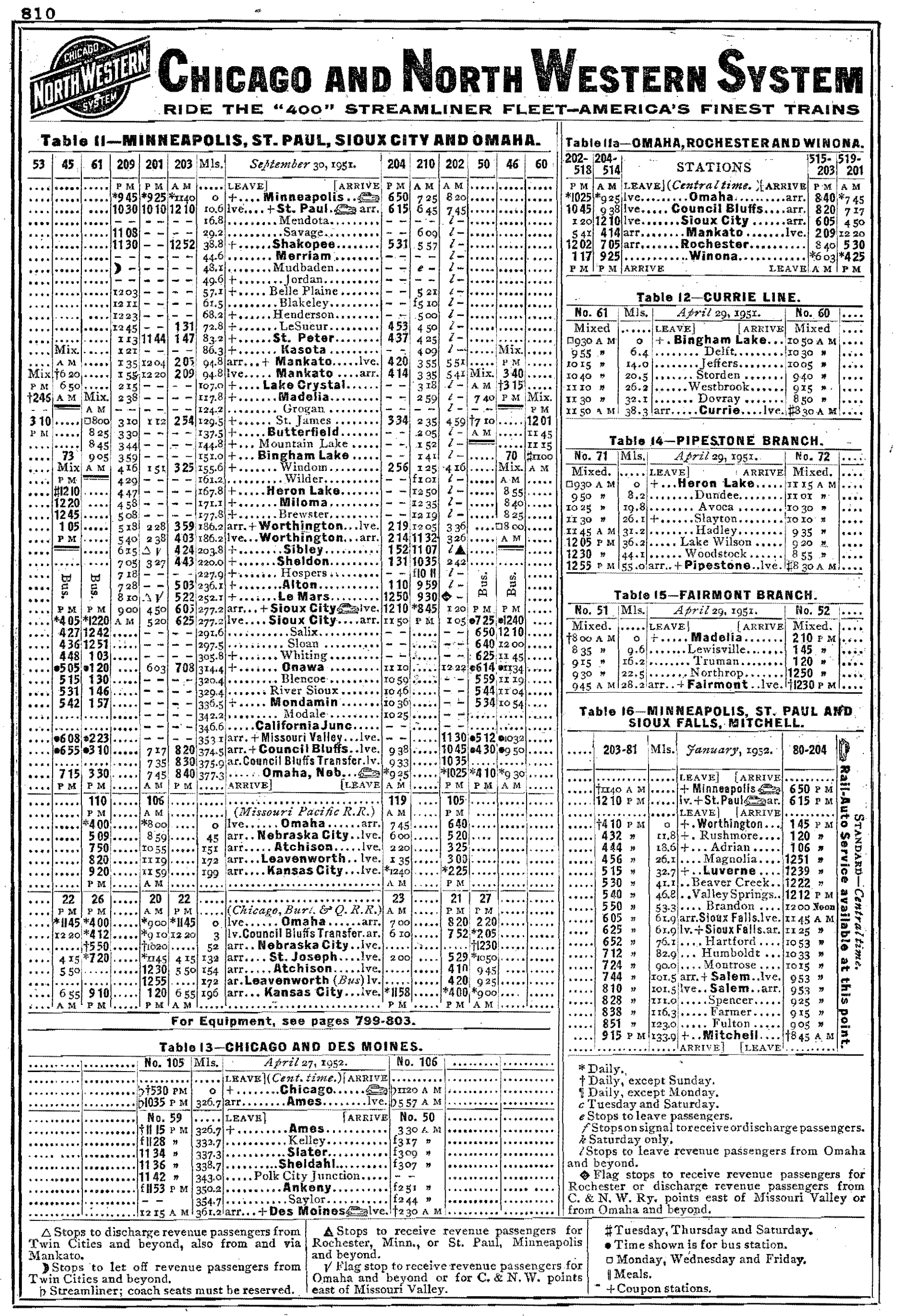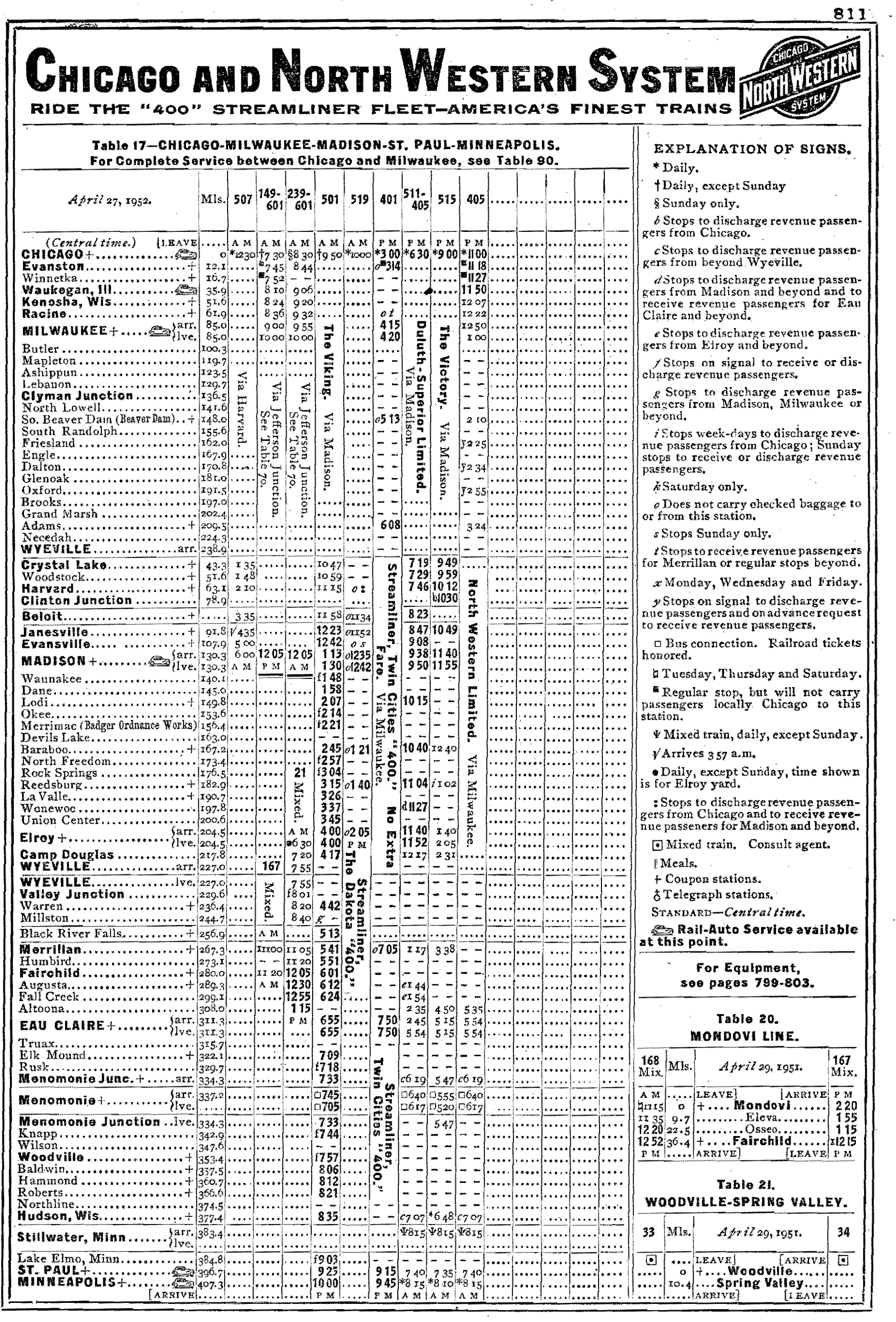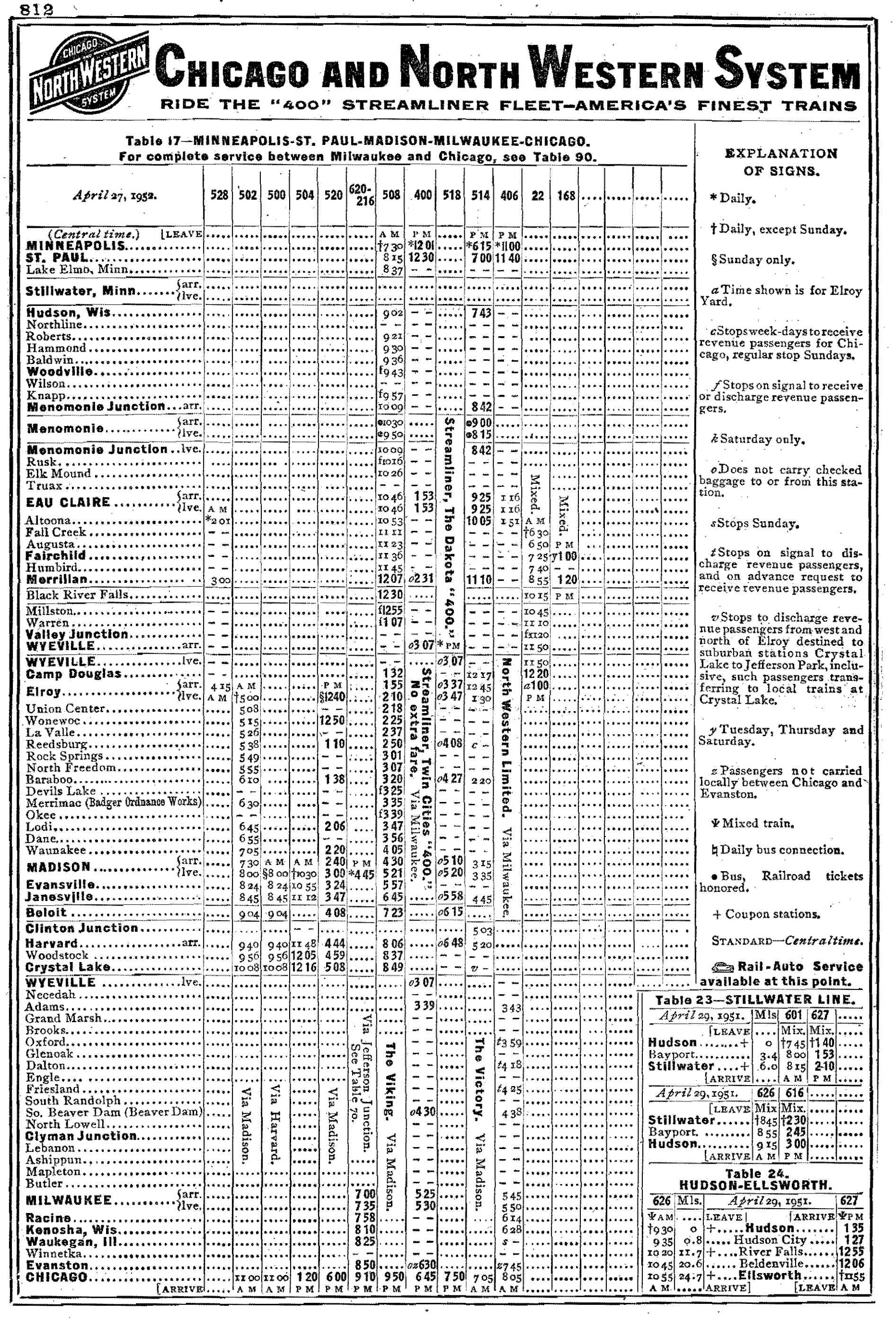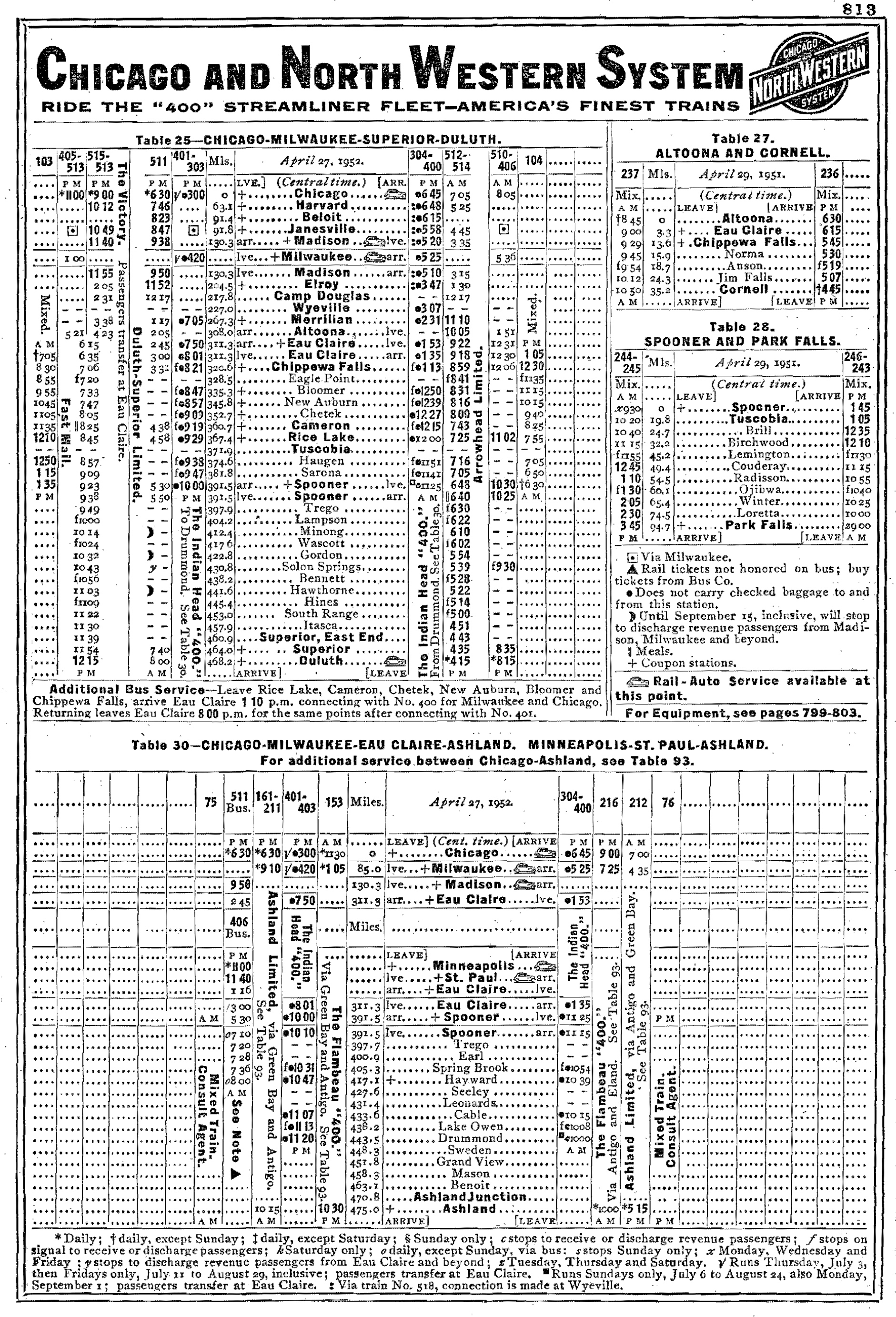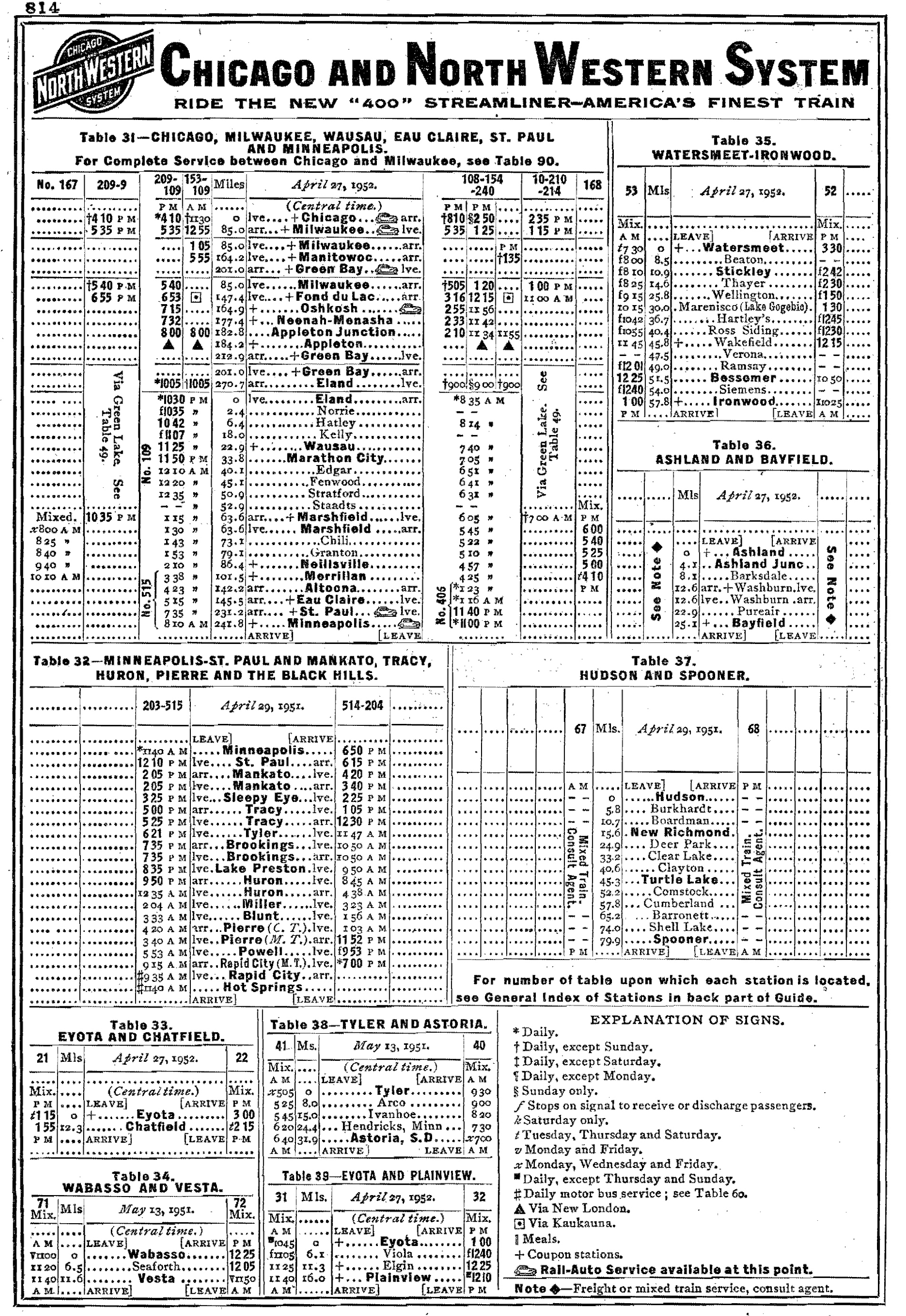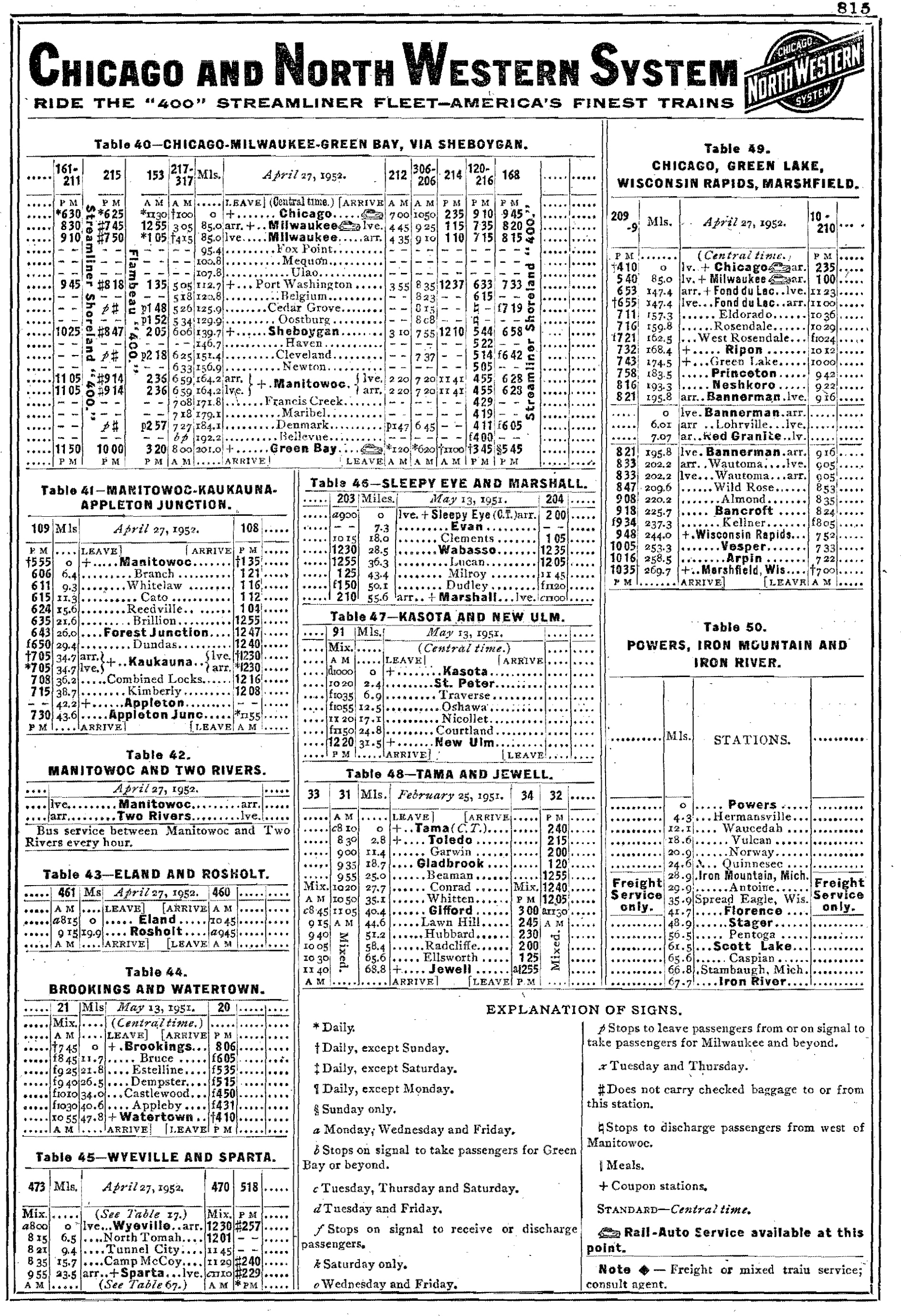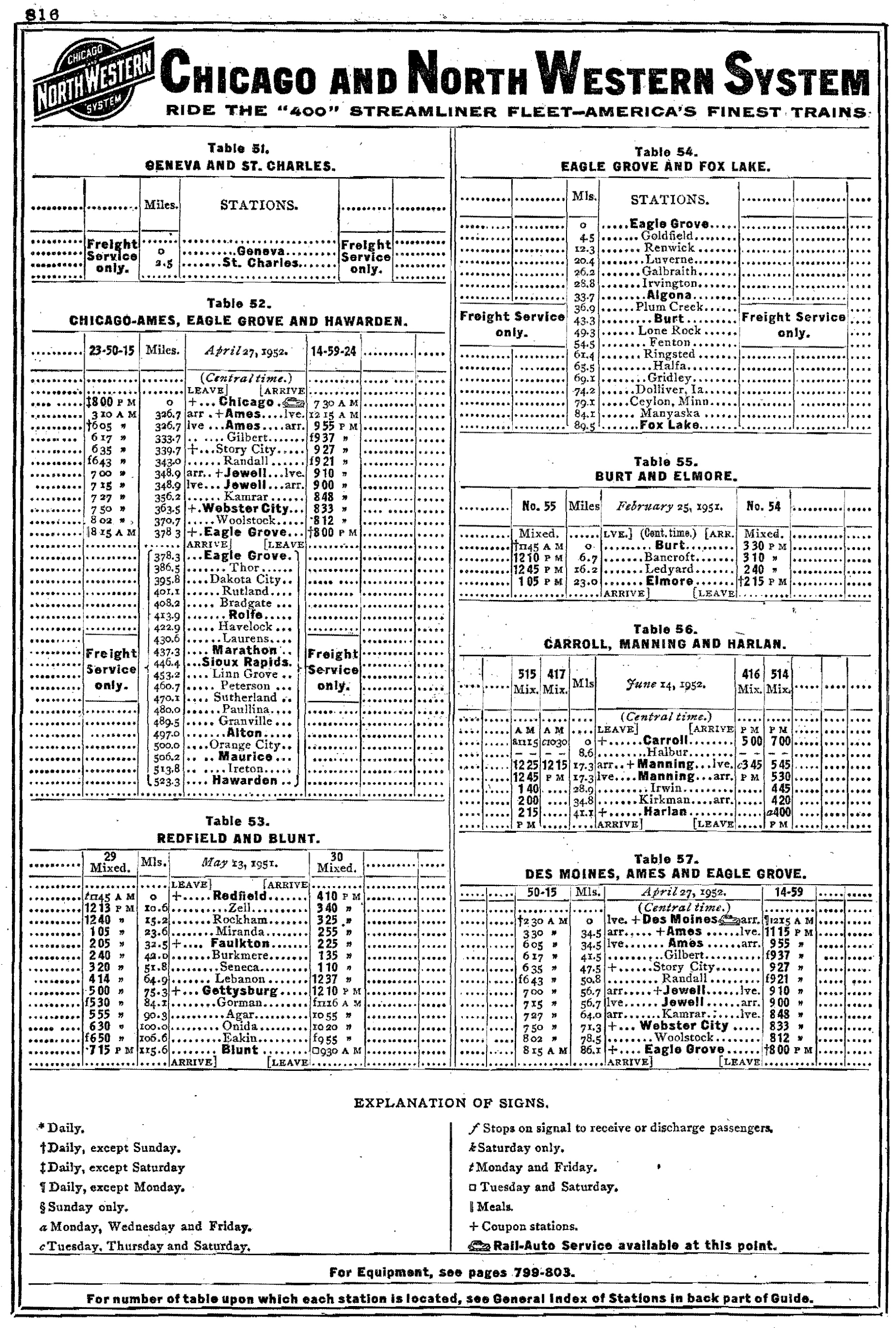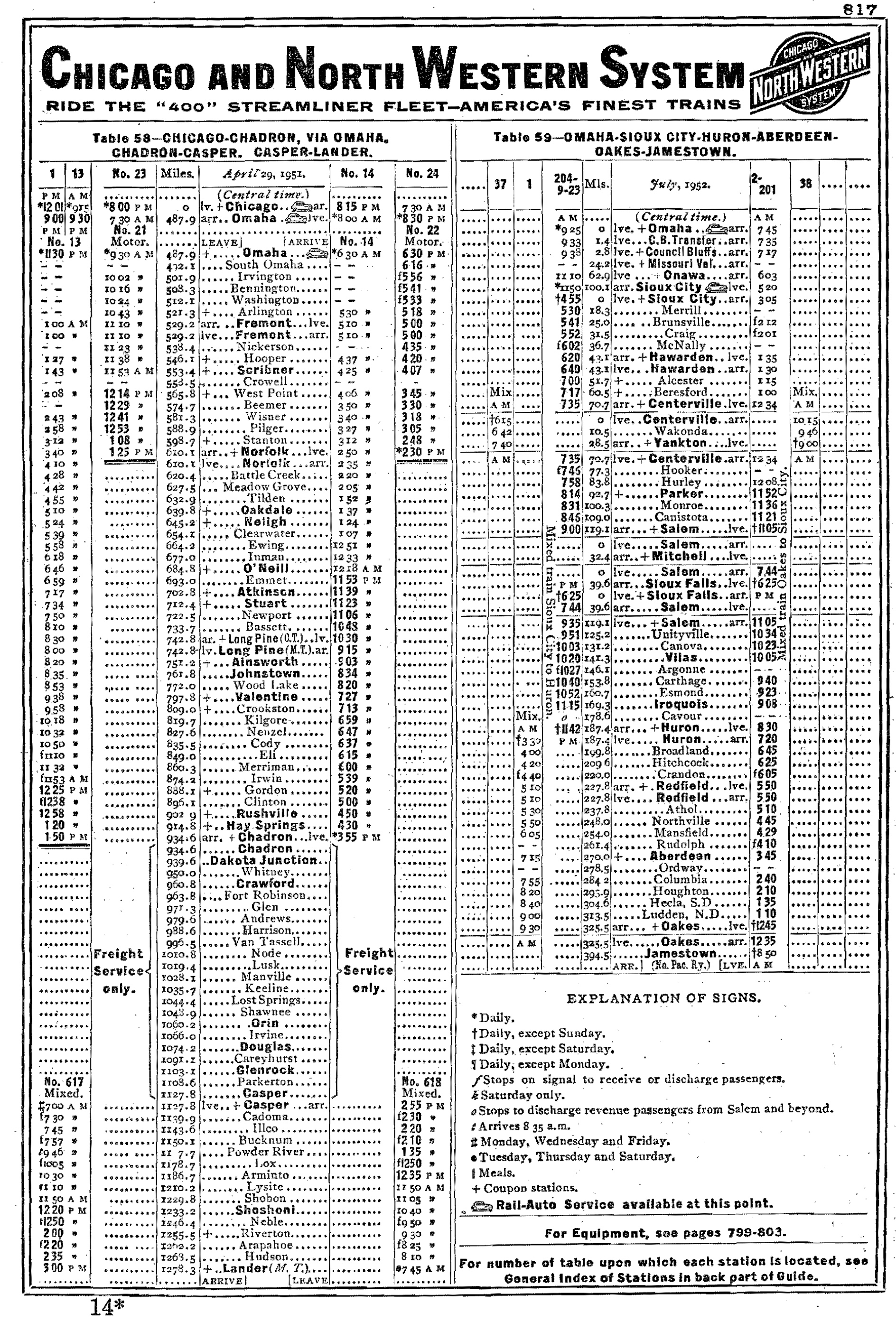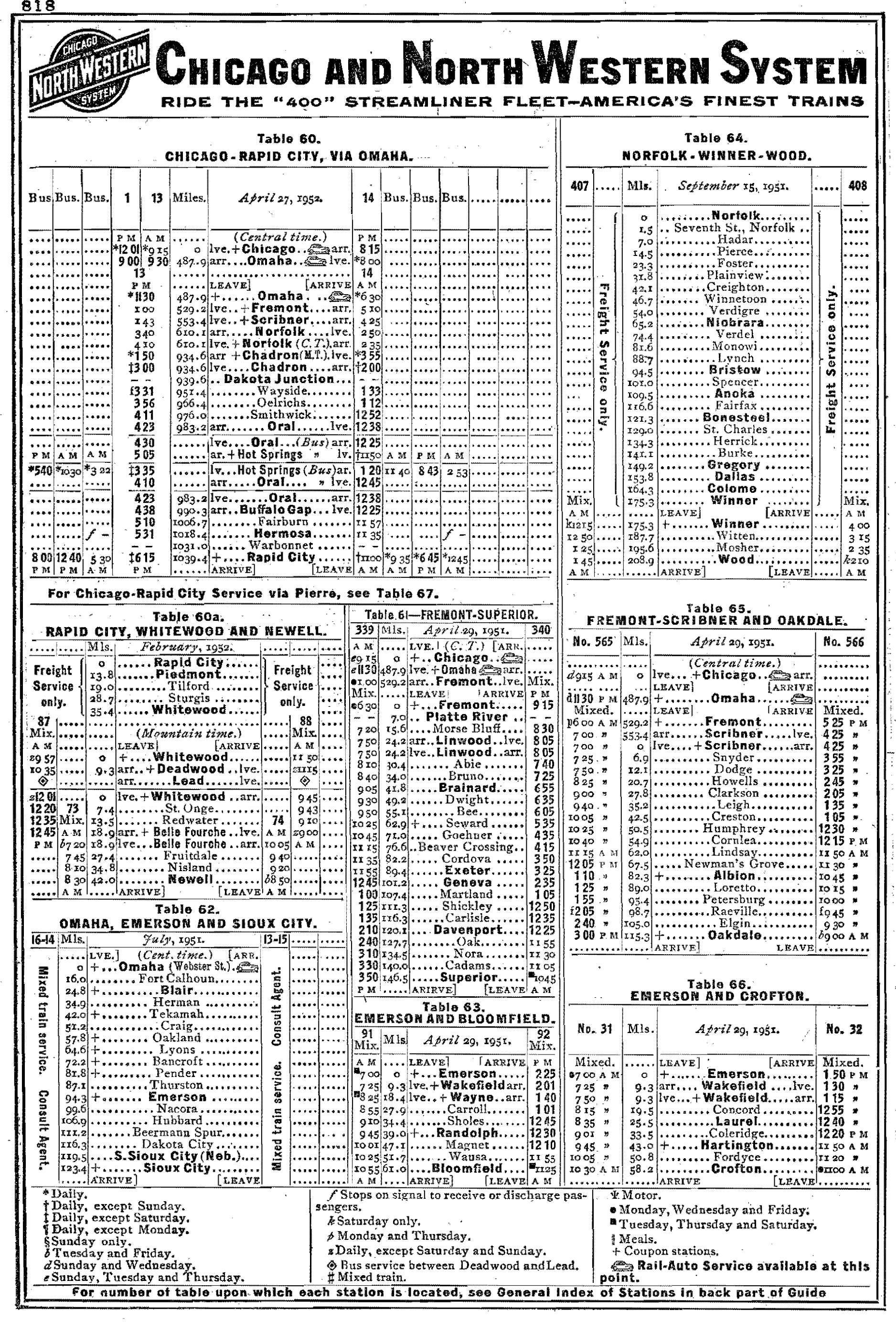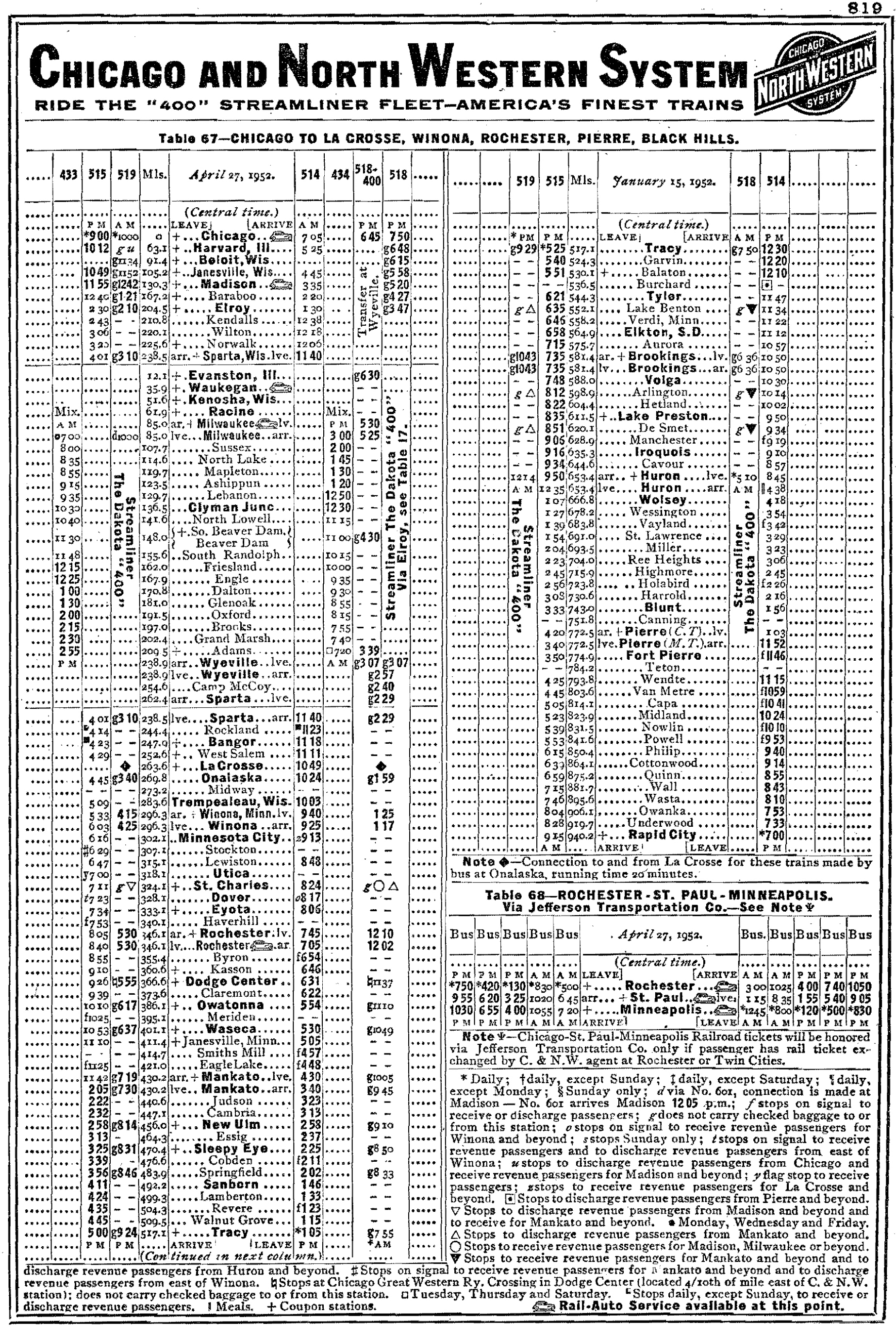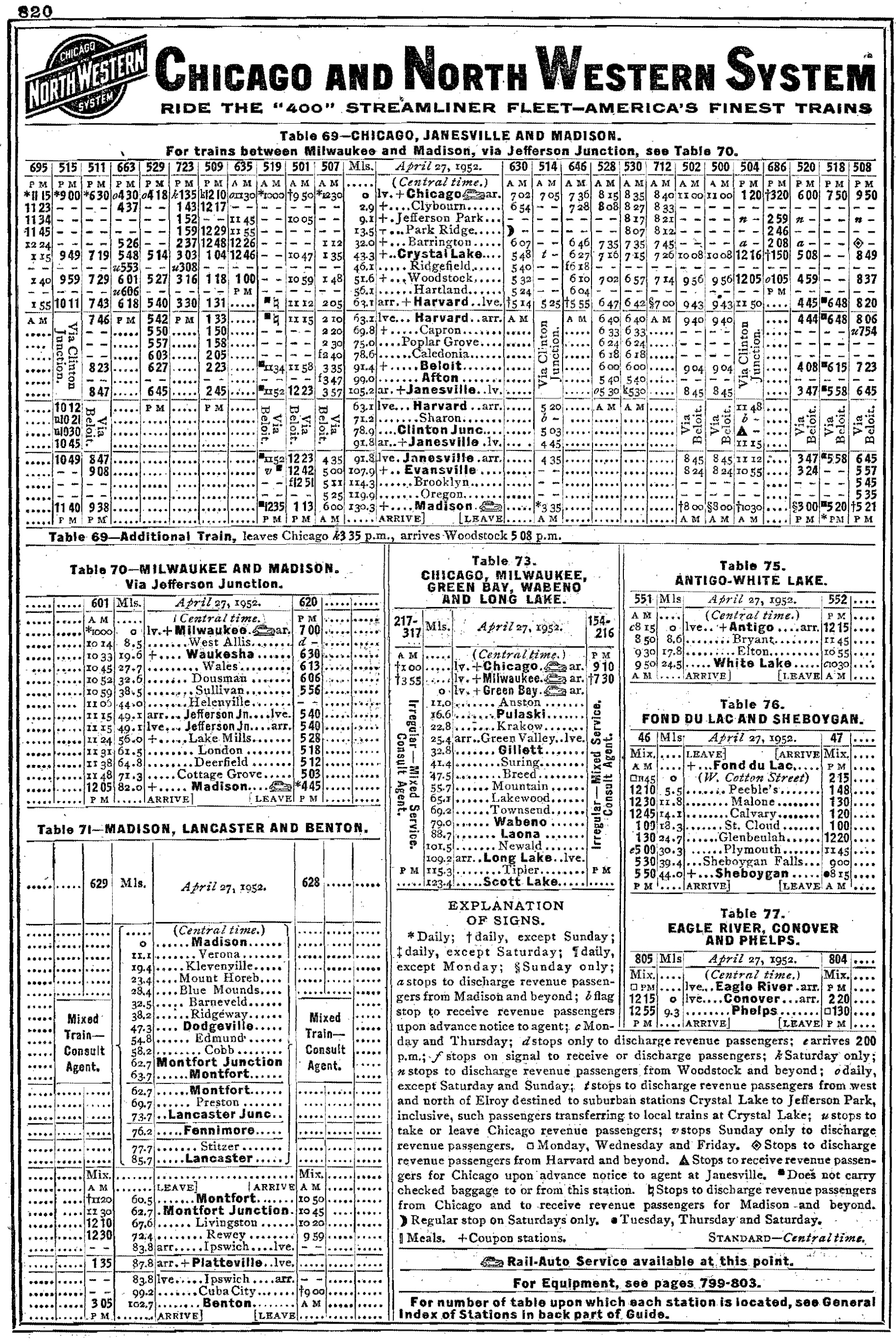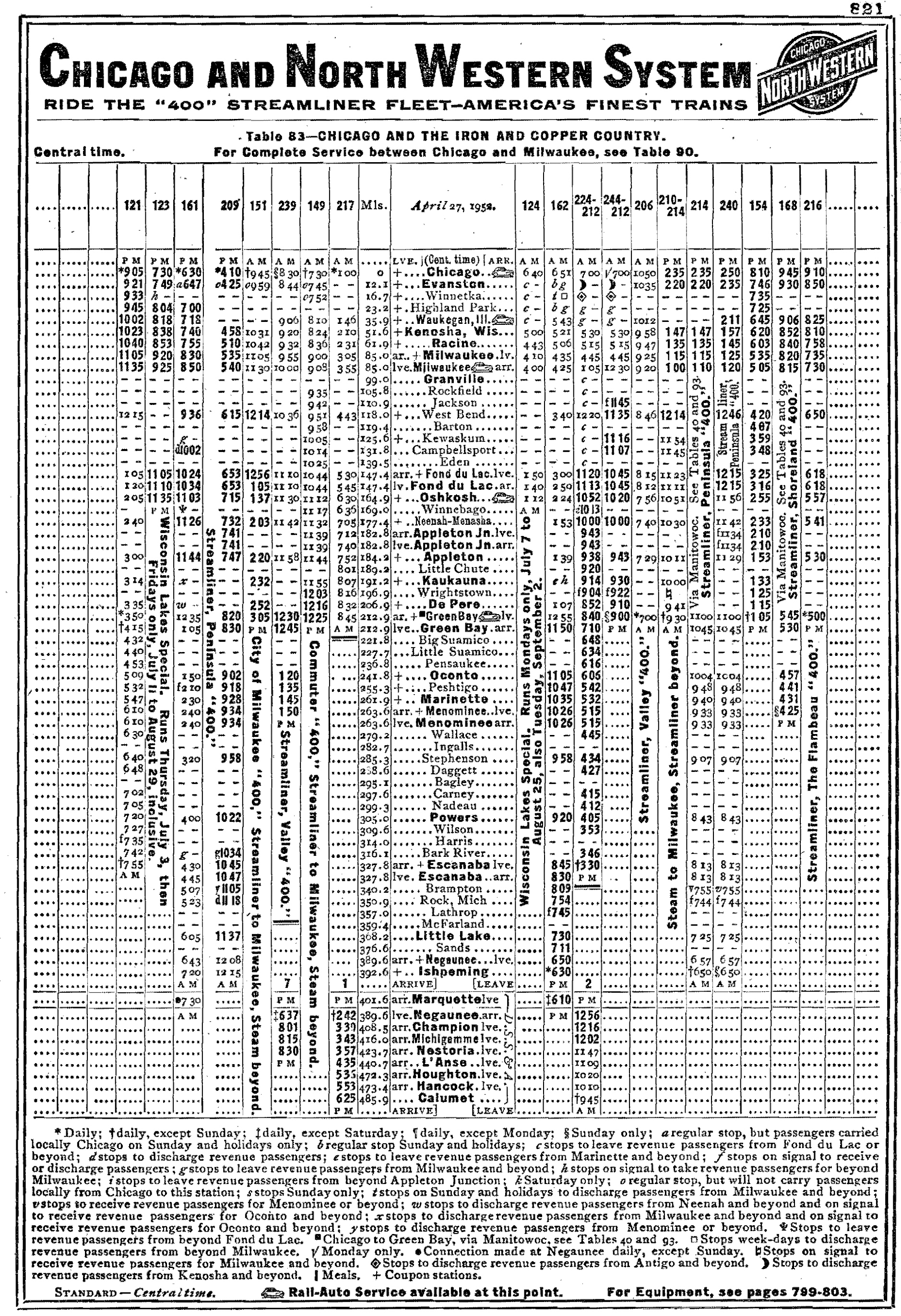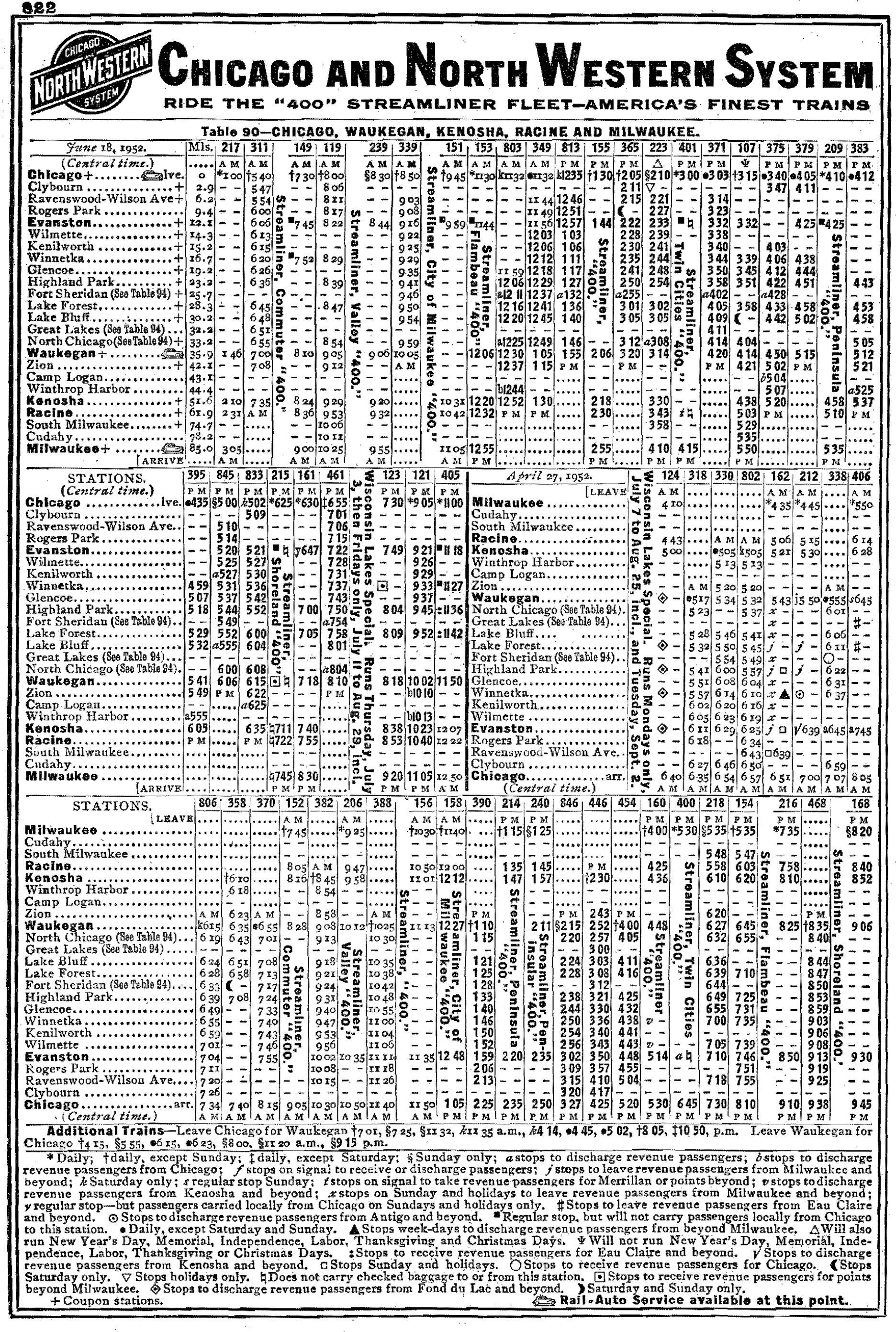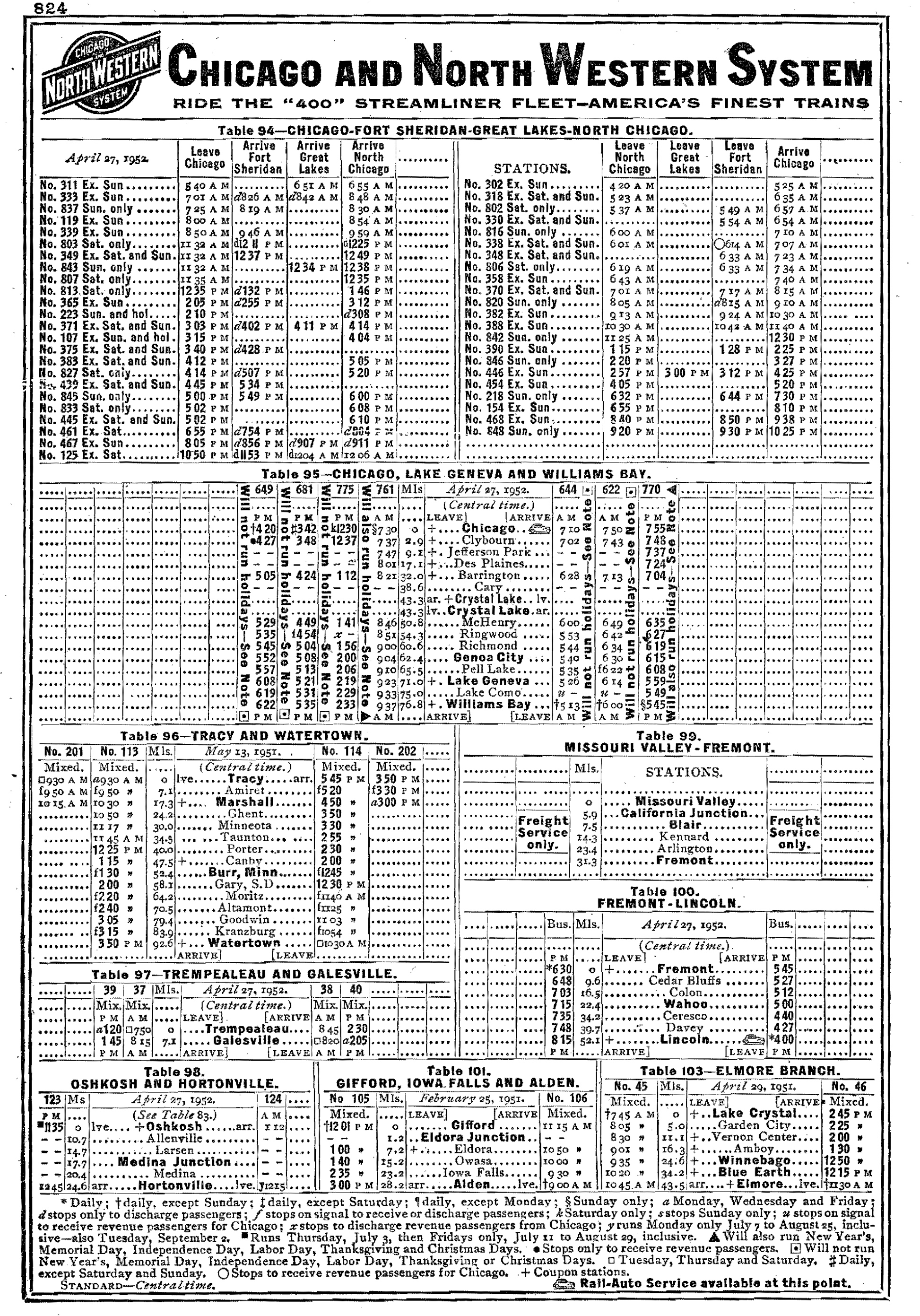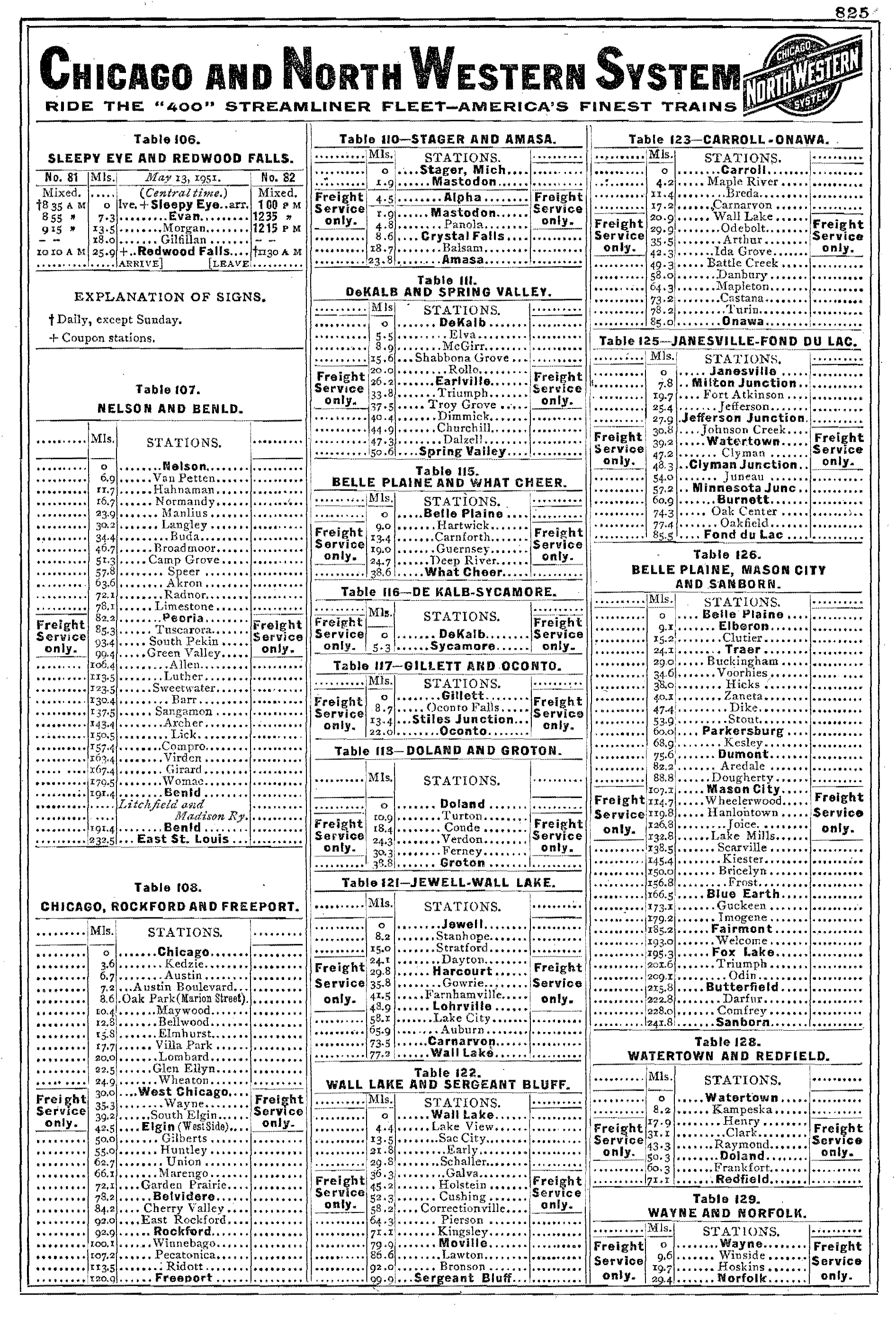Chicago and North Western Railroad: Map, History, Logo
Last revised: October 16, 2024
By: Adam Burns
The definition of granger is a farmer or homesteader. The term also describes those railroads which served America's breadbasket and derived a substantial portion of their annual revenue from the movement of agricultural products.
One of the most fondly remembered was the Chicago & North Western which maintained a sprawling network of more than 11,000 route miles across Wisconsin, Iowa, Nebraska, South Dakota, Illinois, Missouri, Michigan, and even reached North Dakota and Wyoming.
Like all grangers it maintained hundreds of miles of secondary trackage that were lightly patronized by the postwar period but absolutely fascinating to witness.
In few other places could one watch a passing freight bobbing along rickety, weed-covered trackage to serve a nearby grain elevator or local customer. While a joy to see in action these branches were a serious drain on a railroad's bottom line.
With the industry's deregulation in 1980 many such unprofitable lines were rightfully abandoned or sold to short line operations.
The C&NW struggled during the 1960's and 1970's but regained its footing in the 1980's with the rise in Powder River Basin coal. This clean-burning natural resource brought about a renaissance that led to its purchased by Union Pacific in 1995.
Photos
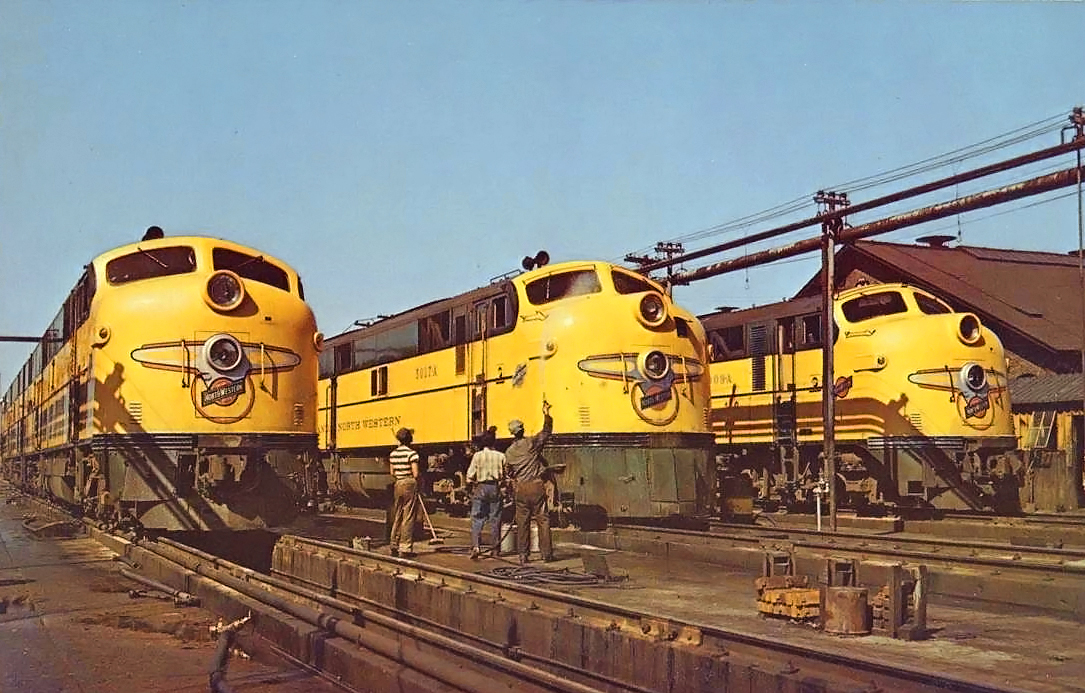 A famous postcard of Chicago & North Western E7s receiving a bath at the 40th Street Shops in Chicago, circa 1948.
A famous postcard of Chicago & North Western E7s receiving a bath at the 40th Street Shops in Chicago, circa 1948.History
From an operational standpoint, most of today's big Class I's lack much character; the locomotives largely all look the same, freights are unit consists, and few locals are dispatched. This was not the case years ago.
The Chicago & North Western, for example, was a railfan's paradise where one could witness heavy ore moving out of Michigan's Upper Peninsula, watch time freights blaze across the prairie, enjoy Alco's burbling past farms, and observe the elegant '400's' speeding between the big cities.
In Paul Schneider's article, "North Western Odyssey" from the March, 1996 issue of Trains Magazine, the C&NW held a unique distinction as being one of the last to continue operating diesels from all five major manufacturers (Electro-Motive, General Electric, American Locomotive, Baldwin, and Fairbanks-Morse).
In later years it became known for maintaining locomotives far beyond their expected service lives; former Chicago Great Western covered wagons, for instance, soldiered on in freight service long after C&NW had retired its own F units.
In addition, rebuilt first-generation Geeps could still be found working into the 1990's. The company developed an identity uniquely its own.
Galena & Chicago Union
The Chicago & North Western's earliest predecessor was the Galena & Chicago Union chartered in 1836. The G&CU is notable as not only being Chicago’s first railroad but also the first to operate a steam locomotive out of the city.
The railroad, intending to connect its namesake cities and reach the Mississippi River, had trouble right from the start; while surveying was carried out no construction took place and the project stalled. In 1846, it was taken over by a new group with the financial wherewithal and determination to see it completed.
At A Glance
10,216.99 (1930) 9,693 (1950) 5,300 (1995) |
|
Freight Cars: 41,383 Passenger Cars: 447 | |
Chicago - Fremont - Omaha, Nebraska Fremont, Nebraska - Lander, Wyoming Nelson, Illinois - St. Louis Chicago - Madison, Wisconsin - Minneapolis Milwaukee - Mankato, Minnesota - Rapid City, South Dakota Eau Claire, Wisconsin - Duluth, Minnesota Chicago - Kenosha - Milwaukee Chicago - Bain, Wisconsin - Milwaukee Milwaukee - Manitowoc, Wisconsin - Green Bay Milwaukee - Fond du Lac, Wisconsin - Green Bay Green Bay - Ashland Green Bay - Ishpeming, Michigan Powers, Michigan - Hurley, Wisconsin Twin Cities - Mankato - Omaha Lake Crystal, Minnesota - Des Moines, Iowa | |
Work began in June of 1848 and by January 22, 1850, 42 miles had been opened to Elgin. The project had only been under way a few months when the first locomotive arrived by schooner on October 10th, a 4-2-0 named the Pioneer. It was placed into service on October 24th, earning it the distinction as the first to operate out of Chicago.
The new promoters were successful in their gamble; behind a growing city the railroad earned a profit right from the start.
Agriculture played a large part in this and continued to do so for more than a century under the C&NW. By September of 1853 the G&CU had opened to Freeport but failed in reaching Galena.
As Tom Murray notes in his book, "Chicago & North Western Railway," the Illinois Central had arrived here first, forcing the G&CU to rely on an interchange connection (the C&NW would eventually establish its own route to Galena).
Logo
Despite this setback the road still eyed the mighty Mississippi and soon began construction of a line due west from Chicago. In December of 1855 this 135-mile corridor had reached Fulton (just across the state line from Clinton, Iowa), which became part of the future Omaha main line.
As the G&CU maintained an aggressive stance towards expansion it leased the Chicago, Iowa & Nebraska and Cedar Rapids & Missouri River Rail Road (a CI&N subsidiary) in 1863 which pushed its reach as far as Cedar Rapids, Iowa.
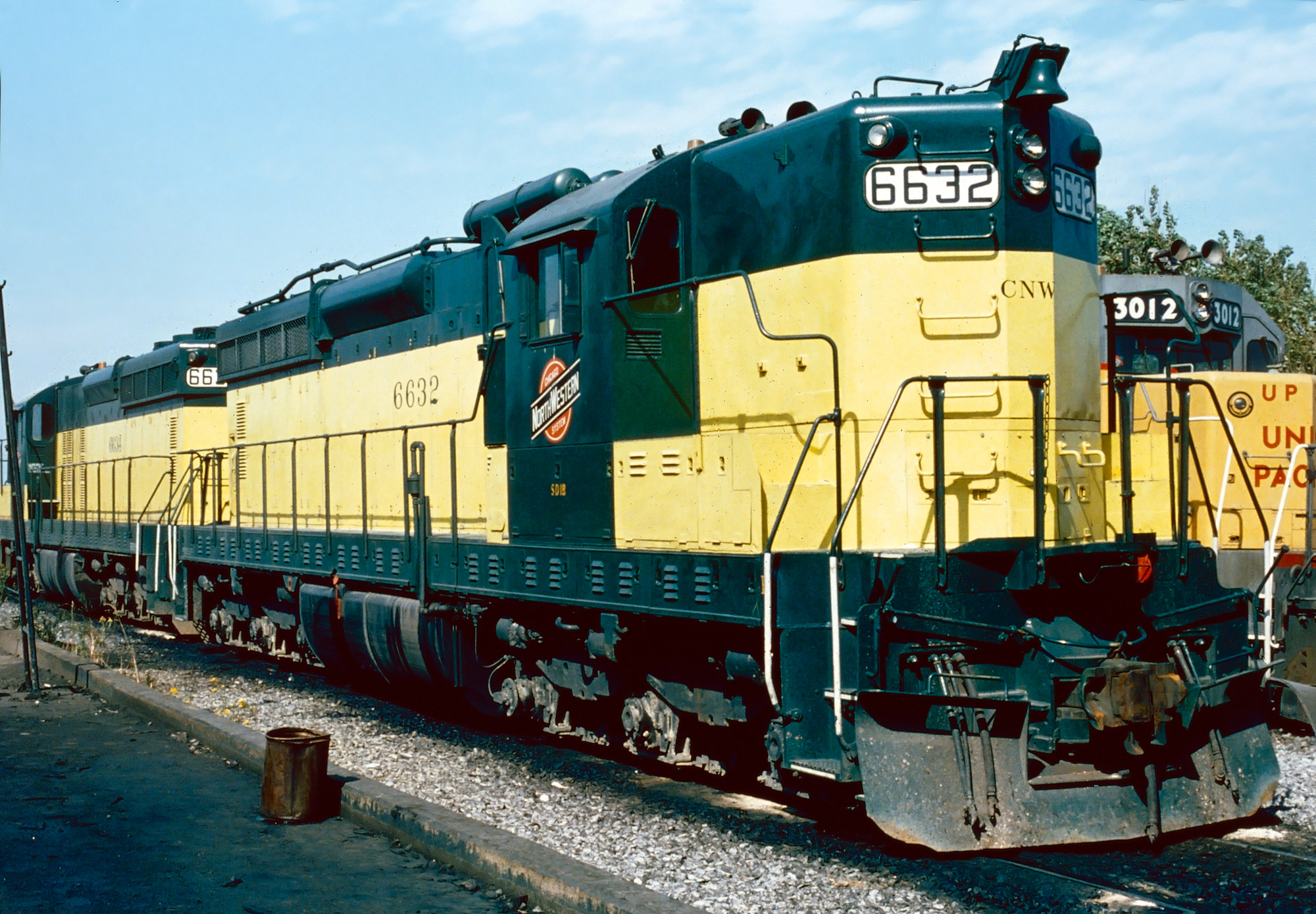 Chicago & North Western SD18's, #6632 and #6634 (ex-Southern SD24's) layover at the Katy shops in Parsons, Kansas during the summer of 1985. Mike Bledsoe photo. American-Rails.com collection.
Chicago & North Western SD18's, #6632 and #6634 (ex-Southern SD24's) layover at the Katy shops in Parsons, Kansas during the summer of 1985. Mike Bledsoe photo. American-Rails.com collection.The ultimate goal was Council Bluffs/Omaha, the point from which the Transcontinental Railroad (Union Pacific) would strike out westward. The CR&MR was completed in January of 1867 and had established a direct interchange with UP into Omaha after a bridge opened over the Missouri River in 1872.
This constituted the bulk of the G&CU network which totaled some 545 miles, including subsidiaries. While the Galena & Chicago Union was the C&NW's earliest component its direct ancestry traces to the Chicago, St. Paul & Fond du Lac Railroad.
The "Cowboy Line"
As the C&NW continued expanding across the Midwest its reach into Nebraska, western South Dakota, and Wyoming was thanks to a subsidiary known as the Fremont, Elkhorn & Missouri Valley Railroad.
This road was organized on January 20, 1869 and began building west from Fremont, Nebraska where it connected with the Sioux City & Pacific (also acquired by the C&NW).
After only two years, in 1871, the FE&MV (the "Elkhorn Route") had reached Wisner, 50 miles away. However, construction slowed for some time before picking up again during the latter 1870's when it reached Oakdale in 1879.
During the next decade it expanded prodigiously; by 1886 it had pushed rails to Casper, Wyoming and extreme western South Dakota via Rapid City.
The North Western, through its FE&MV subsidiary, was the first to reach this region (other railroads to later arrive here included the Milwaukee Road and Chicago, Burlington & Quincy), which was in the midst of the great Black Hills Gold Rush.
The C&NW acquired direct control of the Elkhorn Route in 1884 but did fully absorb it until 1903. What became known as the "Cowboy Line" (or “Lander Line”), was then a 560-mile corridor connecting Fremont with Casper. As management sought a true, transcontinental railroad Lander was reached in 1906.
Alas, the Pacific Coast was never attained and in the end, the Cowboy Line became a very long agricultural branch. According to the Nebraska Game & Parks Commission in 1932 the corridor served, “…66 farm dealers, 117 coal dealers, 48 grain elevators, 55 lumber dealers and 128 gas/oil receivers.”
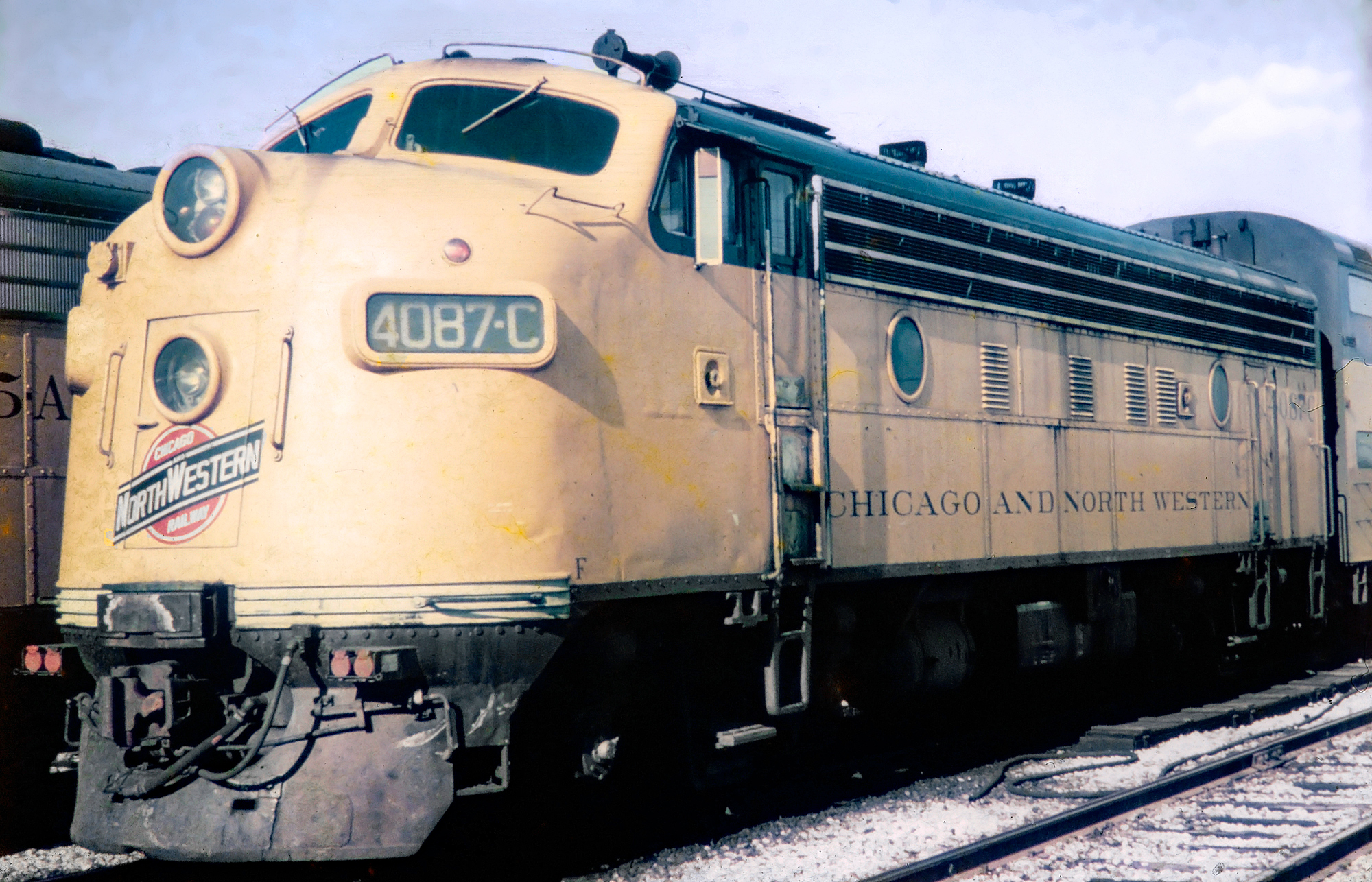 Chicago & North Western F7A #4087-C at West Chicago, Illinois, between commuter runs, circa 1970. American-Rails.com collection.
Chicago & North Western F7A #4087-C at West Chicago, Illinois, between commuter runs, circa 1970. American-Rails.com collection.Like other such branches the Lander Line was hurt considerably by improved highways and the growing trucking industry after World War II. As freight declined the corridor became an unwanted appendage and deferred maintenance witnessed trains creeping along as slow as 10 mph in some locations.
By the 1970's a new, lucrative business appeared in the West, Powder River Basin coal out of Wyoming. First served by Burlington Northern and growing in demand thanks to its clean burning properties the C&NW’s Cowboy Line lay strategically within reach of this traffic.
However, it would need hundreds of millions of dollars in upgrades to handle the many heavy coal trains running the route daily. At the time the railroad simply did not have this cash available. It initially attempted to work with BN.
Ultimately, as a means of gaining needed financing Union Pacific became involved. With help from this profitable carrier a new 55-mile connector between the western end of the Cowboy Line and a nearby UP route gained the two railroads access into the Basin. It opened in 1984.
The decision proved less expensive and decided the future fate of the Lander Line. Following a few years of additional use the C&NW petitioned the Interstate Commerce Commission (ICC) to discontinue service on the Cowboy Line between Norfolk and Chadron.
The ICC would eventually grant abandonment of the route as far west as Merriman and the last train over the line ran on December 1, 1992. Since then, most of the remainder of the old route has also been pulled up by various parties and is now part of the Cowboy Trail.
Chicago, St. Paul & Fond du Lac Railroad
The CStP&FdL had been formed on March 31, 1855 through the merger of the Illinois & Wisconsin and Rock River Valley Union Railroad. The two operated modest, but disconnected networks at the time; the I&W ran between Janesville, Wisconsin and Chicago while the RRVU served Fond du Lac and Watertown.
Naturally, plans following their marriage included closing the gap but the new road fell into bankruptcy before this was accomplished. The property was then acquired by businessman William Ogden who formed the Chicago & North Western Railway in June of 1859.
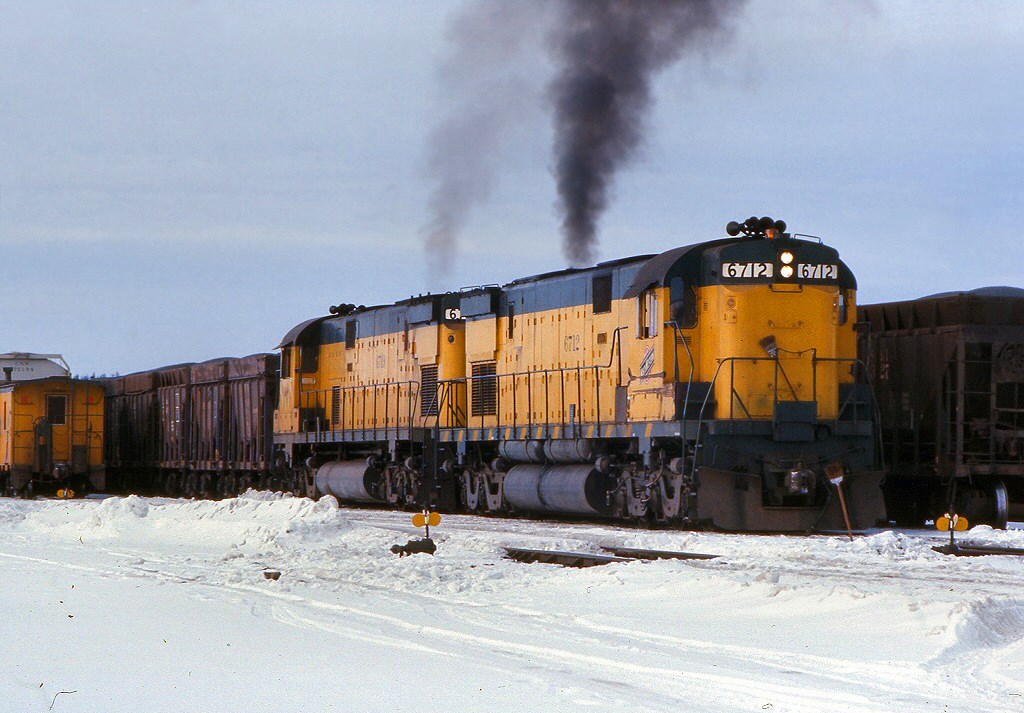 A pair of classic Chicago & North Western C628's throttle up as they pull hard on a long cut of loaded ore jennies in the yard at Ishpeming, Michigan during February of 1976. These Alco's were acquired secondhand from the Norfolk & Western and spent many years working heavy ore trains in the U.P. Note the broom stuck in the snowbank ahead of #6712 to clear switches. Rob Kitchen photo.
A pair of classic Chicago & North Western C628's throttle up as they pull hard on a long cut of loaded ore jennies in the yard at Ishpeming, Michigan during February of 1976. These Alco's were acquired secondhand from the Norfolk & Western and spent many years working heavy ore trains in the U.P. Note the broom stuck in the snowbank ahead of #6712 to clear switches. Rob Kitchen photo.Long considered the father and architect of the modern C&NW, Ogden quickly completed the Watertown to Janesville segment and then embarked upon a great railroad expansion across the upper Midwest.
With a region rich in timber and agriculture Ogden, using either the C&NW or another subsidiary, pushed rails to Oshkosh (1859), Fort Horward which later became Green Bay (1862), and established service into Michigan's Upper Peninsula at Escanaba and Negaunee (near Ishpeming).
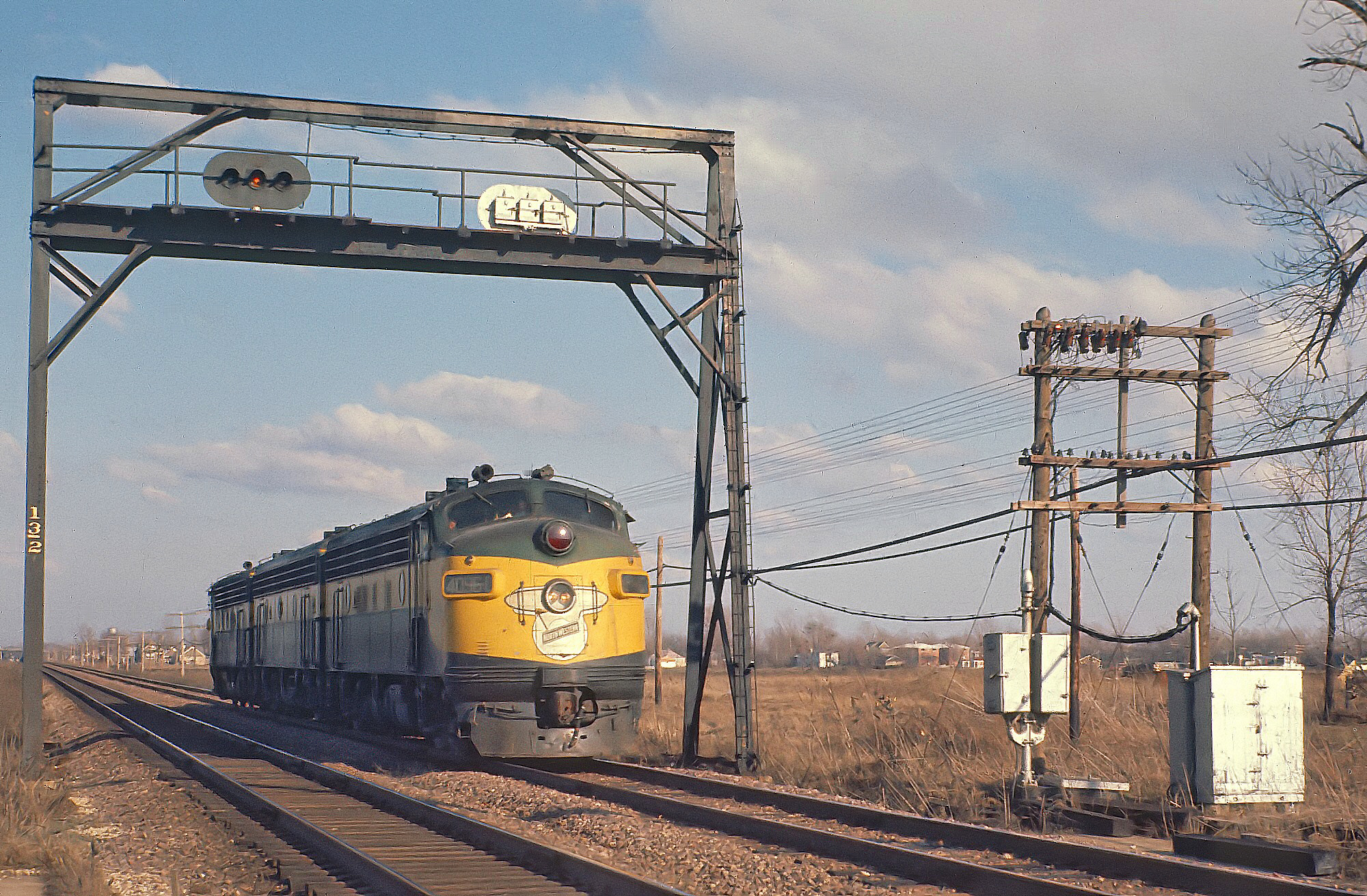 A group of Chicago & North Western F7s, led by #4096-C, run light at Wolf Road in Berkeley, Illinois during April, 1960. Rick Burn photo.
A group of Chicago & North Western F7s, led by #4096-C, run light at Wolf Road in Berkeley, Illinois during April, 1960. Rick Burn photo.Forming The C&NW
By this point the C&NW and G&CU were interchange partners and before long a merger was being considered.
The union was approved in 1865. The new C&NW became an instant 850+ mile system and one of the Midwest's most important. Ogden remained with the company until the summer of 1868.
His phenomenal success had been largely due to quick thinking and an understanding that surrounding competitors like the future Milwaukee Road, Burlington, and Rock Island, would render his railroad obsolete if it was not constantly expanding. He envisioned the C&NW as a major player and so, too, did his successors.
After Ogden's departure the company continued its march across the Midwest. There were countless small companies gobbled up during the latter 19th century; names like the Chicago & Milwaukee, Winona & St. Peter, Iowa Midland Railway, and North Western Union Railway.
There were even a handful of narrow-gauge operations such as the:
- Crooked Creek Railway & Coal Company
- Covington, Columbus & Black Hills Railroad (3-foot, 6-inch)
- Galena & Southern Wisconsin
- Chicago & Tomah
Many of these comprised its numerous secondary branches that a century later were an unwanted, money-losing nuisance. However, during a time when almost everything moved by rail they helped make the C&NW a prosperous carrier.
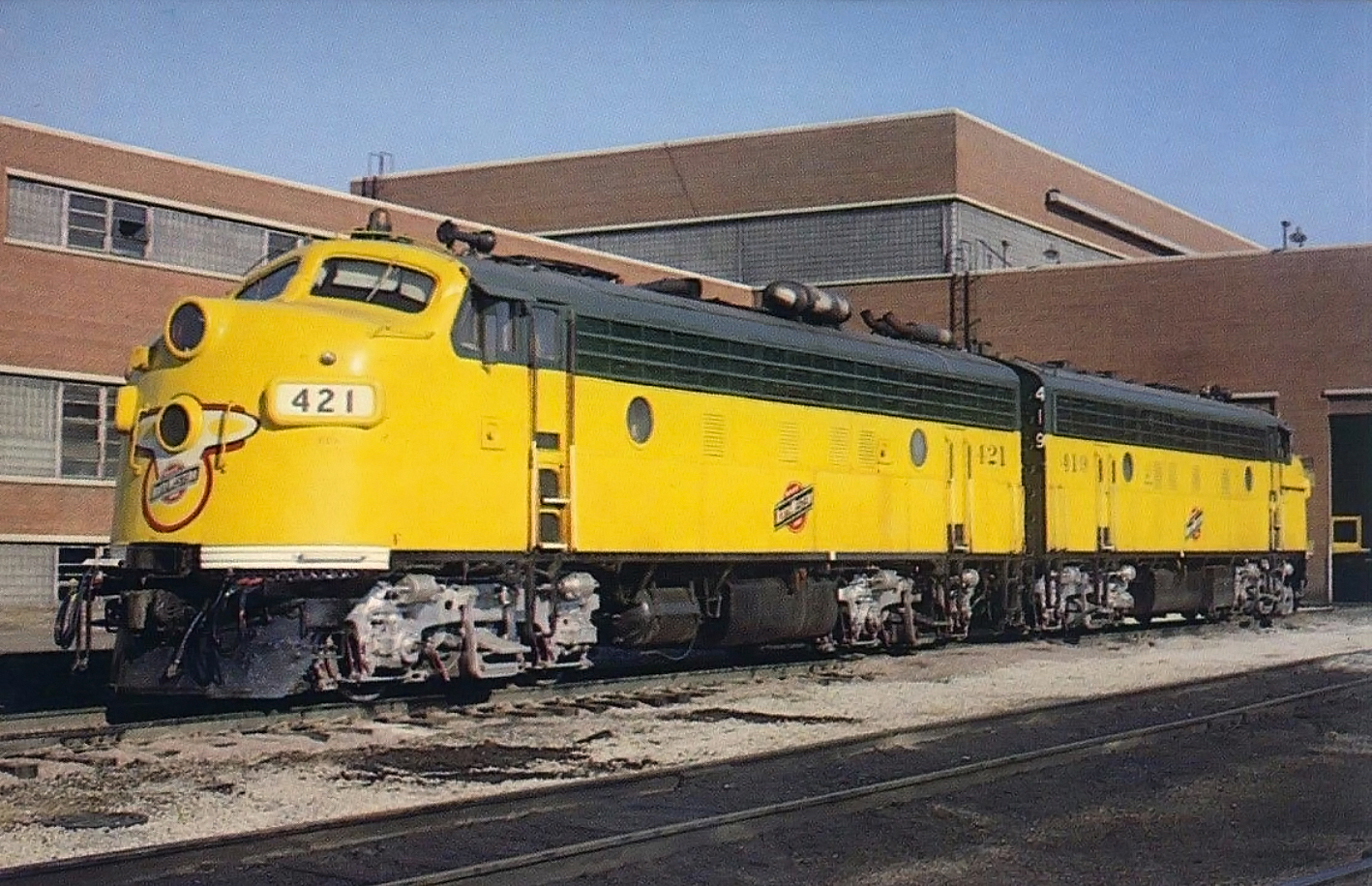 A pair of Chicago & North Western's "Presidential" F7A's, #421 and #419, are seen here at shop building M19-A in Chicago during November of 1981. John Benson photo.
A pair of Chicago & North Western's "Presidential" F7A's, #421 and #419, are seen here at shop building M19-A in Chicago during November of 1981. John Benson photo.Expansion
By 1880 the railroad maintained a 2,500-mile network and just a decade later blossomed into a 4,200-mile behemoth.
Two of the C&NW's most noteworthy acquisitions occurred during its final years of expansion; the Chicago, St. Paul, Minneapolis & Omaha Railway ("The Omaha Road") and Fremont, Elkhorn & Missouri Valley Railroad.
Historian, H. Roger Grant, offers an excellent account of the CStPM&O in his book, "Minnesota's Good Railroad: The Omaha Road."
The system was formed in 1880/1881 when a group which controlled the North Wisconsin Railway, West Wisconsin Railway, and St. Paul & Sioux City Railroad merged the trio into the Chicago, St. Paul, Minneapolis & Omaha. Within a year of this transaction the C&NW gained stock control during November of 1882.
The CStPM&O provided the North Western with its main line from Chicago to the Twin Cities, connection to the ore docks at Duluth/Superior, a secondary route into Omaha, and a link to Sioux City, Iowa.
At its peak, just prior to World War I, the Omaha Road boasted a 1,700-mile network. Interestingly, it remained a C&NW subsidiary until 1972.
20th Century Operations
You can read much more about the FE&MV in the inset article above entitled, "A History Of The Fabled 'Cowboy Line'." The railroad, formed in 1869, was acquired by the C&NW in 1884. It began a westward expansion that had reached western Wyoming at Lander by 1906. The North Western intended to reach the west coast but, unfortunately, never made it beyond Lander.
The railroad at this time was essentially in place maintaining a network of 7,450 miles which connected Chicago, Omaha, the Twin Cities, Milwaukee, Duluth/Superior, Rapid City, and many other points. It would not see further growth until the post-World War II period.
As the below, 1969 map attests the North Western's spaghetti-like system was so thick in the states of Iowa, Minnesota, and Wisconsin that in some spots different branch lines were not separated by more than ten or twenty miles!
As growth slowed the focus turned to upgrading the railroad; by 1902 the Council Bluffs-Chicago main line was double-tracked, signaling systems put into place, bridges rebuilt, and the infrastructure overhauled to support heavier and longer trains.
Later, in 1929 it opened the massive Proviso Yard located in western Chicago which at the time was largest terminal of its type in the country.
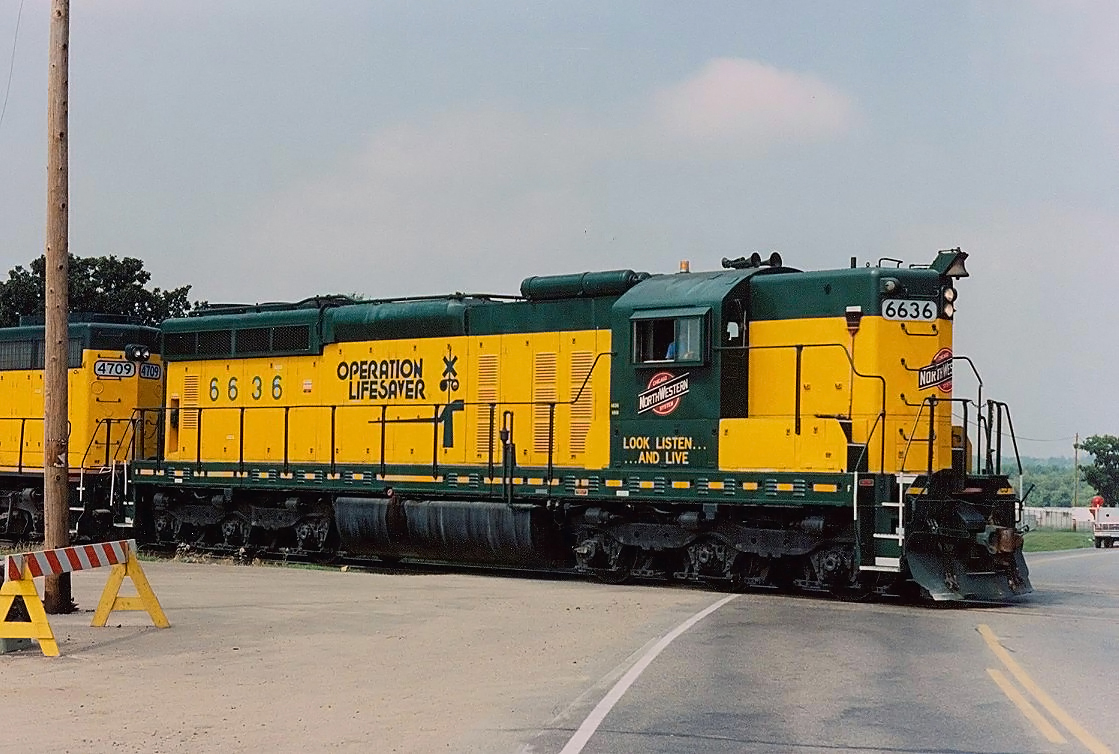 Chicago & North Western SD18M #6636 performs switching at Valley Park Yard in Savage, Minnesota on August 18, 1994. This unit began its career as Southern SD24 #2514 in late 1959, later sold to Precision National, and then resold to the C&NW in 1982. Doug Kroll photo.
Chicago & North Western SD18M #6636 performs switching at Valley Park Yard in Savage, Minnesota on August 18, 1994. This unit began its career as Southern SD24 #2514 in late 1959, later sold to Precision National, and then resold to the C&NW in 1982. Doug Kroll photo.The Great Depression, which hit the nation hard following the October 29, 1929 stock market crash was extremely taxing on the C&NW.
It was not alone as most other carriers had felt the sharp business declines within a few years. In Gregory Schneider's book, "Rock Island Requiem," the author points out that through 1936, 70,00 miles of railroad was in receivership.
The North Western fell into bankruptcy on January 27, 1935 and would not emerge until the great surge of traffic brought about by World War II, finally exiting judicial oversight on June 1, 1944.
For the general public the C&NW's most visual change, ironically, took place during its bankruptcy years with the introduction of flashy, colorful, and fast streamliners.
The company, whether interested or not was nevertheless caught up in the nationwide fervor. Union Pacific unveiled the first-ever such trainset in February of 1934, followed by the Chicago, Burlington & Quincy a few months later.
These new contraptions were a stark change from the traditional drab, colorless, and utilitarian appearance trains had always employed.
The public was duly impressed and the streamliner craze was underway. Realizing they were on to something, officials at Union Pacific wanted to launch a transcontinental service to Chicago. Since the C&NW had long worked with UP as its Windy City gateway it agreed to the new service.
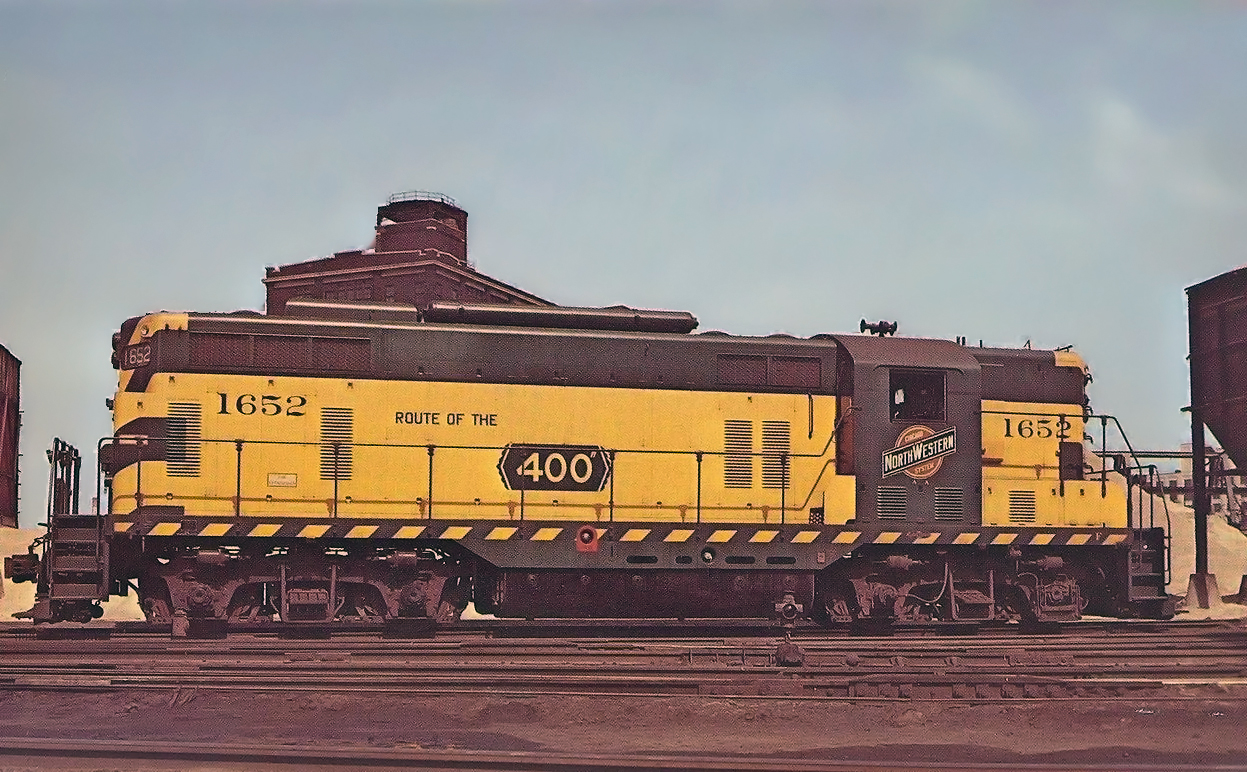 In this Chicago & North Western publicity scene, GP7 #1652, only a few months old, poses for a company photo during September of 1953. The locomotive was originally intended for suburban service around Chicago.
In this Chicago & North Western publicity scene, GP7 #1652, only a few months old, poses for a company photo during September of 1953. The locomotive was originally intended for suburban service around Chicago.In addition, the Burlington and Milwaukee Road were gearing up for their own streamliners in the hotly contested Chicago-Twin Cities market. Following the CB&Q's debut of its Zephyr trainset the railroad introduced regular service to this corridor in April of 1935.
It was followed a month later by the Milwaukee's legendary Hiawatha. The North Western, in effort to keep up, began upgrading its main line for high-speed operation.
As Mike Schafer notes in his book, "Classic American Railroads," since the C&NW's Chicago-Twin Cities route was roughly 400 miles and the service scheduled for around 400 minutes the new train was given the name '400.'
The only catch, it was originally not streamlined; due in part to its ongoing financial situation the railroad had to utilize a quartet of overhauled (non-shrouded) 4-6-2's (E-2a).
To increase their speed the Pacific's were rebuilt as oil burners, given larger driving wheels, and carried bigger tenders among their more notable improvements.
In addition, heavyweight cars were upgraded with better suspension and other perks. The '400' officially launched on January 2, 1935 and proved successful enough that new streamlined equipment and sleek Electro-Motive E3's arrived in 1939.
Eventually, a fleet of '400's' was unveiled across the Midwest. Surprisingly, they were actually not C&NW's official introduction into the streamliner age.
Following their agreement, UP wasted no time in launching its transcontinental services, acquiring its first trainsets from Electro-Motive/Pullman in June of 1935.
As trains like the first-class City of Los Angeles, City of Portland, and City of San Francisco grew in popularity conventional lightweight equipment (non-articulated) arrived for these services through the 1940's.
 Chicago & North Western GP7 #1595 and an E7A layover at Monona Yard in Madison, Wisconsin in November, 1965. Rick Burn photo.
Chicago & North Western GP7 #1595 and an E7A layover at Monona Yard in Madison, Wisconsin in November, 1965. Rick Burn photo.Postwar Years and Expansion
New diesels continued streaming in during the postwar years until steam had been retired completely by 1956. Unfortunately, this period began a long slide for the railroad.
Its revenue ton-miles dropped by 1 billion in just seven years between 1946 and 1953 and with an overbuilt network that totaled more than 9,400 miles deferred maintenance was carried out in an attempt to cut costs.
Employing such a tactic is never a sound business strategy in the long-term, which actually results in a railroad spending more money than it saves due to increased derailments and slower running times.
The C&NW's declining physical plant caused Union Pacific to switch its Chicago connection for passenger services to the Milwaukee Road, effective October 30, 1955. In 1963 the railroad discontinued its Twin Cities '400' and the '400' name disappeared entirely by 1969.
As bad as things were through 1956, when the company reported losses of more than $5 million, new management under president Ben Heineman did help improve the situation.
In just two years the railroad was again showing a profit although the heavy concentration of light density branches persisted.
System Map
For Heineman's successes he had little effect on reducing the secondary trackage. The problem was not entirely within his control.
Prior to deregulation it was nearly impossible for railroads to successfully petition the Interstate Commerce Commission in abandoning excess capacity.
However, in a way Heineman magnified the issue by acquiring a series of smaller systems beginning with the Litchfield & Madison in 1958.
This small, 44-mile pike was actually a good investment providing the C&NW direct access into St. Louis. However, in 1960 it acquired the nearly 1,400-mile Minneapolis & St. Louis Railway.
The Peoria Gateway was essentially just another granger, connecting Peoria with the Twin Cities, parts of Iowa, and stretching into South Dakota.
Later that decade, in 1968, it picked up another of about the same size, the Chicago Great Western. The Corn Belt Route was also a granger but did connect more noteworthy markets including the Twin Cities, Chicago, Omaha, and Kansas City.
That same year C&NW added a former interurban, the 110-mile Fort Dodge, Des Moines & Southern ("The Fort Dodge Line"), as well as the 36-mile Des Moines & Central Iowa Railway.
With these takeovers the North Western ballooned into a 11,500+ mile network. Historians have questioned the strategic nature of these moves; the railroad sold or abandoned much of each system afterwards and only the L&M and Great Western offered markets the railroad did not already serve (St. Louis and Kansas City).
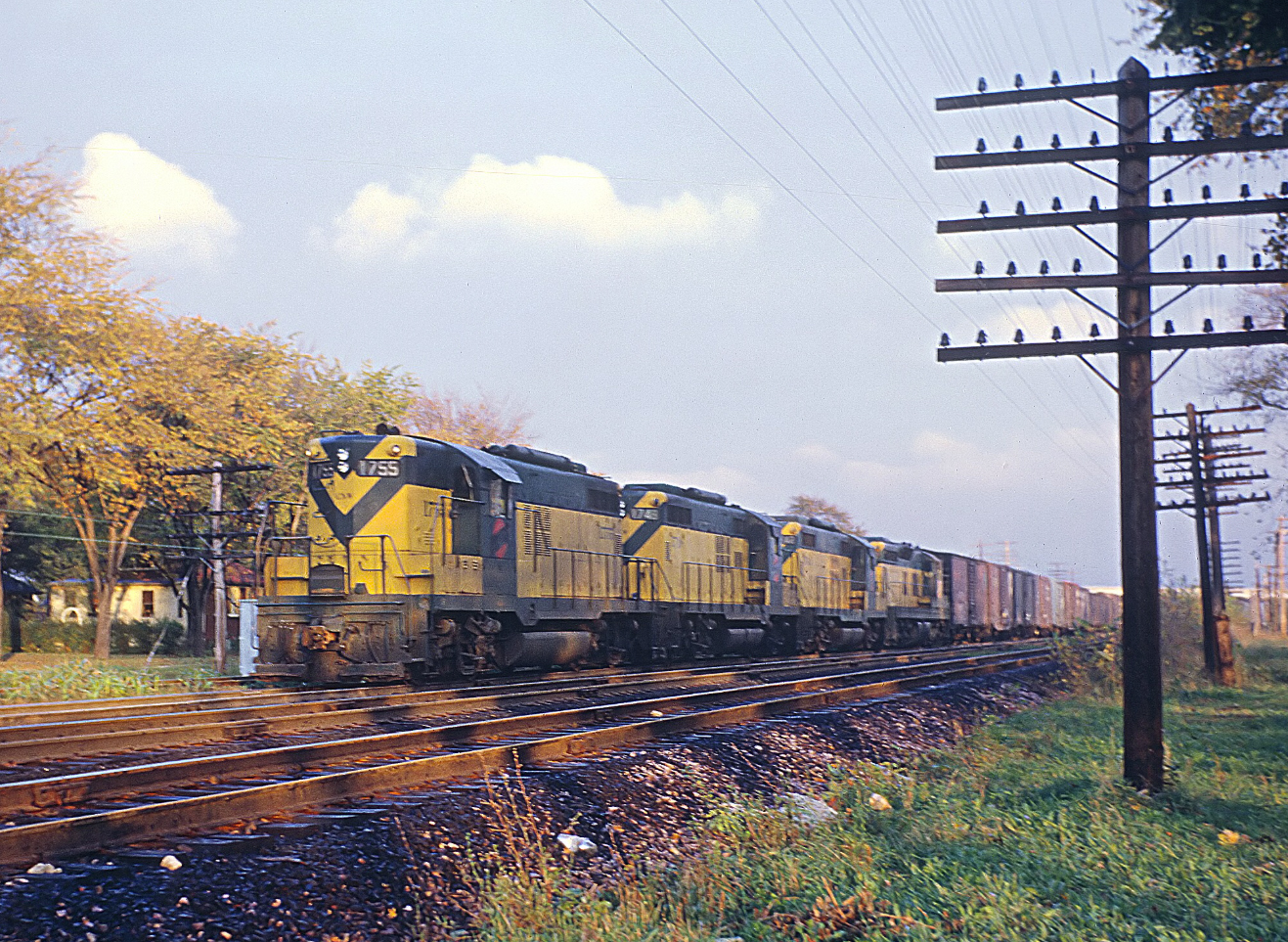 A group of Chicago & North Western GP9s, led by #1755, have a westbound freight at Clinton Street in Elmhurst, Illinois on an October evening in 1961. Rick Burn photo.
A group of Chicago & North Western GP9s, led by #1755, have a westbound freight at Clinton Street in Elmhurst, Illinois on an October evening in 1961. Rick Burn photo.The "Alco Line"
During the diesel era, Chicago & North Western's propensity to maintain first-generation models long after many others had retired theirs earned it the less-than-flattering title, "Cheap And Nothing Wasted." However, there was a method behind this madness.
Not only was the C&NW able to extend the service lives of these locomotives, particularly Electro-Motive units, but the railroad also generally assigned blocks of the same builder's models to various divisions or regions.
This insured that, while the mechanics and crews may not have always liked them (U30C's, for instance, were loathed), maintenance would be streamlined.
For those who love Alco's, the secondary main line from Winona, Minnesota to Rapid City, South Dakota was the place to be in the 1970's.
The so-called "Alco Line" was a paradise of Schenectady splendor; burbling, belching models like the RS11, RS3, RSD4, RSD5, C425, RS36, and others were a common sight here.
Adding to their charm was their greasy, grimy appearance and the bucolic Midwestern settings in which they operated. Alas, the road eventually retired their Alco's and the "Huron Main" totaling 826 miles, including branches, was sold to new startup Dakota, Minnesota & Eastern in 1986.
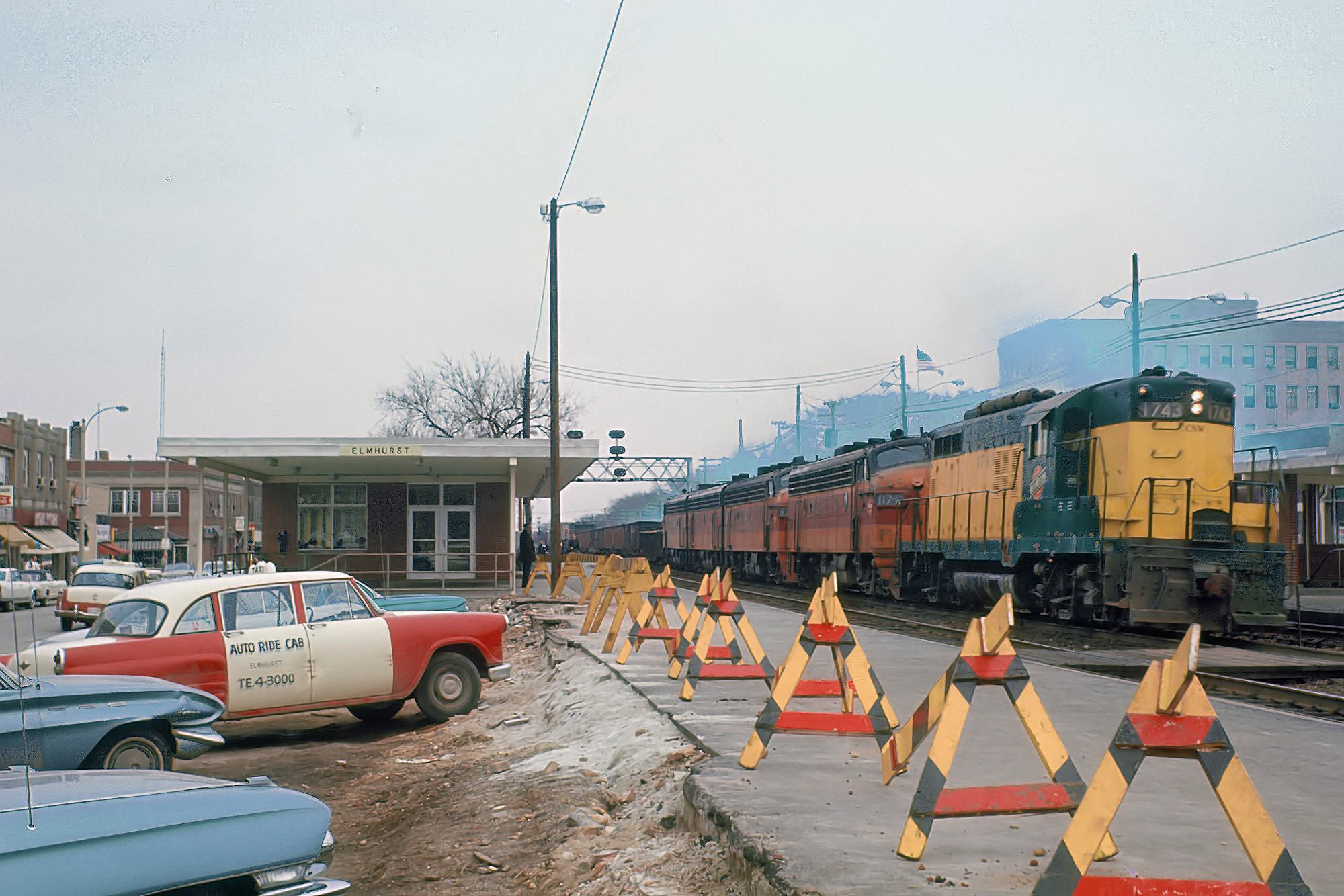 Chicago & North Western GP7 #1743 leads a detouring Milwaukee Road freight at Elmhurst, Illinois in April, 1965. Rick Burn photo.
Chicago & North Western GP7 #1743 leads a detouring Milwaukee Road freight at Elmhurst, Illinois in April, 1965. Rick Burn photo.Final Years
The 1960's began a new era for the C&NW. In an attempt to reduce excess capacity it began focused discussions with the transcontinental Milwaukee Road concerning merger.
The two had discussed the subject since the 1930's but never seriously considered the proposition before that time.
Ultimately, the latest talks ended once more without an agreement and each went their separate ways. Then, during the 1960's the C&NW formed a new subsidiary known as Northwest Industries.
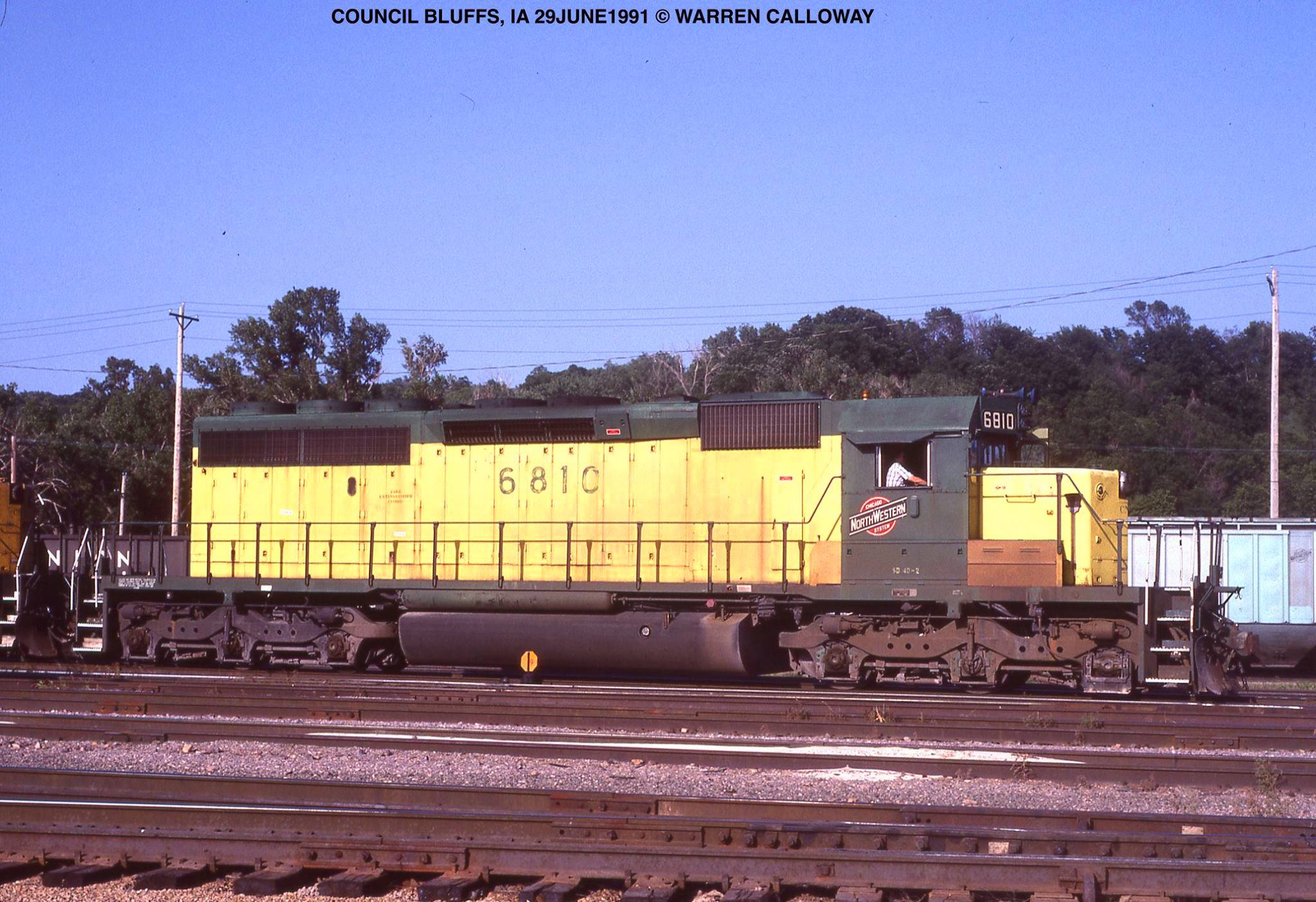 A nice side-profile view of Chicago & North Western SD40-2 #6810 at Council Bluffs, Iowa on June 29, 1991. The SD38-2 and SD40-2 were easily distinguishable from all other EMD models by their long frames, giving the appearance of "porches" at the fore and aft ends of the locomotive. Warren Calloway photo.
A nice side-profile view of Chicago & North Western SD40-2 #6810 at Council Bluffs, Iowa on June 29, 1991. The SD38-2 and SD40-2 were easily distinguishable from all other EMD models by their long frames, giving the appearance of "porches" at the fore and aft ends of the locomotive. Warren Calloway photo.Many railroads at the time were creating these paper corporations as a way to boast earnings by acquiring companies in markets/industries outside of railroading. In the process it allowed them to escape ICC oversight.
Before long, NWI wanted out of the high cost/low profit and cyclic nature of the railroad business. Thus, a plan was hatched to have C&NW employees, themselves, own the company.
On June 1, 1972 the Chicago & North Western Transportation Company was born and acquired the railroad's assets.
It then embarked upon a campaign of selling or abandoning thousands of miles of light density lines, increase earnings, and finding a way to lower its phenomenally high operating ratio which hovered at around 90%.
Passenger Trains
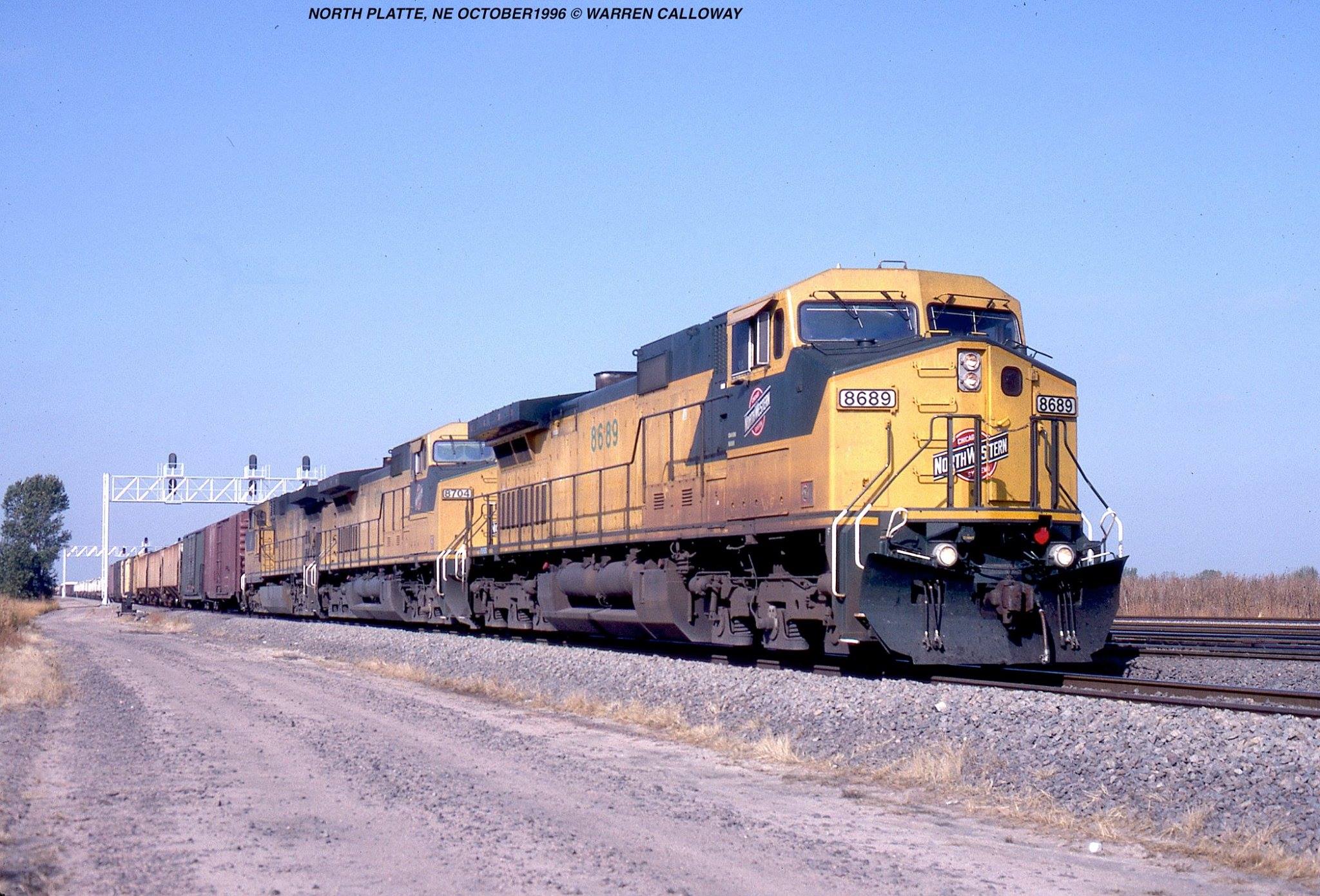 A trio of Chicago & North Western C44-9W's ahead of a manifest freight near North Platte, Nebraska shortly after the Union Pacific takeover during October of 1996. Warren Calloway photo.
A trio of Chicago & North Western C44-9W's ahead of a manifest freight near North Platte, Nebraska shortly after the Union Pacific takeover during October of 1996. Warren Calloway photo.The company also upgraded its most important routes and worked to enter Wyoming's growing Powder River Basin coal seams.
As the above, inset article notes the C&NW's own Cowboy Line lay directly within the heart of this lucrative natural resource. However, the corridor had been so badly neglected over the years it could never handle the required tonnage.
Diesel Roster
The Chicago & North Western rostered an interesting and eclectic diesel fleet during the so-called "first generation" era. It acquired models from all of the major builders.
However, in later years the C&NW typically stuck with EMD products while in its final years it picked up General Electric's newest Dash 8s and Dash 9s.
In addition, the railroad famously rebuilt older first-generation power to extend their service lives while it also rebuilt others into slugs.
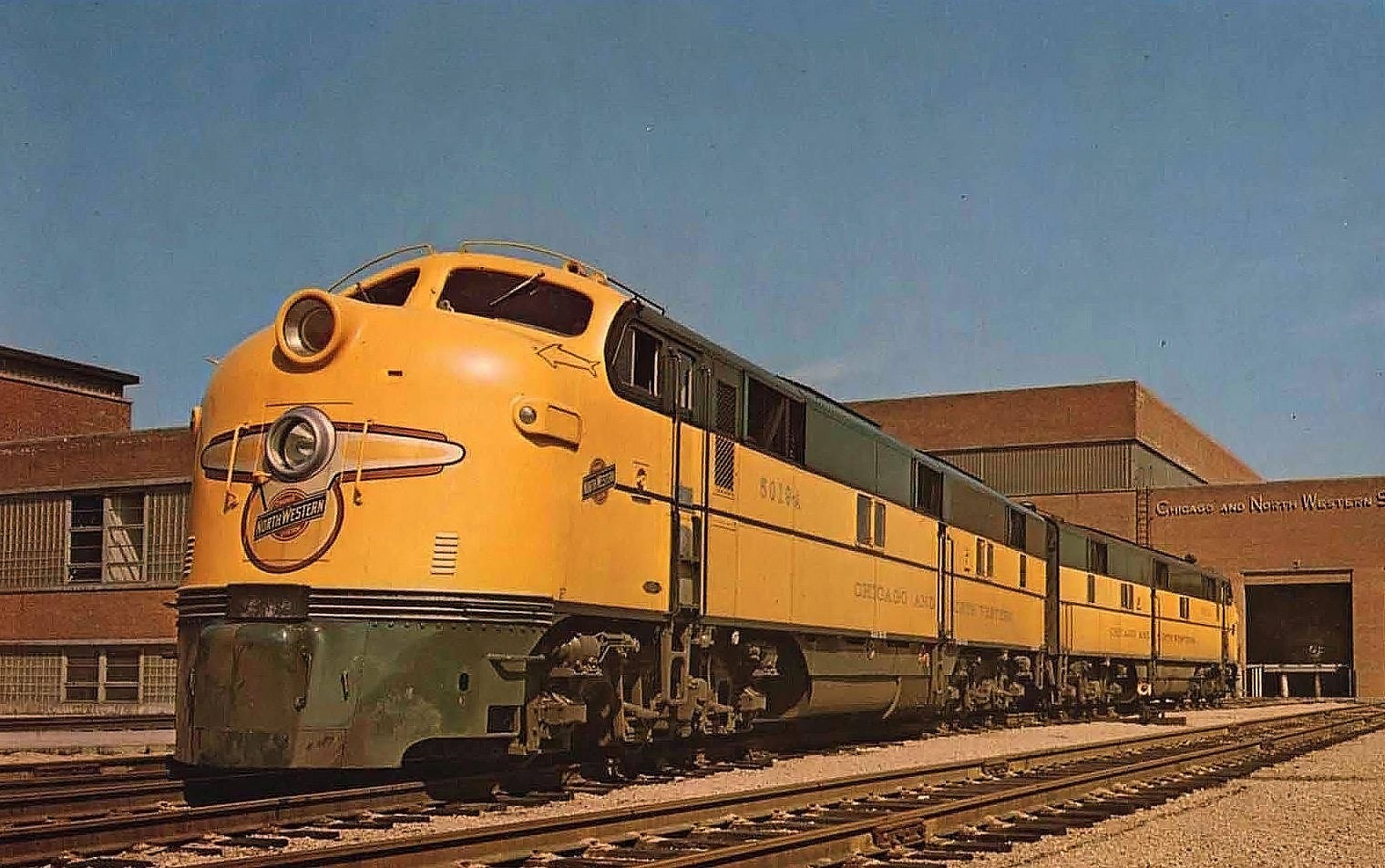 A Chicago & North Western publicity photo featuring E7A's #5019-A/B at the 40th Street Shops in Chicago circa 1953.
A Chicago & North Western publicity photo featuring E7A's #5019-A/B at the 40th Street Shops in Chicago circa 1953.Cab Units
| Original Road Number | 2nd Road Number | 3rd Road Number | Model Type | Builder | Completion Date | Builder Number | Notes |
|---|---|---|---|---|---|---|---|
| 101C, 104A, 106A (Chicago Great Western) | 201-202 (ex-#101C and #104A) | - | F3A | EMD | 10/1947 | 4118, 4123, 4126 | - |
| 113A, 113C-115A, 115C (Chicago Great Western) | 212-216 (ex-113A, 113C, 114A, 115A, 115C) | - | F3A | EMD | 2/1949 | 5989-5994 | - |
| 101B-106B (Chicago Great Western) | 301 (3rd), 303 (2nd), 305-307, X262401 (Radio Control Car) | - | F3B | EMD | 10/1947 | 4129-4134 | - |
| 107B-110B, 112B (Chicago Great Western) | 308 (2nd), rebuilt as slug BU-30, 311 (2nd), 313 (2nd) | - | F3B | EMD | 3/1948 | 5016-5019, 5021 | #112B sold. |
| 113B-115B (Chicago Great Western) | 316 (2nd), 318 (2nd), 319 (2nd) | - | F3B | EMD | 10,12,12/50 | 13546, 13563-13564 | - |
| 101D-103D (Chicago Great Western) | 302 (2nd), 304 | - | F3B | EMD | 2/1949 | 5234-5236 | #103D sold. |
| 105D-111D (Chicago Great Western) | Rebuilt into slug BU31 (ex-106D), 309 (ex-107D), 310 (ex-108D), 312 (2nd, ex-109D), 314 (2nd, ex-111D) | - | F3B | EMD | 10/1949 | 7912-7915, 7905-7906, 7911 | #105D sold and #110D retired before merger. |
| 112D-114D (Chicago Great Western) | 315 (2nd), 317 (2nd) | - | F3B | EMD | 10/1950, 5/1951 | 13543-13545 | #114D sold. |
| 116A, 116C | 217-218 | - | FP7 | EMD | 12/1950 | 13559-13560 | - |
| 116B, 116D, 116E, 116F, 116C | 320 (2nd, ex-116B), 321 (2nd, ex-116D), 322 (ex-116F), 323 (ex-116G) | - | FP7 | EMD | 12/1950, 5/1951 | 13561-13562, 14724-14726 | #116E sold. |
| 107C, 108A, 108C (Chicago Great Western) | 203 (2nd), 204-205 | - | F3A | EMD | 3/1948 | 5005-5007 | - |
| 109C, 110A, 110C, 111A (Chicago Great Western) | 206 (2nd), 207 (2nd), 208-209 | - | F3A | EMD | 3/1948 | 5009-5012 | - |
| 112A, 112C (Chicago Great Western) | 210 (2nd), 211 (2nd) | - | F3A | EMD | 3/1948 | 5014-5015 | - |
| 4076C, 4091A | 219 (2nd), 220 | - | F7A | EMD | 10/1950, 4/1950 | 8557, 10570 | - |
| 5401A-5404A (FTA) | 221 (2nd) - 223 (2nd), 224 | - | FP9M | EMD | 7/1955, 10/1955, 11/1955 | 3115-3118 | Rebuilt from former FTAs. |
| 150, 152 (Chicago Great Western) | 4101A (2nd), 4101C (2nd) | 225 (2nd) - 226 (2nd) | F3A | EMD | 11/1948, 1/1949 | 5995, 5997 | - |
| 153, 155, 156 (Chicago Great Western) | 4102A (2nd), 4102 (2nd), 4103A (2nd) | 227 (2nd) - 229(2nd) | F3A | EMD | 6/1949 | 7058, 7060-7061 | - |
| 73C/210C (Missouri-Kansas-Texas) | 230 (2nd) | - | F7A | EMD | 6/1949 | 7382 | - |
| 78A/121A (Missouri-Kansas-Texas) | 231 (2nd) | - | FP7 | EMD | 1/1952 | 14805 | - |
| 68C/205C, 65A/202A (Missouri-Kansas-Texas) | 232 (2nd), 233 (2nd) | - | F3A | EMD | 6/1947 | 14805 | - |
| 503-505 (Florida East Coast) | 234-236 | - | F3A | EMD | 3/1949 | 5518-5520 | - |
| 75A/226A (Missouri-Kansas-Texas) | 237 | - | F7A | EMD | 6/1949 | 7389 | - |
| 507-508 (Florida East Coast) | 238-239 | - | F3A | EMD | 1/1949 | 5521-5522 | - |
| 571-575 (Florida East Coast) | 240-244 | - | FP7 | EMD | 12/1951 | 15568-15572 | - |
| 72A/209A (Missouri-Kansas-Texas) | 245 | - | F7A | EMD | 6/1949 | 7379 | - |
| 79A/122A (Missouri-Kansas-Texas) | 246 | - | FP7 | EMD | 2/1952 | 7379 | - |
| 77C/229C (Missouri-Kansas-Texas) | 247 | - | F7A | EMD | 6/1949 | 7396 | - |
| 67A/204A, 64C/201C, 66A/203A (Missouri-Kansas-Texas) | 248-250 | - | F3A | EMD | 6/1947 | 4028, 4032, 4027 | - |
| 76A/227A (Missouri-Kansas-Texas) | 251 | - | F7A | EMD | 6/1949 | 7391 | - |
| 64A/201A (Missouri-Kansas-Texas) | 252 | - | F3A | EMD | 6/1947 | 4025 | - |
| 74C/211C (Missouri-Kansas-Texas) | 253 | - | F7A | EMD | 6/1949 | 7384 | - |
| 6390 (Southern Pacific) | 254 | - | F7A | EMD | 9/1951 | 12803 | - |
| 70C/228C (Missouri-Kansas-Texas) | 255 | - | F7A | EMD | 6/1949 | 7394 | - |
| 69A/206A, 65C/202C (Missouri-Kansas-Texas) | 256-257 | - | F3A | EMD | 6/1947 | 4030, 4033 | - |
| 79C/122C (Missouri-Kansas-Texas) | 258 | - | FP7 | EMD | 6/1952 | 14808 | - |
| 76C/227C (Missouri-Kansas-Texas) | 259 | - | F7A | EMD | 6/1949 | 7392 | - |
| 4070C, 4093A, 4100C, 4071A | 260-263 | - | F7A | EMD | 3/1949, 4/1950, 5/1950, 3/1949 | 6605, 10574, 10589, 6606 | - |
| 4078C, 4079A, 4080C, 4084A, 4085A, 4085C, 4086C | 266-272 | - | F7A | EMD | 11/1949-12/1949 | 8561-8562, 8565, 8572, 8574, 8577 | - |
| 101D-102D (Chicago Great Western) | 302 (2nd), 304 | - | F3B | EMD | 2/1949 | 5234-5235 | - |
| 102B-103B, 105B-106B (Chicago Great Western) | 303, 305-307 | - | F3B | EMD | 10/1947 | 4130, 4132-4134 | - |
| 107B, 107D (Chicago Great Western) | 308-309 | - | F3B | EMD | 3/48, 10/49 | 5016 & 7914 | - |
| 108D (Chicago Great Western) | 310 (2nd) | - | F3B | EMD | 10/1949 | 7915 | - |
| 109B, 109D (Chicago Great Western) | 311 (2nd) - 312 (2nd) | - | F3B | EMD | 3/1948, 10/1949 | 5018, 7905 | - |
| 110B, 11D (Chicago Great Western) | 313 (2nd) - 314 (2nd) | - | F3B | EMD | 3/1948 | 5019, 7911 | - |
| 112D (Chicago Great Western) | 315 (2nd) | - | F3B | EMD | 10/1950 | 13543 | - |
| 113B, 113D (Chicago Great Western) | 316 (2nd), 317 (2nd) | - | F3B | EMD | 10/1950 | 13546, 13544 | - |
| 114B-115B (Chicago Great Western) | 318 (2nd) - 319 (2nd) | - | F3B | EMD | 12/1950 | 13563-13564 | - |
| 116B, 116D, 116F, 116G (Chicago Great Western) | 320 (2nd) - 321 (2nd), 322-323 | - | F7B | EMD | 12/1950, 5/1951 | 13561-13562, 14724-14726 | - |
| 4084C/415, 4100A/425 | 400 (2nd), 400 (3nd) | - | F7A | EMD | 10/1949, 4/1950 | 8573, 10588 | - |
| 4087A, 4075A, 4079C | 419, 421-422 | 401 (4th) - 403 (4th) | >F7A | EMD | 12/1949, 10/1949 | 10150, 8554, 8563 | - |
| 406-409 (Minneapolis & St. Louis) | 406-407, 408 (2nd) - 409 (2nd) | - | F7A | EMD | 11/1949 | 8255-8258 | Built as M&StL 150A, 150C, 250A, 250C. |
| 410-411 (Minneapolis & St. Louis) | 410-411 | - | F7A | EMD | 11/1949 | 9225-9226 | Built as M&StL 350A and 350C. |
| 317/113D, 318/114B (Chicago Great Western) | 410 (4th), 411 (3rd) | - | F7B | EMD | 10/1950, 12/1950 | 13544, 13563 | - |
| 151A/412, 151C/413 (Minneapolis & St. Louis) | 412-413 | - | F7A | EMD | 12/1950 | 12027-12028 | - |
| 4069C, 4083A | 412 (2nd) - 413 (2nd) | - | F7A | EMD | 3/1949, 12/1949 | 6603,8570 | - |
| 4083C | 414 | - | F7A | EMD | 12/1949 | 8571 | - |
| 4084C | 400 (2nd) | 415 | F7A | EMD | 12/1949 | 8573 | - |
| 4077A, 4073C, 4073A | 416-418 | - | F7A | EMD | 10/1949, 7/1949 | 8558, 8551, 8550 | - |
| 4087A, 4087C, 4075A, 4079C | 401 (4th) - 403 (4th) | 419-422 | F7A | EMD | 12/1949, 10/1949 | 10150-10151, 108554, 108563 | - |
| 4076A, 4074A, 4100A | 423-425 | - | F7A | EMD | 10/1949, 10/1950 | 8563, 8552, 10588 | #425 formerly #400 (3rd). |
| 910B, 913B (Union Pacific) | 501-502 (Crandall Cab) | - | E9B | EMD | 12/1962 | 27696, 28671 | - |
| 925B, 935B (Union Pacific) | 503-504 (Crandall Cab) | - | E8B | EMD | 3/1953, 2/1953 | 743, 17795 | - |
| 960B, 962B (Union Pacific) | 505-506 (Crandall Cab) | - | E9B | EMD | 5/1955 | 20500, 20502 | - |
| 927, 934, 940, 942 (Union Pacific) | 507-510 | - | E8A | EMD | 6/1950, 3/1953-4/1953 | 10777, 17786, 18271, 18273 | - |
| 949 (Union Pacific) | 511 | - | E9A | EMD | 4/53 | 204856 | Returned to Union Pacific after the merger and now part of the railroad's heritage fleet. |
| 5027B, 5028A, 5023B | 512-514 | - | E8A | EMD | 6/1953, 7/1951 | 18116-18117, 14660 | - |
| 5029B, 5029A, 5024A, 5030A | 515-518 | - | E8A | EMD | 6/1953, 7/1951, 6/1953 | 18120, 18119, 14661, 18121 | - |
| 5022A, 5022B, 5023A, 5021B | 519-522 | - | E8A | EMD | 7/1950-7/1951 | 11493, 11494, 14659, 11492 | - |
| 5401A, 5401D - 5402A, 5402D | 4051A-4054A | - | FTA | EMD | 5/1945 | 3115-3118 | Rebuilt into 4000 series F9A. |
| 4055B | - | - | F3B | EMD | 6/1947 | 3971 | - |
| 4056A, 4056C - 4064A, 4064C | - | - | F3A | EMD | 2/1947 | 4461-4462, 4288-4301, 4463-4464 | - |
| 4065A, 4065C - 4066A, 4066C | - | - | F3A | EMD | 2/1947 | 4302-4303, 5391-5392 | - |
| 4056B-4066B | - | - | F3B | EMD | 12/1947 | 5394, 4304-4311, 5393 | - |
| 4067A, 4067C - 4071A, 4071C | - | - | F3A | EMD | 3/1949 | 6598-6607 | - |
| 4067B-4071B | - | - | F7A | EMD | 3/1949 | 6608-6612 | - |
| 4072A, 4072C - 4087A, 4087C | - | - | F7A | EMD | 7/1949-12/1949 | 8548-8577, 10150-10151 | Many renumbered into 200 series (freight) or 400 series (passenger). Many scrapped before being renumbered. |
| 4072B-4084B | - | - | F7B | EMD | 7/1949, 10/1949 | 8585-8590, 10025-10030 | - |
| 4088A, 4088C - 4102A, 4102C | - | - | F7A | EMD | 4/1950 | 10564-10593 | - |
| 4091B-4094B | - | - | F7B | EMD | 7/52 | 16820-16823 | - |
| 150, 152 (Chicago Great Western) | 225 (2nd), 226 (2nd) | 4101A (2nd), 4101C (2nd) | F3A | EMD | 11/1948, 1/1949 | 5995, 5997 | - |
| 153, 155, 156 (Chicago Great Western) | 227 (2nd), 228 (2nd), 229 (2nd) | 4102A (2nd), 4102C (2nd), 4103A (2nd) | F3A | EMD | 6/1949 | 7058, 7060-7061 | - |
| 4103A and 4104A | - | - | FA-2 | Alco | 11/1950 | 78272-78273 | Built as FA-2 Demonstrators 1603A and 1603D. |
| 4103B, 4104B | - | - | FB-2 | Alco | 11/1950 | 78281-78282 | Built as Alco FB-2 Demonstrators 1603B and 1603C. |
| 5000A | - | - | DR-6-2-1000 | Baldwin | 11/48 | 73464 | A variant of the DR-6-4-2000 model this model featured a baggage compartment at the rear of the carbody. |
| 5001A, 5001B - 5002A, 5002B | - | - | E3A | EMD | 4/1939-6/1939 | 930-933 | - |
| LA-1 (UP/C&NW) | 921A (UP/C&NW) | 984J (UP/C&NW) | E2A | EMD | 10/1937 | 741 | Last numbered 5003A. |
| 5004A | - | - | E6A | EMD | 3/1941 | 1175 | - |
| 927 (UP/C&NW) | 988J (UP/C&NW) | 5004B | E7A | EMD | 8/1946 | 3506 | - |
| 5005A, 5005B - 5006A, 5006B | - | - | E6A | EMD | 8/1941 | 1349-1352 | - |
| 5007A | - | - | DL109 | Alco | 8/1941 | 69436 | - |
| 5007B | - | - | E7A | EMD | 4/1945 | 1966 | - |
| 5008A, 5008B - 5009A, 5009B | - | - | E7A | EMD | 5/1946 | 3112-3114, 3355 | - |
| 5010A, 5010B - 5011A, 5011B | - | - | E7A | EMD | 3/1947 | 3972-3975 | - |
| 5012A, 5012B - 5016A, 5016B; 5017A | - | - | E7A | EMD | 9/1947 | 4273-4283 | - |
| 5017B, 5018A, 5018B - 5019A, 5019B, 5020A | - | - | E8A | EMD | 3/1949 | 6592-6597 | - |
| 5021A, 5021B - 5022A, 5022B | 519 (ex-5022A), 520 (ex-5022B), 522 (ex-5021B) | - | E8A | EMD | 7/50 | 11491-11494 | - |
| 5023A-5024A, 5024B | 514 (ex-5023B), 517 (ex-5024A), 521 (ex-5023A) | - | E8A | EMD | 7/1951 | 14659-14662 | - |
| 5025A, 5025B | - | - | E8A | EMD | 8/52 | 16901, 17032 | - |
| 5026A, 5026B - 5030A, 5030B, 5031A | 512-513 (ex-5027B, 5028A), 515 (ex-5029B), 516 (ex-5029A), 518 (ex-5030A) | - | E8A | EMD | 5/1953-6/1953 | 18113-23 | - |
| 23, 25, 27, 29 (Kansas City Southern) | 5031B, 5032A, 5032B, 5033A | - | E8A | EMD | 1/1952-6/1952 | 1034, 25355, 14737, 14739 | - |
| 5401A, 5401D - 5402A, 5402D | 221 (2nd) - 223 (2nd), 224 (rebuilt as FP9M) | - | FTA | EMD | 5/1945 | 3115-3118 | - |
| 5401B, 5401C - 5402B, 5402C | 4051B-4054B | - | FTA | EMD | 5/1945 | 3119-3122 | - |
| 6500A, 6500C - 6502A, 6502C | - | - | F7A | EMD | 12/49 | 8578-8583 | Originally sublettered for subsidiary Chicago, St. Paul, Minneapolis & Omaha Railway. |
| 6503A, 6503C - 6505A, 6505C | - | - | F7A | EMD | 4/1950 | 10558-10563 | Originally sublettered for subsidiary Chicago, St. Paul, Minneapolis & Omaha Railway. |
Road-Switchers
| Original Road Number | 2nd Road Number | 3rd Road Number | Model Type | Builder | Completion Date | Builder Number | Notes |
|---|---|---|---|---|---|---|---|
| 50-52 (Chicago Great Western) | 50-52 | - | RS2 | Alco | 5/1949 | 76821-76823 | - |
| 53-57 (Chicago Great Western) | 53-57 | - | RS2 | Alco | 8/1949 | 77185-77189 | - |
| 120-121 (Chicago Great Western) | 4337-4338 (wrecked and rebuilt into GP7R) | - | GP7 | EMD | 9/1951 | 14719-14720 | - |
| 151-156 (sublettered for CStPM&O) | 4473, 4472, 4475, 4474, 4471, 4470 (rebuilt as GP7R) | - | GP7 | EMD | 7/1951-8/1951 | 14667-14672 | - |
| 157-159 (sublettered for CStPM&O) | 4469, 4468, 4466 (rebuilt as GP7R) | - | GP7 | EMD | 6/1952 | 16891-16893 | - |
| 160-161 (sublettered for CStPM&O) | 4467 (ex-161), rebuilt as GP7R | - | GP7 | EMD | 8/1952 | 16894-16895 | - |
| 162-164 (sublettered for CStPM&O) | - | - | RS3 | Alco | 7/1952-8/1952 | 80137-80139 | - |
| 165-167 (sublettered for CStPM&O) | - | - | RS3 | Alco | 7/1953 | 80519-80521 | #167 equipped with steam generator. |
| 168-172 (sublettered for CStPM&O) | - | - | H16-66 | FM | 7/1953 | 16L704-16L708 | - |
| 1044/203 (Minneapolis & St. Louis) | 1081 (2nd) | - | RS-1 | Alco | 10/1944 | 73093 | - |
| 745/206, 845/207 (Minneapolis & St. Louis) | 206-207 | - | RS-1 | Alco | 6/1945, 10/1945 | 73759, 74317 | - |
| 246/210, 346/211, 446/212 (Minneapolis & St. Louis) | 210-212 | - | RS-1 | Alco | 12/1945, 6/1946 | 74822, 74824, 74909 | - |
| 214/646, 215/746 (Minneaoplis & St. Louis) | 214-215 | - | RS-1 | Alco | 6/1946 | 75114-75115 | - |
| 1046/218 (Minneapolis & St. Louis) | 1082 (2nd) | - | RS-1 | Alco | 9/1946 | 75118 | - |
| 1048, 1148, 849 (Minneapolis & St. Louis) | 221-223 | - | RS-1 | Alco | 9/1948-10/1948, 12/1949 | 76208-76209, 77842 | - |
| 1049, 1149, 1249 (Minneapolis & St. Louis) | 225-227 | 1083/2nd, 1086/2nd (ex-226 and 227) | RS-1 | Alco | 1/1950-2/1950 | 77844-77846 | - |
| 950, 1050, 1150 (Minneapolis & St. Louis) | 228-230 | - | RS-1 | Alco | 9/1950 | 78243-78245 | - |
| 1250, 751, 851 (Minneapolis & St. Louis) | 231-233 | 1087 (ex-232/2nd) | RS-1 | Alco | 9/1950, 9/1951 | 78373, 79235, 79346 | - |
| 852, 952 (Minneapolis & St. Louis) | 300-301 | 6620-6621 (rebuilt with low, short hood) | SD7 | EMD | 12/1952 | 17408-17409 | - |
| 301-303 (Litchfield & Madison Railway) | 301 (2nd), 302-303 | 905, 1553 (2nd) - 1554 (2nd) | RS-3 | Alco | 2/1952, 5/1953, 8/1956 | 79628, 80280, 81900 | 905 later renumbered 406. |
| 401 (3rd) - 404 (3rd) | 4255-4258 | - | C425 | Alco | 12/1966 | 3468-1 thru 3468-4 | - |
| 405 (3rd) | 4259 | - | RS36 | Alco | 8/1962 | 84113 | - |
| 600-605 (Minneapolis & St. Louis) | 600-602, 603-605 | 4502, 4302-4306 (rebuilt as GP9R) | GP9 | EMD | 11/1956-3/1957 | 22820-22822, 22881-22883 | - |
| 700-713 (Minneapolis & St. Louis) | 700-702, 704-706, 708, 710, 713 (to C&NW) | 703, 711-712, 4509 (ex-700), 4512-4513 (ex-701 and 702), 4510-4511 (ex-704 and 705), 4507 (ex-706), 4539, (ex-707), 4504 (ex-708), 4508 (ex-710), 4506 (ex-713) | GP9 | EMD | 9/1958-10/1958 | 24755-24768 | 4500 series rebuilt into GP9Rs with low, short hood. 709 became GP7R #4333. |
| 606-608 (Minneapolis & St. Louis) | 606-608 | 4307-4309 (rebuilt as GP9R) | GP9R | EMD | 7/1957-10/1957 | 22983, 22982, 22984 | - |
| 201-208 (Chicago Great Western) | 802-809 | - | GP30 | EMD | 8/1963-9/1963 | 28526-28533 | - |
| 810-823 | - | - | GP30 | EMD | 4/1963-5/1963 | 28304-28317 | - |
| 824-825 | - | - | GP35 | EMD | 2/1964 | 28908-28909 | - |
| 826-843 | - | - | GP35 | EMD | 3/1964-4/1964 | 28961-28978 | - |
| 844-863 | - | - | GP35 | EMD | 2/1965-3/1965 | 29760-29779 | - |
| 864-866 | - | - | GP35 | EMD | 3/1965-6/1965 | 30276-30277, 30625 | - |
| 867-886 | - | - | SD40 | EMD | 1/1966-2/1966 | 31263-31282 | 867 was the first SD40 built. |
| 887-893 | - | - | SD40 | EMD | 4/1966-9/1966 | 31760-31765, 32314 | - |
| 894-896 | - | - | SD40 | EMD | 2/1967 | 32686-32688 | - |
| 900, 901 (2nd), 902-903 | - | - | RS27 | Alco | 3/1962 | 83601-83602, 83604, 83603 | - |
| 904 | 405 (3rd) | - | RS36 | Alco | 8/1962 | 84113 | - |
| 301 (Litchfield & Madison Railway)/301 (2nd) | 406 | 905 | RS3 | Alco | 2/1952 | 79628 | - |
| 901 (3rd), 902-905 (2nd) | - | - | SD45 | EMD | 2/1967 | 32624-32628 | - |
| 906-920 | - | - | SD45 | EMD | 2/1967-3/1967 | 32629-32643 | - |
| 401-409 (Chicago Great Western) | 921-929 | - | SD40 | EMD | 8/1966-9/1966 | 32092-32100 | - |
| 930-936 | - | - | U30C | EMD | 1/1968-2/1968 | 36650-36656 | - |
| 937-977 | - | - | SD45 | EMD | 1/1969-2/1969 | 34570-34610 | - |
| 1066-1069 | - | - | RS-1 | Alco | 8/1953 | 79589-79591, 80850 | - |
| 1080-1081 | - | - | RS-1 | Alco | 8/1944-9/1944 | 72816, 72921 | - |
| 1044/203, 1046/218, 1149/226 (Minneapolis & St. Louis) | 1081-1083 (2nd) | - | RS-1 | Alco | 10/1944, 10/1946, 11/1949 | 73093, 75118, 77845 | - |
| 1249/227, 751/232 (Minneapolis & St. Louis) | 1086/1087 (2nd) | - | RS-1 | Alco | 2/1950, 9/1951 | 77647, 79235 | - |
| 1485-1491 | - | - | AS-16m | Baldwin-Lima-Hamilton | 9/1950-1/14953 | 74891-74894, 74896-74897, 75694 | Ex-Katy 126-129, 131-132, 124. Rebuilt with EMD prime movers in 1959. |
| 1486-1491 | - | - | AS-16m | Baldwin-Lima-Hamilton | 10/1951-2/1953 | 75431-75432, 75433, 75435, 75341-42 | Ex-Katy 134-136, 138, 140-41. Rebuilt with EMD prime movers in 1959. |
| 1500-1502 | - | - | DRS-6-4-1500 | Baldwin | 1/48 | 73475-73477 | - |
| 1503 | - | - | RS2 | Alco | 2/1948 | 75573 | - |
| 1504 | - | - | DRS-6-4-1500 | Baldwin | 7/1948 | 73478 | Later rebuilt with an EMD prime mover (DRS-6-4-1500m). |
| 1505-1509 | - | - | DRS-6-6-1500 | Baldwin | 7/1949 | 74452-74453, 74279-74281 | Later rebuilt with EMD prime movers (DRS-6-4-1500m). |
| 1510-1514 | - | - | H16-66 | FM | 1/51 | 16L35, 16L37, 16L275-16L77 | - |
| 1515-1517 | - | - | RSD4 | Alco | 3/1951-4/1951 | 78214-78216 | Later rebuilt with EMD prime movers. |
| 1518-1520 | - | - | GP7 | EMD | 10/1949-1/1950 | 10852, 10867, 10866 | - |
| 1525-1550 | 4328 (ex-1525), 4329 (ex-1527), 4330 (ex-1528), 4331 (ex-1529), 4289 (ex-1530), 4318 (ex-1531), 4476 (ex-1532), 4332 (ex-1533), 4200 (ex-1534), 4486 (ex-1535), 4290 (ex-1536), 4297 (ex-1538), 4487 (ex-1539), 4482 (ex-1540), 4334 (ex-1541), 4284 (ex-1542), 4335 (ex-1543), 4298 (ex-1545), 4488 (ex-1546), 4489 (ex-1549), 4477 (ex-1550) | - | GP7 | EMD | 3/1951-4/1951 | 14292-14317 | 1526 traded in to EMD in 6/1985. 1537, 1544 scrapped at the former CGW shops in Oelwein, Iowa in 1982. 4505 built as a GP9R from GP7 1547. |
| 1551-1555 | - | - | RS3 | Alco | 8/1951 | 78940, 78942-78944, 79056 | Later rebuilt with EMD prime movers. |
| 302-303 (Litchfield & Madison Railway/C&NW) | 1553 (2nd) - 1554 (2nd) | - | RS3 | Alco | 5/1953, 8/1956 | 80280, 81900 | - |
| 1556-1559 | - | - | GP7 | EMD | 8/1952-9/1952 | 16888, 16872-16874 | - |
| 1560-1561 | - | - | AS-616 | Baldwin-Lima-Hamilton | 1/1952 | 75333-75334 | Later rebuilt with EMD prime movers. |
| 1562-1574 | - | - | GP7 | EMD | 8/1952-9/1952 | 16875-16887 | - |
| 1575-1603 | - | - | GP7 | EMD | 6/1952-8/1952 | 16844-16871 | - |
| 1604 | - | - | AS-616 | Baldwin-Lima-Hamilton | 9/1952 | 75182 | - |
| 1605-1612 | - | - | H16-66 | FM | 10/1952-11/1952 | 16L659-16L666 | - |
| 302-303 (Litchfield & Madison Railway/C&NW) | 1613-1618 | - | RS3 | Alco | 7/1952 | 80131-80136 | - |
| 1619-1620 | - | - | RSD5 | Alco | 8/1952 | 80445-80446 | - |
| 1621-1624 | - | - | RS3 | Alco | 6/1953 | 80515-80518 | 1624 repowered with Alco 251 prime mover. |
| 1625-1649 | - | - | GP7 | EMD | 4/1953-5/1953 | 18237-18247, 18249-18262 | 1639 equipped with steam generator. |
| 1650-1658 | - | - | GP7 | EMD | 5/1953 | 18228-18236 | Equipped with steam generators. |
| 1659 | - | - | GP7 | EMD | 5/1953 | 18248 | Equipped with steam generators |
| 1660-1664 | 6615-6619 (SD7R) | - | SD7 | EMD | 5/1953-6/1953 | 18227, 18223-18226 | Rebuilt as SD7Rs in 1971/1972. |
| 302-303 (Litchfield & Madison Railway/C&NW) | 1665-1667 | - | RSD5 | Alco | 9/1953 | 80780-80782 | 1624 repowered with Alco 251 prime mover. |
| 1668-1673 | - | - | H16-66 "Baby Train Master" | FM | 7/1953 | 16L696-16L703 | - |
| 1674-1683 | - | - | H16-66 "Baby Train Master" | FM | 8,7/54 | 16L872-81 | - |
| 1684-1690 | - | - | RSD5 | Alco | 3/1954-4/1954 | 80859-80862 | 1686-1690 equipped with steam generators. |
| 1691-1695 | - | - | H16-66 "Baby Train Master" | FM | 9/1955-11/1955 | 16L983-16L985, 16L981-16L982 | - |
| 1696-1700 | - | - | H16-66 "Baby Train Master" | FM | 8/1954-9/1954 | 16L972-16L974, 16L987, 16L986 | - |
| 1701-1710 | 6601-6610 | - | SD9 | EMD | 5/1953-6/1953 | 19506-19507, 19498-19505 | 1703-1710 equipped with steam generators; removed when renumbered. |
| 1711-1715 | 4320 (ex-1711), 4321-4323 (ex-1713 thru 1715) | - | GP9 | EMD | 6/1954 | 19508-19512 | Equipped with steam generators. Renumbered and rebuilt as GP9Rs. 1712 wrecked in 1970, scrapped in 1975. |
| 1716-1718 | 4324 (ex-1716), 4325 (ex-1718) | - | GP9 | EMD | 9/1955 | 20682-20684 | Equipped with steam generators. Renumbered and rebuilt as GP9R. 1717 traded to EMD in 1964 on GP35. |
| 1719-1720 | 4326, 4301 (GP9R) | - | GP9 | EMD | 9/1955 | 20685-20686 | Equipped with steam generators. |
| 1721-1724 | 6611-6614 | - | SD9 | EMD | 10/1955-11/1955 | 20687-20690 | Equipped with steam generators. |
| 1725-1756 | 4538 (ex-1725), 4543 (ex-1727), 4532 (ex-1729), 4542 (ex-1730), 4533 (ex-1731), 4534 (ex-1732), 4560 (ex-1733), 4501 (ex-1735), 4540 (ex-1738), 4544 (ex-1739), 4503 (ex-1742), 4535 (ex-1743), 4536 (ex-1746), 4546 (ex-1748), 4547 (ex-1749), 4561 (ex-1753) | - | GP9 | EMD | 3/1957-2/1958 | 23542-23573 | Many rebuilt as GP9Rs. 1726 sold to Precision National. 1728, 1736-1737, 1740-1741, 1744-1745, 1750 traded to EMD in 1964. 1734 traded to EMD in 1985. 1747 sold to Alter Incorporated, scrapped. 1751, 1752, 1754-1756 scrapped by the C&NW in Oelwein, Iowa. |
| 1757-1772 | 4545 (ex-1758), 4529 (ex-1760), 4541 (ex-1763), 4548 (ex-1764), 4562 (ex-1765), 4549 (ex-1768), 4530 (ex-1769), 4537 (ex-1770) | - | GP9 | EMD | 1/1959-3/1959 | 25047-25059, 25164-25166 | 1757, 1759, 1761, 1766-1767, 1771-1772 traded to EMD in 1985. 1762 traded to EMD in 1983. |
| 1773 | 4531 (GP9R) | - | GP9 | EMD | 7/1959 | 25466 | - |
| 1901-1906 | - | - | H16-66 | FM | 6/1956 | 15L1003-15L1005, 16L1029-16L1031 | - |
| 734-752/3034-3052 (Missouri Pacific) | 3034-3052 | - | SD40 | EMD | 2/1969 | 34504-34533 | Ex-Missouri Pacific. |
| 4425-4469 (Rock Island) | 4100-4144 | - | GP7R | EMD | 6/1950-10/1953 | 11682, 14402, 15184, 15193, 19145, 19141, 14396, 14398, 14406, 15195, 15192, 14405, 14407, 14506, 16466, 11683, 14432, 16546-16547, 15179-15180, 15172, 15178, 15187, 16449, 17621, 17623, 18730, 15176, 17622, 16450, 17619, 15196, 15189, 16462, 15174, 15191, 15181, 18727, 18729, 16470, 17620, 18864, 18726, 18728 | Ex-Rock Island. Acquired in 1981. |
| 4145-4153 | - | - | GP7R | EMD | - | - | Ex-Rock Island GP7Rs 4470-4475, 4491. Rebuilt GP7s from various railroads. |
| 4154-4199, 4200-4201 (2nd), 4202-4209 | - | - | GP7R | EMD/PNC | 1975-1977 | - | Ex-Rock Island GP7Rs 4500-4555 (second numbering). Rebuilt as GP7Rs by Precision National from 1975-1977. |
| 4240-4249 | - | - | RS32 | Alco | 6/1962 | 84184, 84038, 83985, 83983, 84186, 84187, 83995, 83982, 84185, 83984 | Former NYC units. Ex-Conrail 2041, 2038, 2024, 2022, 2043, 2044, 2034, 2021, 2042, 2023 |
| 4250 | - | - | RS3M | Alco | 7/1952 | 80131 | Former 1613 rebuilt with 251 prime mover. |
| 4651 | 4251 | - | RS11 | Alco | 3/1956 | 81464 | Built as Carolina & Northwestern Railway/Southern #11. |
| 4200-4201 | 4252-4253 | - | HE-15 | C&NW | 5/1960, 8/1960 | - | Rebuilt from GP7 1534 and 1596 as HE (High Efficiency) units. Later numbered 4200-4201. |
| 401-404 | 4255-4258 | - | C425 | Alco | 12/1966 | 3468-1 thru 3468-4 | - |
| 904 | 405 | 4259 | RS36 | Alco | 12/1966 | 84113 | - |
| 4279-4299 | - | - | GP7 | EMD | 3/1951-5/1953 | 16882, 16860, 16864, 16866, 18237, 14309, 16885, 18234, 16858, 16879, 14297, 14303, 16884, 18238, 16867, 16844, 16847, 18228, 14305, 14312, 16872 | Rebuilt as GP7Rs from GP7s 1569, 1591, 1595, 1597, 1625, 1542, 1572, 1656, 1589, 1566, 1530, 1536, 1571, 1626, 1598, 1575, 1578, 1650, 1538, 1545, 1557. |
| 4301 | - | - | GP9R | EMD | 9/1955 | 20686 | Rebuilt from GP7 1720. |
| 4302-4309 | - | - | GP9R | EMD | 9/1955-10/1957 | 22820-28222, 22881-22883, 22983, 22982, 22984 | Rebuilt from GP9s 601-608. Built as Minneapolis & St. Louis 601-608. |
| 4310-4319 | - | - | GP7R | EMD | 10/1950-5/1953 | 18239, 10852, 10867, 10866, 14288-14290 | Rebuilt from GP7s 1627, 1518-1523. |
| 4317-4319 | - | - | GP9R | EMD | 8/1952, 3/1951, 5/1953 | 16887, 14298, 18262 | Rebuilt from GP9s 1574, 1531, 1649. |
| 4320-4326 | - | - | GP9R | EMD | 6/1954-9/1955 | 19508, 19510-19512, 20682, 20684-20685 | Rebuilt from GP9s 1711, 1713-1716, 1718-1719. |
| 4327-28, 4329-32 | - | - | GP7R | EMD | 3/1951-4/1951 | 14291-14292, 14294-14296, 14300 | Reblt from GP7s 1524-1525, 1527-1529, 1533. |
| 4333 | - | - | GP9R | EMD | 10/1958 | 24764 | Rebuilt from GP9 709 (built as Minneapolis & St. Louis 709). |
| 4334-4336 | - | - | GP7R | EMD | 3/1951-7/1952 | 14308, 14310, 18863 | Rebuilt from GP7s 1541, 1542, 1594. |
| 4337-4338 | - | - | GP7R | EMD | 12/1974 | 14719-14720 | Built as Chicago Great Western GP7s 120-121. |
| 4340-4358 | - | - | GP7 | GMD | 3/1952-3/1957 | A-408, A-929, A-419, A-732, A-733, A-418, A-344, A-412, A-409, A-410, A-416, A-417, A-734, A-1064, A-727, A-348, A-350, A-351, A-414 | Purchased second-hand from the Quebec, North Shore & Labrador Railway in 1976. QNS&L GP7s 112, 150, 123, 143, 144, 122, 104, 116 113, 114, 120, 121, 145, 170, 138, 108, 110, 111, 118. |
| 4359-4378 | - | - | GP7 | EMD | 3/1950-12/1951 | 12938, 12936, 13316, 14250, 13322, 11991, 12940, 13324, 9914, 9909, 13319, 14251, 13310, 11990, 13306, 12919, 15847, 9912, 9907, 12943 | Former Frisco units: 546, 544, 583, 604, 589, 533, 548, 591, 514, 509, 586, 605, 577, 532, 573, 535, 619, 512, 507, 556 |
| 4379-4399 | - | - | GP9R | EMD | 1/1954-10/1957 | 19199, 19104, 19887, 19874, 19100, 23702, 19860, 19170, 19865, 23689, 19131, 19776, 19191, 19889, 19179, 19878, 19779, 19871, 19182, 19121, 23679 | Rebuilt as GP9Rs in 1977. Former Union Pacific GP9s 198, 218, 290, 277, 214, 346, 263, 169, 268, 333, 130, 251, 190, 292, 178, 281, 254, 274, 181, 235, 323 |
| 4400-4424 | - | - | GP15-1 | EMD | 6/1976-7/1976 | 757142-1 thru 757142-25 | 4405 and 4410 painted in a special "Operation Lifesaver" livery. |
| 4431-4465 | - | - | GP7 | EMD | 6/1950-12/1954 | 18457, 14219, 18476, 15475, 18487, 18515, 14213, 18466, 9228, 14223, 10189, 12931, 13323, 11794, 11986, 17344, 15848, 20200, A-413 (GMD), 12932, 14243, 23388, 14244, 10190, 13307, 16544, 15860, 15855, 13330, 12934, 12922, 16545, 12921, 12937, 13315 | Acquired by the C&NW in 1980. Their heritage is as follows: NYC 5753, NYC 5657, NYC 5772, NYC 5701, NYC 5783, NYC 5811, NYC 5651, NYC 5762, NYC 5601, NYC 5661, SLSF 516, SLSF 569, SLSF 590, SLSF 520, SLSF 528, FEC 607, SLSF 620, C&O 5918, QNS&L 117, SLSF 570, SLSF 562, C&O 6229, SLSF 598, SLSF 517, SLSF 574, D&RGW 5110, SLSF 632, SLSF 627, SLSF 597, SLSF 572, SLSF 538, D&RGW 5111, SLSF 537, SLSF 545, SLSF 582. |
| 4466-4475 | - | - | GP7R | EMD | 10/1979-12/1979 | 16893, 16895, 16892, 16891, 14672, 14671, 14668, 14667, 14670, 14669 | Former CStPM&O GP7s 159, 161, 158, 157, 156, 155, 152, 151, 154, 153 rebuilt as GP7Rs in 1979. |
| 4476-4495 | - | - | GP7R | EMD | 9/1978-9/1979 | 14299, 14317, 16881, 16883, 18248, 18231, 14307, 18230, 18250, 18236, 14302, 14306, 14313, 14316, 16878, 16886, 16846, 16850, 18244, 18252 | Rebuilt as GP7Rs from GP7s 1532, 1550, 1568, 1570, 1659, 1653, 1540, 1652, 1637, 1658, 1535, 1539, 1546, 1549, 1565, 1573, 1577, 1581, 1632, 1639. |
| 4496-4499 | - | - | GP9R | EMD | 8/1979-10/1979 | 23657, 23662, 23678, 23698 | Rebuilt from Union Pacific GP9s 301, 306, 322, 342 in 1977. |
| 4501, 4503, 4505 | - | - | GP9R | EMD | 7/1957-9/1957, 4/1951 | 23552, 23559, 14314 | Rebuilt from GP9s 1735, 1742, 1547. |
| 4502, 4504, 4506-4513 | - | - | GP9R | EMD | 9/1972-8/1978 | 22820, 24763, 24768, 24761, 24765, 24755, 24759-24760, 24756-24757 | Rebuilt from Minneapolis & St. Louis GP9s 600, 708, 713, 706, 710, 700, 704, 705, 701, 702. |
| 4514-4528 | - | - | GP9 | GMD | 3/1954-5/1960 | A-1919, A-931, A-943, A-941, A-426, A-945, A-422, A-731, A-420, A-423, A-724, A-1065, A-428, A-726, A-737 | Purchased secondhand from Quebec, North Shore & Labrador Railway in 1976. Ex-177, 152, 164, 162, 130, 166, 126, 142, 124, 127, 135, 171, 132, 137, 148. |
| 4529-4538 | - | - | GP9R | EMD | 3/1957-8/1959 | 25050, 25059, 25466, 23546, 23548-23549, 23560, 23563, 25164, 23542 | Rebuilt from GP9s 1760, 1769, 1773, 1729, 1731, 1743, 1746, 1770, 1725. |
| 4539 | - | - | GP9R | EMD | 10/1958 | 24762 | Rebuilt from Minneapolis & St. Louis/C&NW GP7 #707. |
| 4540-4549 | - | - | GP9R | EMD | 1957 | 23555, 25053, 23544, 23547, 23556, 25048, 23565-23566, 25054, 25058 | Rebuilt from GP9s 1738, 1763, 1730, 1727, 1739<, 1758, 1748, 1749, 1764, 1768. |
| 4550-4559 | - | - | GP9R | EMD | 5/1957 | 22798, 23643, 22805, 22806, 22803, 22804, 22801, 22799, 22800, 22802 | Former Rock Island GP9Rs 4479-4488 acquired in 1981. |
| 4560-4562 | - | - | GP9R | EMD | 5/1957-2/1959 | 22550, 23570, 25055 | Rebuilt from GP9s 1733, 1753, 1765. |
| 4600-4625 | - | - | GP38-2 | EMD | 11-12/79 | 786271-1 thru 786271-26 | 4601-4602, 4604, 4606, 4614, 4627 and 4631 painted in an Operation Lifesaver livery. |
| 4626-4634 | - | - | GP38-2 | EMD | 12/1979 | 797303-1 thru 797303-9 | - |
| 4701-4703, 4711 | - | - | GP38-2R | EMD | 3/1979, 5/1973 | 786237-1 thru 786237-3, 72689-4 | Rebuilt by National Railway Equipment from South-East Coal Company GP38-2s 3821-3823, 3820. |
| 4704-4710 | - | - | GP38-2R | EMD | 11/1967-5/1973 | 36672, 36671, 33701, 36332, 33362, 33335, 35399 | Ex-CSXT 2126, 2105, 2070, 2149, 2044, 2017, Conrail 7770 |
| 5050-5099 | - | - | GP50 | EMD | 5/1980-9/1980 | 786257-1 thru 786257-50 | - |
| 5500-5537 | - | - | GP40 | EMD | 12/1965 | 30947-30972 | Ex-Conrail 3010-3023, 3025-3042, 3044-3049 |
| 6000 | - | - | SDCAT | EMD | 1/1968 | 33848 | Built as PRR SD45 6224, became PC/Conrail 6224. Rebuilt by C&NW as SDCAT utilizing a 12-cylinder Caterpillar 3612 power plant in February, 1986. Derated to 3,000 horsepower. |
| 6472-6474, 6476-6478, 6481-6482, 6485, 6488, 6490-6491 | - | - | SD45 | EMD | 6/1970-7/1970 | 36361-36363, 36365-36367, 36370-36371, 36374, 36377, 36379-36380 | Former Burlington Northern units with same numbers. Purchased by C&NW in 1986. |
| 6500-6534, 6535 (2nd), 6536-6556, 6557 (2nd) | - | - | SD45 | EMD | 12/1967 | 33804-33832, 33859, 33864, 33860, 33865, 33861, 33866, 33862-33863, 33868, 33835-33858 | Former PRR/PC/CR 6170-6198, 6200-6209, 6211-6234. Acquired in 1983. |
| 6558-6561 | - | - | SD45 | EMD | 7/1967 | 33175-33176, 33178-33179 | Former RDG/Conrail 7600-7601, 7603-7604. Acquired in 1982. |
| 6562-6566 | - | - | SD45 | EMD | 1/1968 | 34277-34281 | Former PRR/PC/Conrail 6235-6239. Acquired in 1984. |
| 6567-6589 | - | - | SD45 | EMD | 7/1968-1/1969 | 33785-33793, 34551-34565 | Former Burlington Northern 6448--6467, 6469-6471. Acquired by C&NW in 1983-1984. |
| 6601-6602 | - | - | SD9 | EMD | 5/1954 | 19506-19507 | Built as 1701-1702. |
| 6603-6610 | - | - | SD9 | EMD | 5/1954 | 19498-19505 | Built as 1703-1710 |
| 6611-6614 | - | - | SD9 | EMD | 10/1955-11/1955 | 20687-20690 | Built as 1721-1724. |
| 6615-6619 | - | - | SD7R | EMD | 5/1953-6/1953 | 18227, 18223-18226 | Built as SD7s 1660-1664. Rebuilt between 1971-1972. |
| 6620-6621 | - | - | SD7 | EMD | 12/1952 | 17408-17409 | Built as Minneapolis & St. Louis 852, 952. Later renumbered 300-301. Rebuilt with low-short hoods. |
| 6622-6643 | - | - | SD18R | EMD | 10/1959-12/1959 | - | Built Southern Railway SD24s 2502-2504, 6307-6309, 6311-6312, 6314, 6317, 6319, 6325, 2510, 2513-2515, 2518-2519, 2524, 6950-6952. Rebuilt by Precision National as SD18Rs in 1979 |
| 6644-6647 | - | - | SD18R | EMD | 7/1959-9/1959 | 25365, 25374, 25376, 25385 | Built as Union Pacific SD24s 407, 416, 418, 427. Sold to Precision National (1848-1849, 1850, 1852) in 1977 and rebuilt by Morrison Knudsen in 1980 as SD18Rs. |
| 6650-6659 | - | - | SD38-2 | EMD | 1/1975 | 75618-1 thru 75618-10 | 6652 painted in an Operation Lifesaver livery. |
| 6701-6730 | - | - | C628 | Alco | 10/1965-5/1966 | 3429-1 thru 3429-10, 3455-1 thru 3455-20 | Ex-N&W 1100-1129. Acquired in 1973. |
| 6801-6810 | - | - | SD40-2 | EMD | 8/1973 | 73639-1 thru 73639-10 | - |
| 6811-6815 | - | - | SD40-2 | EMD | 12/1973 | 73665-1 thru 73665-5 | - |
| 6816-6865 | - | - | SD40-2 | EMD | 2/1974-4/1974 | 74609-1 thru 74609-50 | 6825-6826 wore a special Operation Lifesaver scheme. |
| 6866-6890 | - | - | SD40-2 | EMD | 9/1974 | 74639-1 thru 74639-25 | 6825-6826 wore a special Operation Lifesaver scheme. |
| 6891-6925 | - | - | SD40-2 | EMD | 1/1975-2/1975 | 74666-1 thru 74666-35 | 6902 and 6913 wore a special Operation Lifesaver scheme. |
| 6926-6935 | - | - | SD40-2 | EMD | 11/1976 | 766032-1 thru 766032-10 | 6930, 6934 and 6935 wore a special Operation Lifesaver scheme. |
| 6953 | 6561 | - | SD45 | EMD | 7/1967 | 33179 | Rebuilt as Reading 7604, became Conrail 6104. Acquired in 1982, renumbered 6561 in 1983. |
| 7000-7034 | - | - | SD50 | EMD | 11/1987-12/1987 | 847049-1 thru 84709-35 | 7004 wore a special Operation Lifesaver livery. |
| 8001-8055 | - | - | SD60 | EMD | 8/1986-10/1986 | 867147-1 thru 867147-55 | 8029 wore a special Operation Lifesaver livery. |
| 8501-8530 | - | - | C40-8 | GE | 6/1989-8/1989 | 46085-46114 | - |
| 8531-8542 | - | - | C40-8 | GE | 8/1990 | 46371-46382 | 8542 featured a "Wyoming Centennial" slogan. |
| 8543-8574 | - | - | C42-8 | GE | 7/1991-9/1991 | 46771-46802 | 8551 and 8553 wore a special Operation Lifesaver livery. |
| 8575-8577 | - | - | C42-8 | GE | 9/1991 | 46803-46114 | 8577 featured a "Safety and Reliability" slogan. |
| 8601-8632 | - | - | C44-9W | GE | 11/1993-12/1993 | 47495-47503, 47507-47529 | - |
| 8633-8685 | - | - | C44-9W | GE | 1/1994-4/1994 | 47641-47673, 47724-47743 | 8659, 8717, 8727 wore a special Operation Lifesaver livery. |
| 8686-8730 | - | - | C44-9W | GE | 4/1994-5/1994 | 47780-47809, 48083-48097 | - |
| 8801-8835 | - | - | AC4400CW | GE | 11/1994-12/1994 | 48169-48203 | Featured an Operation Lifesaver livery. |
| BU-30 and BU-31 | - | - | Road Slug | EMD | - | - | Rebuilt in 3/1971 and 8/1971 from F3B 108B and F7B 106D. |
| BU-32 to BU-34 | - | - | Road Slug | EMD | - | - | Rebuilt from 7/1971-11/1971 from F7Bs Burlington Northern 755, Northern Pacific 6011B and Northern Pacific 6013C. |
| BU-35 to BU-38 | - | - | Road Slug | EMD | - | - | Rebuilt from 9/1971-11/1971 from Burlington Northern F7Bs 665, 691, 625 and 679. |
| BU-39 | - | - | Road Slug | EMD | - | - | Rebuilt in 10/1971 from Bessemer & Lake Erie F7B 725B. |
| BU-40 to BU-41 | - | - | Road Slug | Alco | - | - | Rebuilt in 7/1970 and 9/1970 from Chicago Great Western RS2 51 and C&NW RS3 1554. |
Yard Switchers
| Original Road Number | 2nd Road Number | 3rd Road Number | Model Type | Builder | Completion Date | Builder Number | Notes |
|---|---|---|---|---|---|---|---|
| 10 | - | - | 44-tonner | Whitcomb | 6/1943 | 60284 | Built as subsidiary CStPM&O 10. |
| 11-15 (Chicago Great Western/C&NW) | 1216-1220 | - | S1 | Alco | 6/1948-8/1948 | 75890-75894 | - |
| 16-19 (Chicago Great Western/C&NW) | 1017-1019 | - | NW2 | EMD | 4/1948 | 5536-5539 | - |
| 20-25 (Chicago Great Western/C&NW) | 1022-1027 | - | NW2 | EMD | 4/1948-5/1948 | 5540-5545 | - |
| 25-29 (Chicago Great Western/C&NW) | 1028-1032 | - | NW2 | EMD | 6/1948 | 6253-6257 | - |
| 30-31 (Chicago Great Western/C&NW) | 1016 (ex-30) | - | NW2 | EMD | 3/1949 | 8603-86044 | - |
| 32-33 (Chicago Great Western/C&NW) | 1073 (ex-32) | - | DS-4-4-1000 | Baldwin Locomotive Works | 2/1948 | 73914-73915 | - |
| 34-41 (Chicago Great Western/C&NW) | 1074-1075 (ex-38 and 39) | - | DS-4-4-1000 | Baldwin Locomotive Works | 7/1948 | 74225-74232 | - |
| 401 | 42 | - | 44-tonner | Whitcomb | 7/1941 | 60084 | - |
| 42 (2nd): Chicago Great Western/C&NW | 1033 (2nd) | - | NW2 | EMD | 11/1949 | 7716 | - |
| 404 | 44 | - | 44-tonner | Whitcomb | 4/1943 | 60129 | - |
| 55 | - | - | SW1 | EMD | 10/1940 | 1194 | Built as CStPM&O 55. |
| 56-57 | 1224 (ex-56) | - | S1 | Alco | 11/44 | 72842-72843 | Built as CStPM&O 56-57. |
| 58-59 | 146-147 | - | VO660 | Baldwin Locomotive Works | 6/1945 | 71572-71573 | Built as CStPM&O 58-59. |
| 58A-66A, 58B-66B | 1014 (2nd), 1103 (2nd): ex-66A, ex-66B | - | TR2A/TR2B | EMD | 8/1948-8/1949 | 6877-6885, 6893, 6878, 6886-6892, 6894 | Built as CGW units with same numbers. |
| 60 | - | - | SC | EMC | 2/1937 | 637 | Built as M&StL 60. |
| 61 | - | - | SW | EMC | 9/1938 | 749 | Built as M&StL 61. |
| 61A, 63-65A | 1011 (2nd), 1013 (2nd), 1014, 1015 (3rd) | - | TR2A | EMD | 7/1949 | 6881, 6883-6885 | Built as CGW 61A, 63A-65A. |
| 68 | - | - | VO660 | Baldwin Locomotive Works | 7/1945 | 71542-71543 | Built as CStPM&O 68, rebuilt with EMD 567 engine in 12/1958. |
| 69 | - | - | VO660 | Alco | 5/1948 | 75889 | Built as CStPM&O 69. |
| 70 | - | - | NW2 | EMD | 12/1940 | 1195 | Built as CStPM&O 70. |
| 71 | - | - | DS-4-4-660 | Baldwin Locomotive Works | 5/1949 | 73904 | Built as CStPM&O 71. |
| 86 | - | - | VO-1000 | Baldwin Locomotive Works | 2/1942 | 73904 | Built as Litchfield & Madison 100; rebuilt with EMD 12-567 in 1959. |
| 87, 88-89 | - | - | VO-1000 | Baldwin Locomotive Works | 3/1944, 7/1945 | 70149, 72027-72028 | Built as CStPM&O 87-89; rebuilt with EMD 12-567 in 1958. |
| 90 | - | - | S2 | Alco | 10/1940 | 69216 | Built as CStPM&O 90. |
| 91-93 | - | - | S2 | Alco | 4/1944-5/1944 | 72205-72206, 72049 | Built as CStPM&O 91-93. |
| 91 (2nd) | - | - | NW1 | EMC | 8/1938 | 829 | Built as M&StL 91. |
| 91 (3rd) | - | - | S4 | Alco | 6/1953 | 80621 | Built as CStPM&O 101. |
| 92 (2nd) | - | - | HH1000 | Alco | 6/1939 | 69093 | Built as M&StL D539, later renumbered M&StL 92. |
| 92 (3rd) | - | - | S2 | Alco | 8/1941 | 69531 | Built as M&StL D741, later renumbered 102. |
| 94 | 1058 | - | H10-44 | FM | 1/1947 | L1171 | Built as CStPM&O 94. |
| 95-98 | 1062-1063, 1066-1067 | - | H10-44 | FM | 2/1948 | 10L40-10L43 | Built as CStPM&O 95-98. |
| 99-100 | - | - | DS-4-4-1000 | Baldwin Locomotive Works | 2/1949 | 74088-74089 | Built as CStPM&O 99-100; 99 rebuilt with EMD 8-567 prime mover in 5/1960. |
| 100 (2nd) | - | - | NW2 | EMD | 5/1939 | 844 | Built as M&StL D139; later renumbered M&StL 100. |
| 101 | - | - | S2 | Alco | 6/1953 | 80651 | Built as CMStP&O 101. |
| 101 (2nd) | - | - | NW2 | EMD | 8/1940 | 1135 | Built as M&StL 101. |
| 102 | - | - | S2 | Alco | 8/1941 | 69531 | Built as M&StL D741, renumbered M&StL 102. |
| 103 | - | - | VO-1000 | Baldwin Locomotive Works | 11/1944 | 70302 | Built as M&StL 103. |
| 126-129 | - | - | SW8 | EMD | 9/1951 | 14663-14666 | Built as CStPM&O 126-129. |
| 143 | - | - | SW900 | EMD | 7/1957 | 614 | Built as Chicago Great Western SC #5; rebuilt by EMD as SW900 in 12/1957. |
| 144-145 | - | - | SW900 | EMD | 4/1960 | 26019-26020 | - |
| 58-59 | 146-147 | - | VO-660 | Baldwin Locomotive Works | 6/1945 | 71572-71573 | Rebuilt with EMD 8-567 prime mover in 1959. |
| 150 | - | - | H16-66 | FM | 2/1951 | 16L278 | Built as CStPM&O 150. |
| 201 | - | - | 30-Tonner | Whitcomb | 8/1941 | 40122 | Built as diesel-hydraulic model 30DM-37. Returned to Whitcomb in 1942. |
| 201 (2nd) | - | - | 30-Tonner | EMC | 8/1940 | 1135 | Built as M&StL D740, renumbered 101, then became C&NW 101. |
| 310-315 | 1210 (2nd) - 1215 (2nd) | - | SW1200 | EMD | 7-11/1960 | 26075-26080 | - |
| 316-321 | 1216 (2nd) - 1221 (2nd) | - | SW1200 | EMD | 2/1962 | 27145-27150 | - |
| 401-404 | 42, 44 (ex-402, ex-404) | - | 44-Tonner (44DE-18) | Whitcomb | 7/1941-4/1943 | 60079, 60084-60085, 60129 | - |
| 405 | - | - | 44-Tonner | Whitcomb | 6/1943 | 60218 | - |
| 408-410 | - | - | 44-Tonner | Whitcomb | 1/1945 | 60508-60510 | - |
| C&NW 1210, CStPM&O 55, C&NW 1214-1215 | 615-618 | - | SW1 | EMD | 9/1940-10/1940, 11/1942-12/1942 | 1741, 1194, 1744-1745 | - |
| 1213, 1216, 1218-1220 | 619-623 | - | S1 | Alco | 8/1942, 6/1948 | 69829, 75890, 75892-75894 | 620-623 built as Chicago Great Western 11, 13-15. |
| 801 | - | - | SW8 | EMD | 8/1952 | 16889 | - |
| 901 | - | - | SW8 | EMD | 1/1938 | 779 | Rebuilt as yard slug BU-2. |
| 1000-1002 | - | - | 60-Ton Boxcab | Alco-GE-IR | 3/1926-10/1926, 4/1927 | 66679, 66753, 66755 | - |
| 1000 (2nd) - 1002 (2nd) | - | - | NW2 | EMD | 7/1949, 12/1947, 10/1941 | 6879, 5250, 1539 | Built as Chicago Great Western 59A, Pittsburgh & Lake Erie 8706, Grand Trunk Western 7900. |
| 1003, 1004-1005, 1006-1009 | 1095 (2nd): ex-1008 | - | S2 | Alco | 4/1942-1/1944 | 66675, 69912-69913, 69914-69917 | #1005 rebuilt into yard slug BU-9. |
| 1003 (2nd) - 1005 (2nd) | - | - | NW2 | EMD | 3/1942, 1/1942, 9/1941 | 1553, 1548, 1433 | Built as Grand Trunk Western 7914, 7909, and Kansas City Southern 1101. |
| 1006 (2nd) - 1008 (2nd) | - | - | NW2 | EMD | 6/1941-9/41 | 1361, 1354, 1434 | Built as Southern Pacific 1912 and 1905, and Kansas City Southern 1102. |
| 2000A | 1009 (2nd) | - | TR2A | EMD | 10/1949 | 10021 | - |
| 1010-1014 | 1093 (2nd) - 1084 (2nd): ex-1011-1012 | - | S2 | Alco | 1/1944-2/1944 | 69922-69923, 69875-77 | - |
| 1010 (2nd) | 1090 (2nd) | - | S2 | Alco | 2/1947 | 73925 | Built as Chicago Great Western 8. |
| 2001A | 1010 (3rd) | - | TR2A | EMD | 10/1949 | 10022 | - |
| 1011 (2nd) | - | - | TR2A | EMD | 7/1949 | 6881 | Built as Chicago Great Western 61A. |
| 1013 (2nd) | - | - | TR2A | EMD | 7/1949 | 6884 | Built as Chicago Great Western 64A. |
| 1014 (2nd) | - | - | S2 | Alco | 2/1947 | 73925 | Built as Chicago Great Western 9. |
| 1015 | - | - | S2 | Alco | 9/1947 | 75382 | - |
| 1015 (2nd) | 1085 (2nd) | - | S2 | Alco | 6/1947 | 75239 | Built as Chicago Great Western 10. |
| 63A | 1015 (3rd) | - | TR2A | EMD | 7/1949 | 6883 | Built as Chicago Great Western 63A. |
| 30 | 1016 | - | NW2 | EMD | 3/1949 | 8603 | Built as Chicago Great Western 30. |
| 16 | 1017 | - | NW2 | EMD | 4/48 | 5536 | Built as Chicago Great Western 16. |
| 1018-1022 | - | - | DS-4-4-1000 | BLW | 3/1949-4/1949 | 74083-74087 | - |
| 17-19 | 1018 (2nd) - 1020 (2nd) | - | NW2 | EMD | 4/48 | 5537-5539 | Built as Chicago Great Western 17-19. |
| 201 (2nd) | 1021 (2nd) | - | NW2 | EMD | 8/1940 | 1135 | Built as Minneapolis & St. Louis D740, later renumbered 101. |
| 20 | 1022 (2nd) | - | NW2 | EMD | 4/1948 | 5540-5541 | Built as Chicago Great Western 20. |
| 21 | 1023 | - | NW2 | EMD | 4/1948 | 5541 | Built as Chicago Great Western 21. |
| 1024 | - | - | VO1000m | BLW | 8/1944 | 71941 | Re-engined with EMD 12-567 prime mover in 1958. |
| 1025-1035 | - | - | S2 | Alco | 5/1944-7/1944 | 72045-72048, 72067-72068, 72706-72710 | - |
| 23-25 | 1025 (2nd) - 1027 (2nd) | - | NW2 | EMD | 4/1948-5/1948 | 5542-5544 | Built as Chicago Great Western 23-25. |
| 25-29 | 1028 (2nd) - 1032 (2nd) | - | NW2 | EMD | 6/1948 | 6253-6257 | Built as Chicago Great Western 25-29. |
| 42 | 1033 (2nd) | - | NW2 | EMD | 11/1949 | 7716 | Built as Chicago Great Western 42. |
| 60A, 58A | 1034 (2nd), 1035 (2nd) | - | TR2A | EMD | 7/1949, 8/1948 | 6860, 6877 | Built as Chicago Great Western 60A, 58A. |
| 1036 | - | - | H10-44 | FM | 11/1944 | L1002 | - |
| 1036 (2nd) | - | - | NW2 | EMD | 5/1939 | 844 | Built as Minneapolis & St. Louis D139, later renumbered 100. |
| 1037-1047 | - | - | VO-1000 | BLW | 3/1945-12/1945 | 71746-71467, 72009-72010, 72015-72016, 72022, 71561-71564 | - |
| 1048-1055 | - | - | H10-44 | FM | 9/1946-1/1948 | L1015-L1018, L1085-L1086, L1172-L1173 | - |
| 1056-1062 | - | - | H10-44 | FM | 6/1949-7/1949 | 10L134-10L140 | - |
| 94-96 | 1058 (2nd), 1062-63 (2nd) | - | H10-44 | FM | 1/1947-2/1948 | L1171, 10L40-10L41 | Built as CStPM&O 94-96. |
| 1063-1065 | - | - | H10-44 | FM | 12/1949-1/1950 | 10L284-10L286 | - |
| 97-98 | 1066-1067 (2nd) | - | H10-44 | FM | 2/1948 | 10L42-10L43 | Built as CStPM&O 97-98. |
| 1070 | - | - | H10-44 | FM | 1/1950 | 10L287 | - |
| 1071-1072 | - | - | H12-44 | FM | 5/1950 | 12L376-12L377 | - |
| 1073-1076 | - | - | S-12 | Baldwin-Lima-Hamilton | 7/1951 | 75064-75067 | #1076 re-engined with EMD 12-567C prime mover in 1966. |
| 32, 38-39 | 1073 (2nd) - 1075 (2nd) | - | DS-4-4-1000 | Baldwin Locomotive Works | 2/1949, 7/1949 | 73914, 74229-7430 | Built as Chicago Great Western 32, 38-39. |
| 1077-1079 | - | - | S4 | Alco | 8/1955 | 81397-399 | - |
| 1106, 1108-1109 | 1077 (2nd) - 1079 (2nd) | - | DS-4-4-1000 | Baldwin Locomotive Works | 9/1952 | 75194, 75196, 75682 | Ex-1106, 1108-09 |
| 1082 | - | - | H10-44 | FM | 6/1948 | 10L59 | - |
| 1083-1088 | - | - | S2 | Alco | 4/1950-5/1950 | 77495-77500 | - |
| 1084 (2nd) | 1094 (2nd) | - | S2 | Alco | 2/1944 | 69875 | Built as Chicago Great Western 1012. |
| 1015 (2nd) | 1085 (2nd) | - | S2 | Alco | 6/1947 | 75239 | Built as Chicago Great Western 10. |
| 1089-1090 | - | - | S2 | Alco | 5/1950 | 77513-77514 | - |
| 1090 (2nd) | - | - | S2 | Alco | 2/1947 | 73925 | Built as Chicago Great Western 8. |
| 1091-1092 | - | - | S2 | Alco | 5/1950 | 77515-77516 | - |
| 1093-1094 | - | - | S4 | Alco | 8/1951 | 78828-78829 | - |
| 1011 | 1093 (2nd) | - | S2 | Alco | 2/44 | 69923 | - |
| 1085 (2nd) | 1094 (2nd) | - | S2 | Alco | 6/1947 | 75239 | Built as Chicago Great Western 10. |
| 1095-1099 | - | - | S4 | Alco | 8/1951 | 78830-78834 | 1099 rebuilt as yard slug BU-16 in 1/1974. |
| 1007 | 1095 (2nd) | - | S2 | Alco | 1/1944 | 69915 | - |
| 1101-1105 | 1201 (2nd) -1205 (2nd) | - | SW9 | EMD | 5/1952 | 16910-16914 | - |
| 1101 (2nd) - 1107 (2nd) | - | - | TR2B | EMD | 7/1949-8/1949 | 6888, 68891-68892, 68890, 68887, 68878, 68886 | Built as Chicago Great Western 61B, 64B-5B, 63B, 60B, 58B, 59B. |
| 1106-1109 | - | - | S12 | Baldwin-Lima-Hamilton | 9/1952 | 75194-75196, 75682 | 1106, 1108-1109 reengined with EMD 12-567C prime mover in 1964-1965. |
| 1110-1113, 1116 | - | - | H12-44 | FM | 12/1952-8/1953 | 12L709-12L712, 12L770 | - |
| 1117-1121 | - | - | S12 | Baldwin-Lima-Hamilton | 6/1953 | 75394-75398 | 1118-1119, 1121 reengined with EMD 12-567C in 1964-1965. 1120 reengined with 12-567C in 1960. |
| 1122-1125 | 1206 (2nd) - 1209 (2nd) | - | SW1200 | EMD | 6/1953 | 18219-19222 | - |
| 1126-1128 | - | - | S12 | Baldwin-Lima-Hamilton | 7/1954 | 76025-76027 | 1126-1127 reengined with EMD 12-567Cs in 1964. |
| 1198-1199 | - | - | SL144 | GE | 10/1978 | 41104-41105 | Leased to C&NW in 10/1978. Returned to GE in 11/1981. |
| 1200 | - | - | 100-Ton Boxcab | Alco-GE-IR | 8/1930 | 11241 | Retired in 1957. |
| 1201 | - | - | SW1 | EMC | 1/1937 | 655 | Built as demonstrator 655; rebuilt as yard slug BU-1 in 10/1956. |
| 1101-1105 | 1201 (2nd) - 1205 (2nd) | - | SW9 | EMD | 5/1952 | 16910-16914 | - |
| 1202-1204 | - | - | S1 | Alco | 11/1940-5/1941 | 69203, 69460, 69480 | - |
| 1205 | - | - | 80-Tonner | Whitcomb | 8/1941 | 60117 | - |
| 1206 | - | - | S1 | Alco | 11/1941 | 69601 | - |
| 1122-1125 | 1206 (2nd) - 1209 (2nd) | - | SW1200 | EMD | 6/1953 | 18219-18222 | - |
| 1207-1212 | - | - | SW1 | EMD | 9/1942-11/1942 | 1738-1743 | 1207 and 1209 rebuilt as yard slugs BU-3 (12/1958) and BU-8 (10/1964). |
| 1207 (2nd) | - | - | SW1 | EMD | 10/1940 | 1194 | Built as CStPM&O 55. |
| 1209 (2nd) | - | - | SC | EMC | 7/1936 | 615 | Built as Chicago Great Western 6. |
| 310-315 | 1210 (2nd) - 1215 (2nd) | - | SW1200 | EMD | 6/1960-11/1960 | 26075-26080 | - |
| 1213 | 619 | - | S1 | Alco | 8/1942 | 69829 | - |
| 1214-1215 | 617-618 | - | SW1 | EMD | 11/1942-12/1942 | 1744-1745 | - |
| 11-15 | 1216-1220 | 620-623 (ex-1216, 1218-1220) | S1 | Alco | 6/1948-8/1948 | 75890-75894 | Built as Chicago Great Western 11-15. |
| 316-321 | 1216 (2nd) - 1221 (2nd) | - | SW1200 | EMD | 3/1962 | 27145-27150 | - |
| 312 | 1212 | 1222 | SW1200 | EMD | 9/1960 | 26077 | - |
| 1223-1228 | - | - | S1 | Alco | 7/1944-9/44 | 70048-70049, 71660-71661, 71669, 72693 | - |
| 1229, 1232-1236 | - | - | S1 | Alco | 10/1944-1/1945 | 72838, 72845-72848, 73084 | - |
| 1224 (2nd) | - | - | S1 | Alco | 11/1944 | 72842 | Built as CStPM&O 56. |
| 1237-1246 | - | - | VO-660 | Baldwin Locomotive Works | 4/1945-8/1945 | 71514-71521, 71560-71571, 71575 | All rebuilt as VO-660Ms with EMD 8-567C prime movers between 1957-1959. |
| 1247-1252 | - | - | S1 | Alco | 6/1946-7/1946 | 73904-73905, 73909, 73912-73913 | - |
| 1253-1258 | - | - | S1 | Alco | 4-/1948-6/1948 | 75648, 75884-75888 | |
| 1259-1261 | - | - | DS-4-4-660 | Baldwin Locomotive Works | 2/1949 | 73901-73903 | 1259, 1261 rebuilt as DS-4-4-660Ms with EMD 8-567C prime movers in 1960. |
| 1262-1267 | - | - | S3 | Alco | 6/1951-8/1951 | 78529-78530, 78782-78784 | 1266 rebuilt as yard slug BU-10 (2nd) in 12/1973. |
| 1268-79 | - | - | SW1 | EMD | 5/1953 | 18101-18103, 18111, 18104-18110, 18112 | - |
| 1280-1281 | - | - | SW600 | EMD | 3/1954 | 19513-19514 | - |
| 1301 | - | - | MP15DC | EMD | 6/1967 | 33180 | Ex-Minnesota Transfer 300. Purchased in 1973. |
| 1302-1306 | - | - | MP15DC | EMD | 2/1975 | 74762-1 thru 74762-5 | - |
| 1307-13116 | - | - | MP15DC | EMD | 3/1975 | 74662-1 thru 74662-10 | - |
| 2000A-2001A | 1009 (2nd), 1010 (3rd) | - | TR2A | EMD | 10/1049 | 10021-10022 | - |
| 2000B-2001B | - | - | TR2B | EMD | 10/1949 | 10023-10024 | Rebuilt as yard slugs BU-4 (10/1961) and BU-5 (6/1962). |
| BU-6 | - | - | Yard Slug | EMD | - | - | Rebuilt from NW1 91 in 5/1963. |
| BU-7 | - | - | Yard Slug | EMC | - | - | Rebuilt from SC 60 in 8/1963. |
| BU-11, BU-12, BU-13 | - | - | Yard Slug | Alco | - | - | Rebuilt from S1 1249, 621, and 623 in 12/1973. |
| BU-14, BU-15 | - | - | Yard Slug | Alco | - | - | Rebuilt from S2 1084 (11/1973) and 1092 (12/1973). |
| BU-17, BU-18 | - | - | Yard Slug | BLW | - | - | Rebuilt from DS-4-4-1000 1074-1075 in 1/1974. |
Steam Roster
As a result of its Midwestern profile the classic Chicago & North Western did not require exceptionally large wheel arrangements and rostered no articulated designs.
Its steam locomotive roster consisted primarily of 2-8-2s, 2-8-4s, and 4-8-4s (dual service) for heavy freight assignments while 4-6-4s, 4-6-2s, and 4-4-2s handled passenger consists.
In addition, smaller 4-6-0s and 2-8-0s handled lighter passenger and freight duties. Interestingly, the C&NW's nine streamlined Hudsons it received from Alco in 1938 were not only beautiful machines and nearly identical to the Milwaukee Road's in both performance and styling but also constituted the final new steamers the railroad ever purchased.
The below roster features denotes the railroad's fleet in the post-1900 era. In addition, subsidiary Chicago, St. Paul, Minneapolis & Omaha's fleet is also included. Steam survived on the C&NW in regular service until May 10, 1956 when the last 4-6-2 handled its commuter assignment.
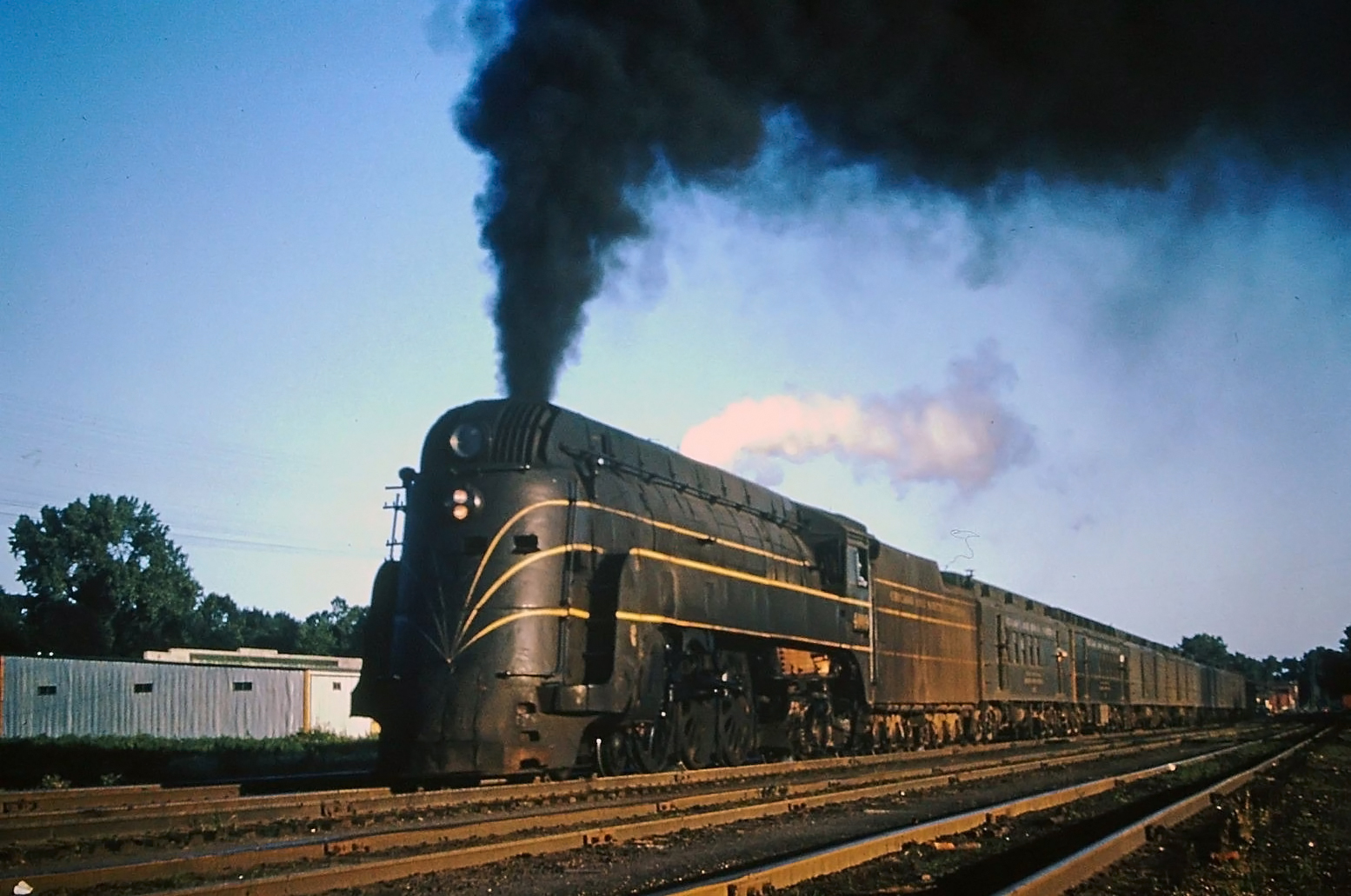 Chicago & North Western 4-6-4 #4009 (E-4) appears to have a mail train at Council Bluffs, Iowa on June 23, 1953. This locomotive was one of nine acquired from Alco in 1938 (#4001-4009) to handle the railroad's new streamliners. Externally, the beautiful steamers were almost identical to Milwaukee Road's famous F-7's. Originally built to burn coal they were converted to oil in 1946-47. Soon after this photo was taken the group was retired and scrapped.
Chicago & North Western 4-6-4 #4009 (E-4) appears to have a mail train at Council Bluffs, Iowa on June 23, 1953. This locomotive was one of nine acquired from Alco in 1938 (#4001-4009) to handle the railroad's new streamliners. Externally, the beautiful steamers were almost identical to Milwaukee Road's famous F-7's. Originally built to burn coal they were converted to oil in 1946-47. Soon after this photo was taken the group was retired and scrapped.Switchers
| Wheel Arrangement | Class | Road Number(s) | Quantity | Builder(s) | Completion Date | Retirement Date | Notes |
|---|---|---|---|---|---|---|---|
| 0-6-0 | M-1 | 1, 17, 37, 43, 45 | 5 | Baldwin | 1913 | - | ex-CStPM&O |
| 0-6-0 | M-1 | 3, 4, 9, 12, 1 8-21, 29-36 | 16 | Schenectady (Alco) | 1909-1912 | - | ex-CStPM&O |
| 0-6-0 | K | 8-1172 (not sequential) | - | Rhode Island | 1903 | - | - |
| 0-6-0 | F-6 | 13-16, 24-28 | 9 | Schenectady (Alco) | 1901-1907 | - | ex-CStPM&O |
| 0-6-0 | F-10 | 22-23 | 2 | Baldwin | 1902 | - | ex-CStPM&O |
| 0-6-0 | M-2 | 46-54 | 9 | Schenectady (Alco) | 1917 | - | ex-CStPM&O |
| 0-8-0 | M-5 | 60-67 | 8 | Baldwin | 1928 | - | ex-CStPM&O |
| 0-6-0 | M-3 | 75-82 | 8 | Richmond (Alco) | 1921 | - | ex-CStPM&O |
| 0-6-0 | M-3 | 83-86 | 4 | Schenectady (Alco) | 1919 | - | ex-CStPM&O |
| 0-6-0 | M | 837-856 | 20 | Schenectady (Alco) | 1900 | 1928-1935 | - |
| 0-6-0 | M-1 | 1-1052 (not sequential), 574-583, 1297-1317, 1428-1442, 1495-1499, 2000-2104 | - | Alco, Baldwin | 1905-1917 | - | - |
| 0-6-0 | M-2 | 2111-2185 | 75 | Schenectady (Alco), Brooks (Alco) | 1916-1923 | - | - |
| 0-6-0 | M-3 | 2601-2635 | - | Cooke (Alco), Schenectady (Alco) | 1919 | - | A USRA design. |
| 0-8-0 | M-4 | 2636-2643 | - | Richmond (Alco) | 1927 | - | - |
| 0-10-2 | J-1 | 491-492 | 2 | C&NW | 1944 | 1953, 1949 | Rebuilt from 2-10-2s. |
Freight Locomotives
| Wheel Arrangement | Class | Road Number(s) | Quantity | Builder(s) | Completion Date | Retirement Date | Notes |
|---|---|---|---|---|---|---|---|
| 2-8-0 | H-3 | 216-217 | 2 | Schenectady (Alco) | 1905 | - | ex-CStPM&O |
| 2-8-0 | Z | 218-219 | 2 | Schenectady (Alco) | 1913 | - | ex-CStPM&O |
| 2-6-0 | D-11 | 278 | 1 | Cooke (Alco) | 1915 | 1927 | ex-Chicago & Tomah Railroad (narrow-gauge) |
| 2-6-0 | D-11 | 279 | 1 | Schenectady (Alco) | 1912 | 1927 (sold) | ex-Chicago & Tomah Railroad (narrow-gauge) |
| 2-8-2 | J | 390-421 | 32 | Schenectady (Alco) | 1913-1916 | - | ex-CStPM&O |
| 2-8-2 | J | 440-441 | 2 | Schenectady (Alco) | 1916 | ex-CStPM&O. Later renumbered from C&NW #2363 and #2371. | |
| 2-8-2 | J-2 | 422-431 | 10 | Schenectady (Alco), Richmond (Alco) | 1919, 1921 | 1950-1954 | ex-CStPM&O. A USRA design. |
| 2-8-2 | J-3 | 432-439 | 8 | Schenectady (Alco) | 1926 | 1953-1956 | ex-CStPM&O |
| 4-8-0 | G | 477, 933 | 2 | Schenectady (Alco) | 1902 | 1928, 1925 | Built for the narrow gauge Fremont, Elkhorn & Missouri Valley Railroad as #211-212. |
| 2-10-2 | J-1 | 491, 492 | 2 | Baldwin | 1917 | - | ex-CStPM&O |
| 2-8-0 | Z | 1455-1494, 1700-1910 | 250 | Baldwin, Schenectady (Alco) | 1909-1913 | - | - |
| 2-8-2 | J | 2301-2600 | 300 | Alco | 1913-1923 | - | - |
| 2-8-2 | J | 2701-2710 | 10 | Brooks (Alco) | 1923 | - | This group utilized oil as their fuel source. |
| 2-8-4 | J-4 | 2801-2812 | 12 | Brooks (Alco) | 1927 | 1950-1953 | - |
Passenger Locomotives
| Wheel Arrangement | Class | Road Number(s) | Quantity | Builder(s) | Completion Date | Retirement Date | Notes |
|---|---|---|---|---|---|---|---|
| 4-6-2 | L | 9-1454 (not sequential) | 21 | Schenectady (Alco) | 1908-1910 | 1935 | - |
| 4-6-0 | R-1 | 18-1042 (not sequential), 1066-1079, 1125-1169, 1323-1428 | 325 | Schenectady (Alco), Baldwin | 1901-1908 | - | - |
| 4-6-2 | E-1 | 56-944 (not sequential), 2201-2226 | 41 | Schenectady (Alco) | 1910-1916 | - | - |
| 4-6-0 | J-1 | 101-106, 222-225, 302-304, 308-363 | 67 | Schenectady (Alco) | 1901-1910 | - | ex-CStPM&O |
| 4-4-2 | D | 152-895 (not sequential), 390-399, 1015-1030, 1080-1101, 1297-1317 | 91 | Schenectady (Alco) | 1900-1908 | - | - |
| 4-6-0 | F-2 | 188, 195, 197, 199, 202, 212, 234 | 7 | Schenectady (Alco) | 1921-1924 | - | ex-CStPM&O |
| 4-4-0 | F-1 | 220 | 1 | Schenectady (Alco) | 1923 | - | ex-CStPM&O |
| 4-4-2 | G-3 | 364-370 | 7 | Schenectady (Alco) | 1906 | - | ex-CStPM&O |
| 4-6-2 | I-2 | 371-387 | 17 | Schenectady (Alco) | 1903-1910 | - | ex-CStPM&O |
| 4-6-2 | K-2 | 388-389 | 2 | Schenectady (Alco) | 1911 | - | ex-CStPM&O |
| 4-6-0 | Q | 497-506, 556-565, 1323-1332 | 30 | Rogers (Alco) | 1906 | 1928-1931 | - |
| 4-6-2 | E | 500-517 | 18 | Schenectady (Alco) | 1913-1916 | - | ex-CStPM&O |
| 4-6-2 | E-3 | 600-602 | 3 | Schenectady (Alco) | 1930 | - | ex-CStPM&O |
| 4-6-0 | R | 857-886 | 30 | Schenectady (Alco) | 1900 | 1928-1937 | - |
| 4-6-0 | Q | 1191-1200 | 10 | Rhode Island (Alco) | 1903 | 1928-1931 | - |
| 4-6-2 | E | 1500-1667 | 168 | Schenectady (Alco), Brooks (Alco) | 1909-1923 | 1937-1956 | - |
| 4-6-2 | E-2 | 2901-2912 | 12 | Schenectady (Alco) | 1923 | 1954-1957 | - |
| 4-6-4 | E-4 | 4001-4009 | 9 | Alco | 1938 | 1953-1956 | Wearing a handsome olive green livery with yellow trim, these Hudsons were streamlined direct from Alco leading the railroad's '400' trains. |
Dual Service
| Wheel Arrangement | Class | Road Number(s) | Quantity | Builder(s) | Completion Date | Retirement Date | Notes |
|---|---|---|---|---|---|---|---|
| 4-8-4 | H | 3001-3035 | 35 | Baldwin | 1929 | 1950-1956 | - |
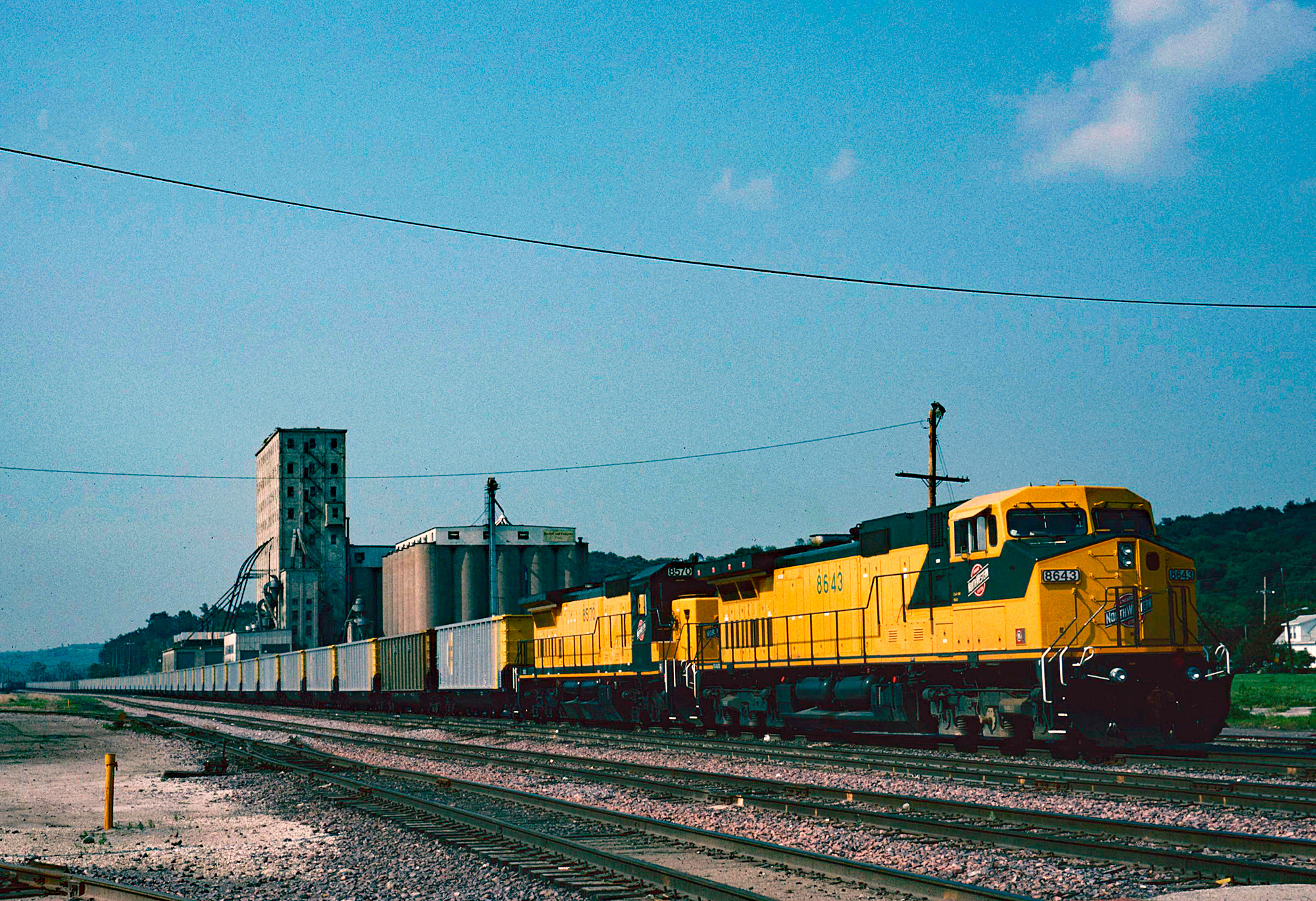 Chicago & North Western C44-9W #8643, delivered earlier that year, appears to be tied down with a westbound string of empty coal hoppers near Council Bluffs, Iowa on June 20, 1994. C.R. Faris photo. American-Rails.com collection.
Chicago & North Western C44-9W #8643, delivered earlier that year, appears to be tied down with a westbound string of empty coal hoppers near Council Bluffs, Iowa on June 20, 1994. C.R. Faris photo. American-Rails.com collection.Union Pacific
To sidestep this issue the C&NW worked with Union Pacific to build a new connector from the UP to the western end of the Cowboy Line.
As coal became an increasingly important business model the roads worked ever-closer together. In the meantime the C&NW continued shedding hundreds of miles through the early 1990's.
These efforts, according to Michael Blaszak's article, "Chicago & North Western: Evolution Of A Survivor," from the April, 1994 issue of Trains Magazine, reduced its network to just 4,323 route miles.
In a move that surprised few, Union Pacific acquired control of the Chicago & North Western during April of 1995.
The end of the North Western closed the book on one of America's most fascinating railroads, the classic granger.
While one can still witness the Heartland's agriculture industry served by trains names like the Milwaukee Road, Burlington, Rock Island, and Chicago & North Western have all disappeared through merger, liquidation, or buyout.
Today, C&NW's key routes carry on under the UP banner, especially its Powder River coal basin line. Union Pacific also paid homage to its predecessor by painting one of its new EMD SD70ACe locomotives in 2006 into a version of the railroad’s famous green and yellow company livery, given number 1995 after the year the railroad was acquired.
Public Timetables (August, 1952)
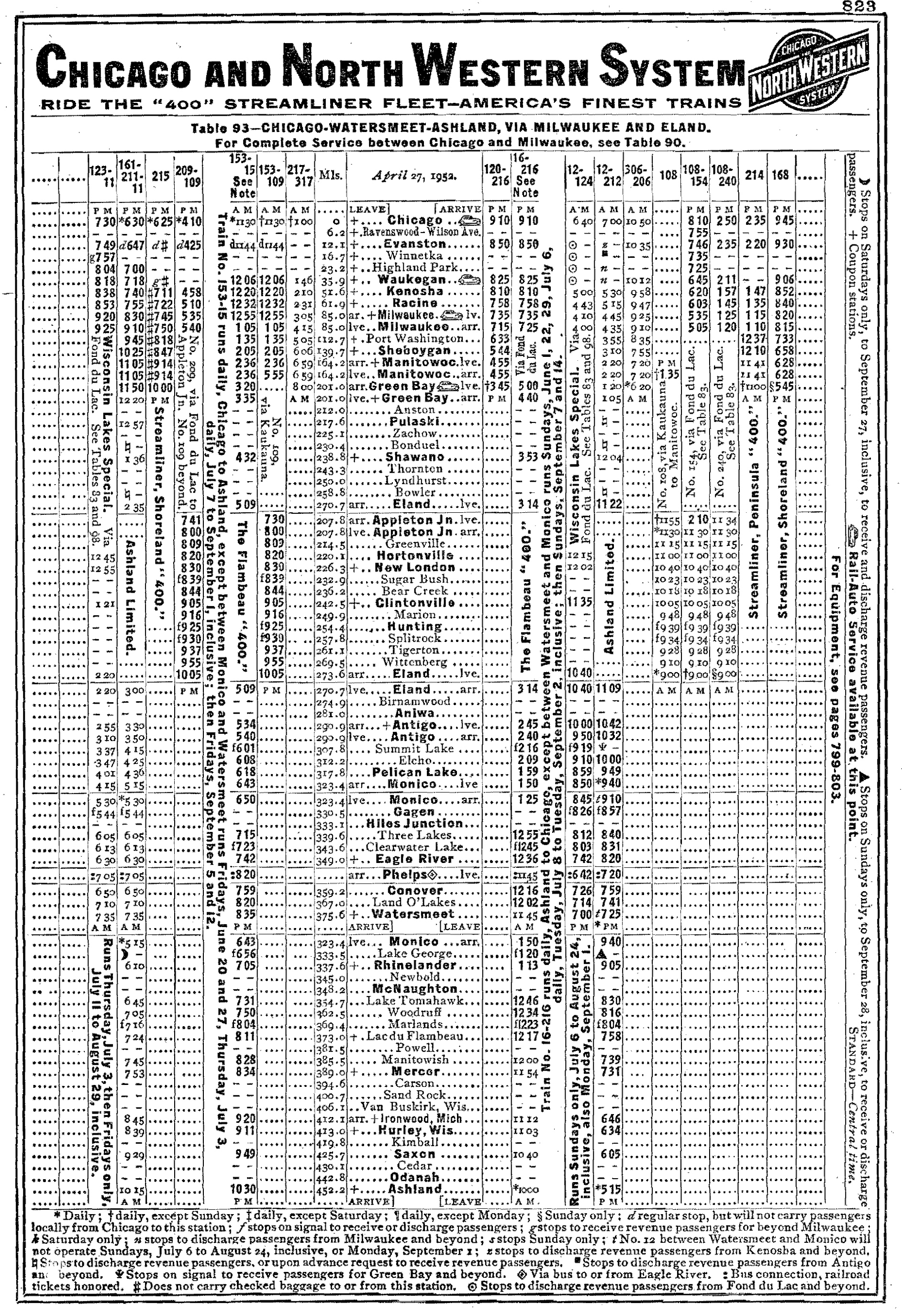
Recent Articles
-
Utah's 'Wine Tasting' Train Rides
Dec 17, 25 11:27 PM
Utah, a state widely celebrated for its breathtaking natural beauty and dramatic landscapes, is also gaining recognition for an unexpected yet delightful experience: wine tasting trains. -
New York Christmas Train Rides In Corinth!
Dec 17, 25 01:00 PM
Today, the Saratoga, Corinth & Hudson Railway combines historic equipment, hands-on craftsmanship, and immersive family experiences—including its increasingly popular holiday rides, the Candy Cane Exp… -
Pennsylvania Christmas Train Rides In Hollidaysburg!
Dec 17, 25 12:39 PM
Today, the Everett Railroad offers scenic excursions, hands-on steam experiences, and one of the state’s most popular Christmas trains: the Santa Express.

